
© Adrian Seliga/Getty Images

Medieval castles, cobblestone villages, captivating cities and golden beaches: the Portugal experience can be many things. History, great food and idyllic scenery are just the beginning.

Best Time to Visit
Best places to visit, leave the planning to a local expert.
Experience the real Portugal. Let a local expert handle the planning for you.
Attractions
Must-see attractions.
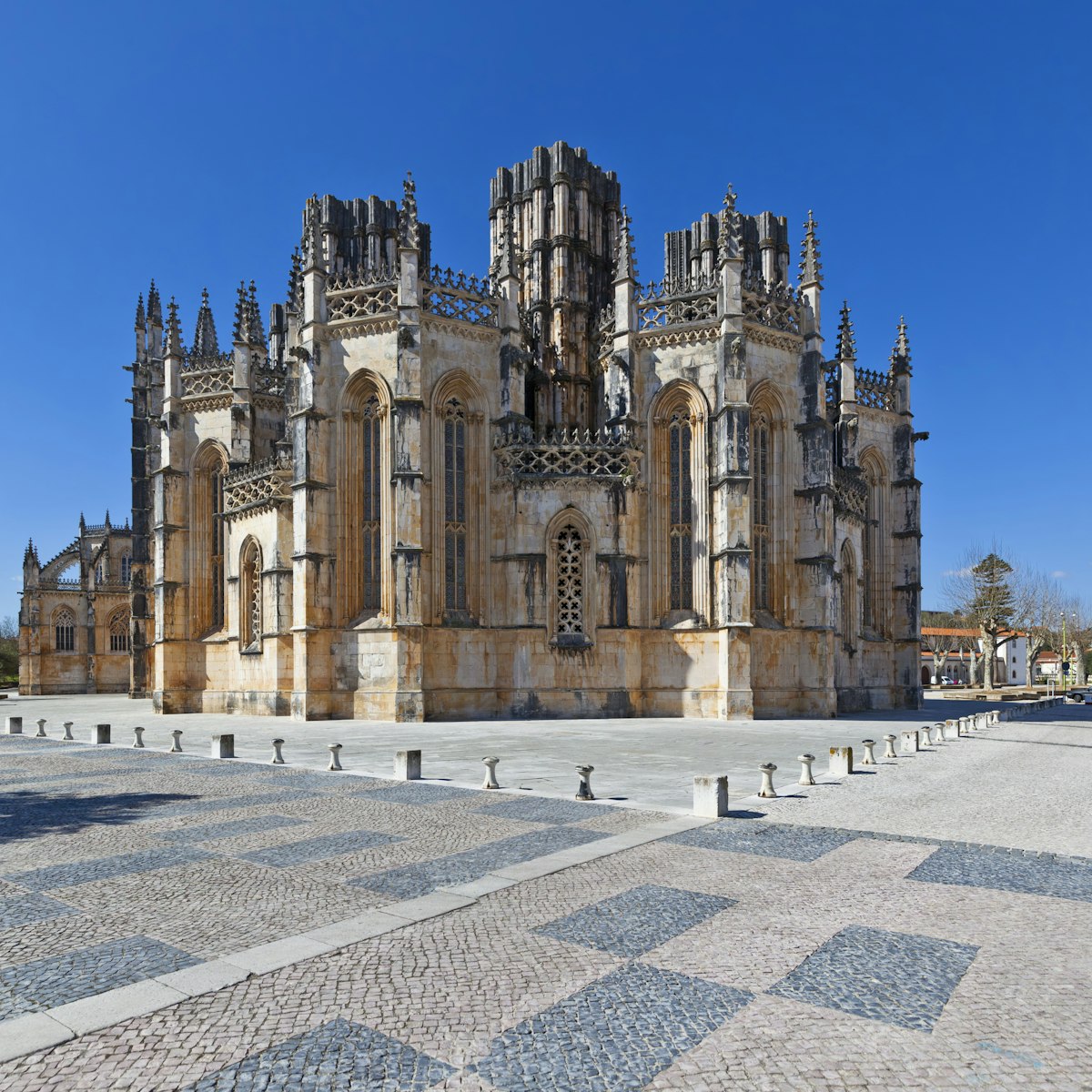
Mosteiro de Santa Maria da Vitória
Estremadura & Ribatejo
The extraordinary monastery of Batalha was built to commemorate the 1385 Battle of Aljubarrota (fought just south of here). Most of the monument was…
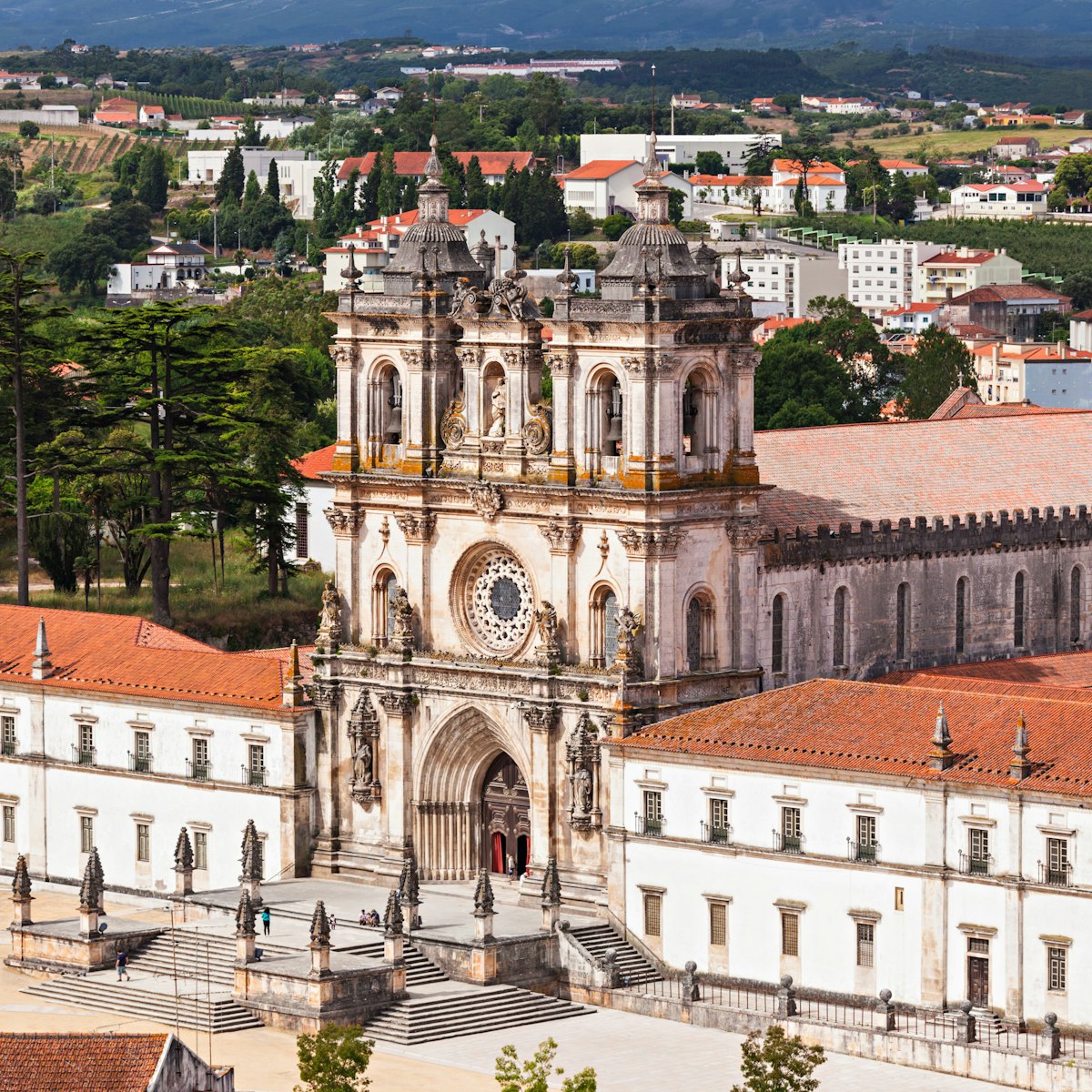
Mosteiro de Santa Maria de Alcobaça
One of Iberia's great monasteries utterly dominates the town of Alcobaça. Hiding behind the imposing baroque facade lies a high, austere, monkish church …
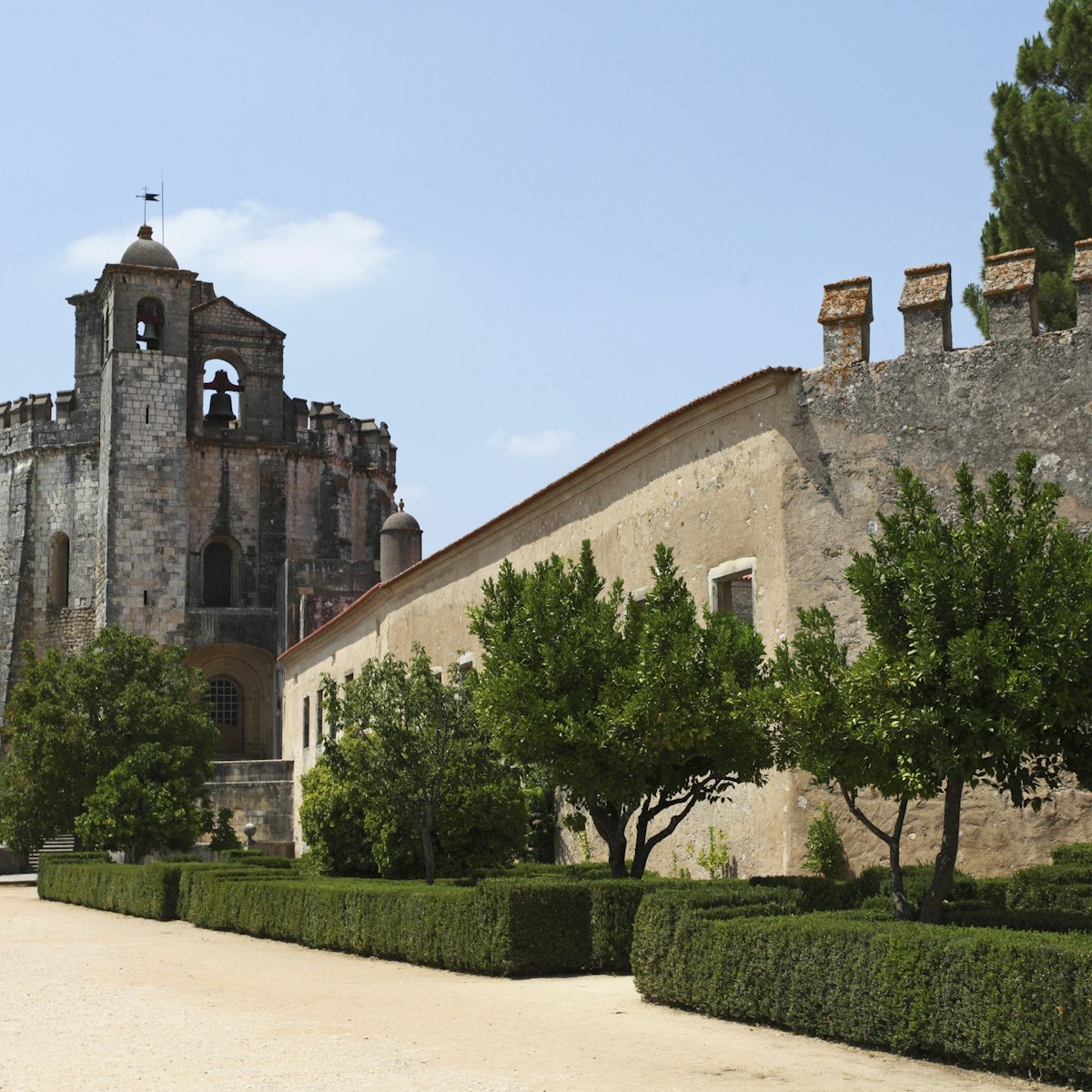
Convento de Cristo
Wrapped in splendour and mystery, the Knights Templar held enormous power in Portugal from the 12th to 16th centuries, and largely bankrolled the Age of…
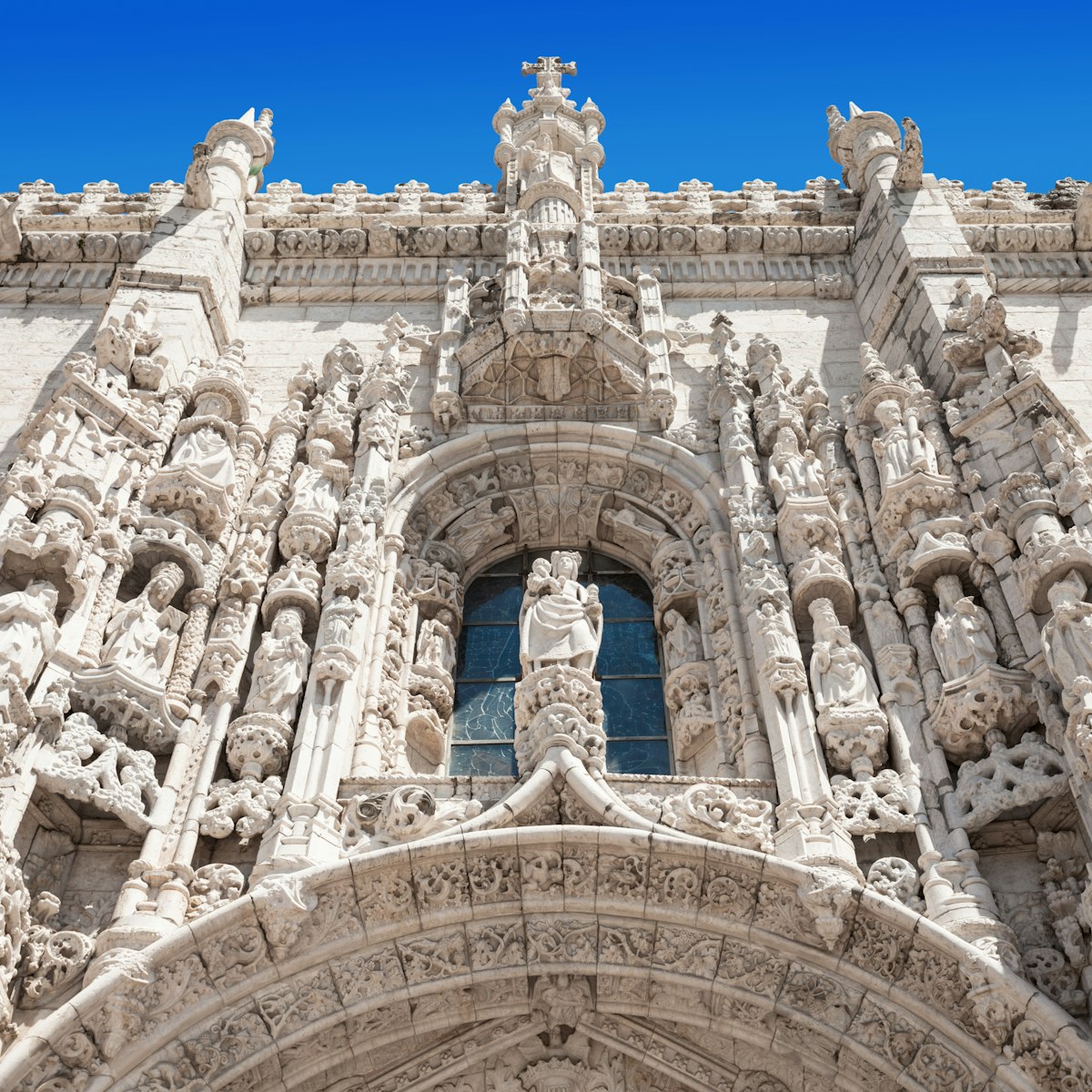
Mosteiro dos Jerónimos
Belém’s undisputed heart-stealer is this Unesco-listed monastery. The mosteiro is the stuff of pure fantasy: a fusion of Diogo de Boitaca’s creative…
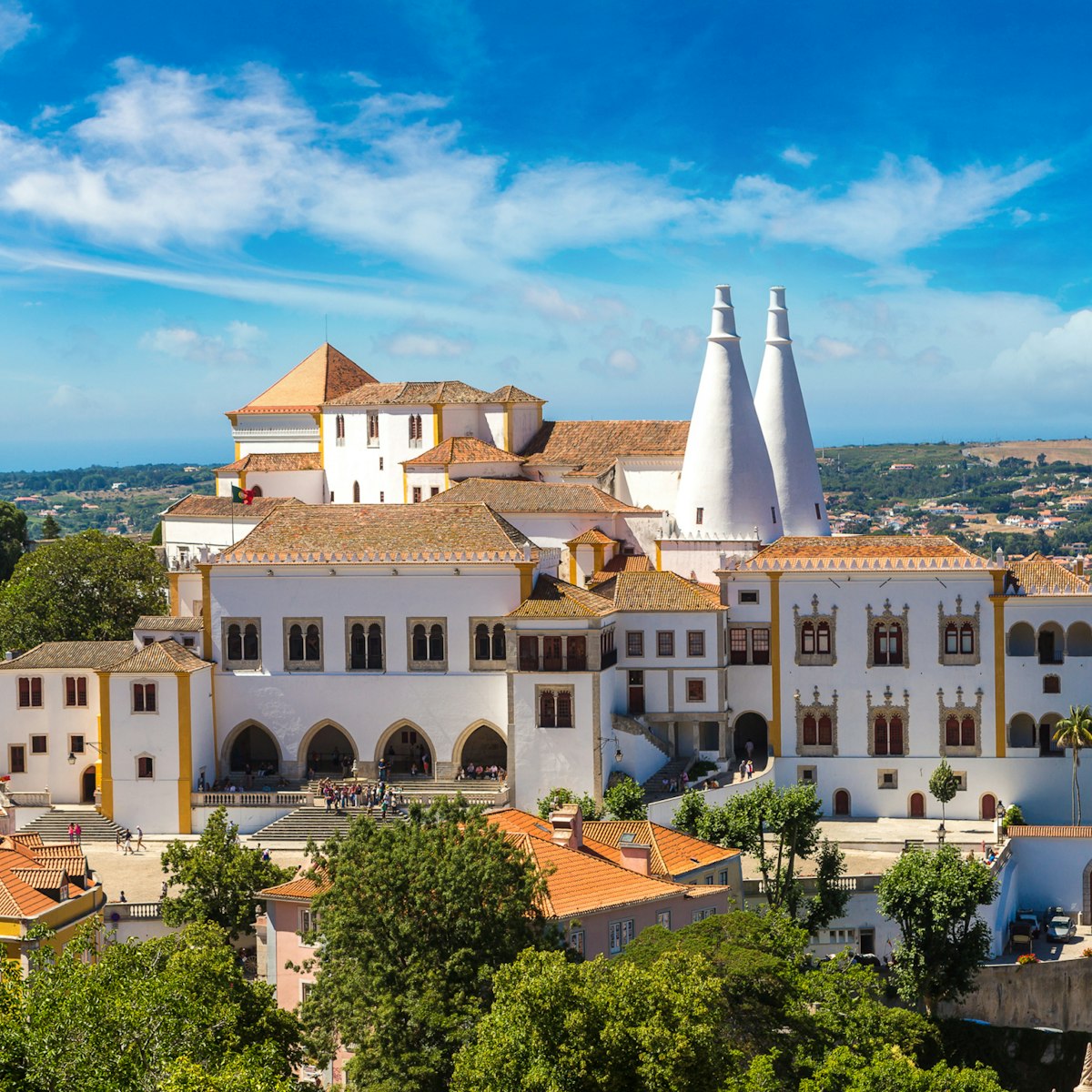
Palácio Nacional de Sintra
The star of Sintra-Vila is this palace, with its iconic twin conical chimneys and lavish, whimsical interior, which is a mix of Moorish and Manueline…
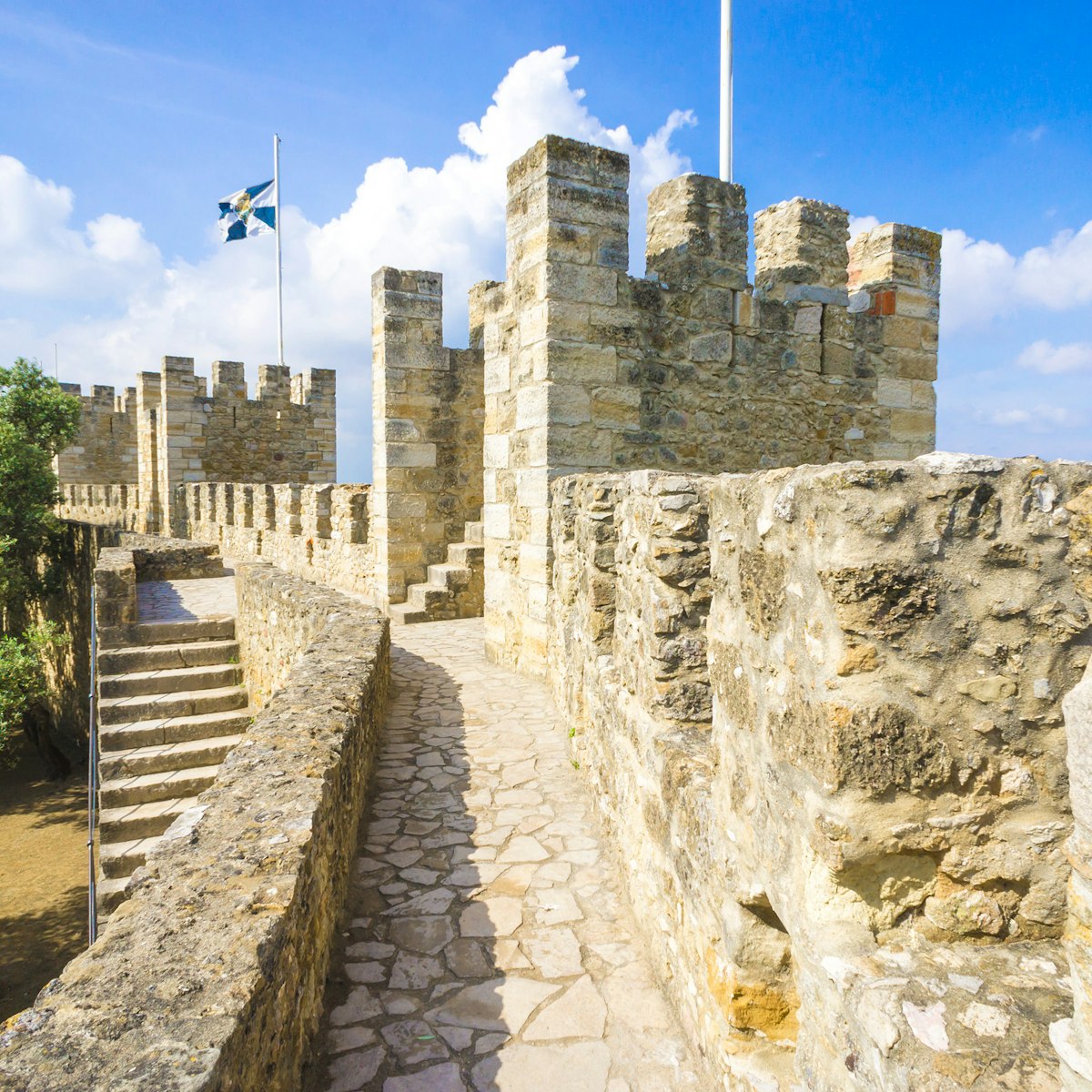
Castelo de São Jorge
Alfama, Castelo & Graça
Towering dramatically above Lisbon, these mid-11th-century hilltop fortifications sneak into almost every snapshot. Roam its snaking ramparts and pine…

Wander downhill (to save your legs) through Alfama's steep, narrow, cobblestoned streets and catch a glimpse of the more traditional side of Lisbon before…
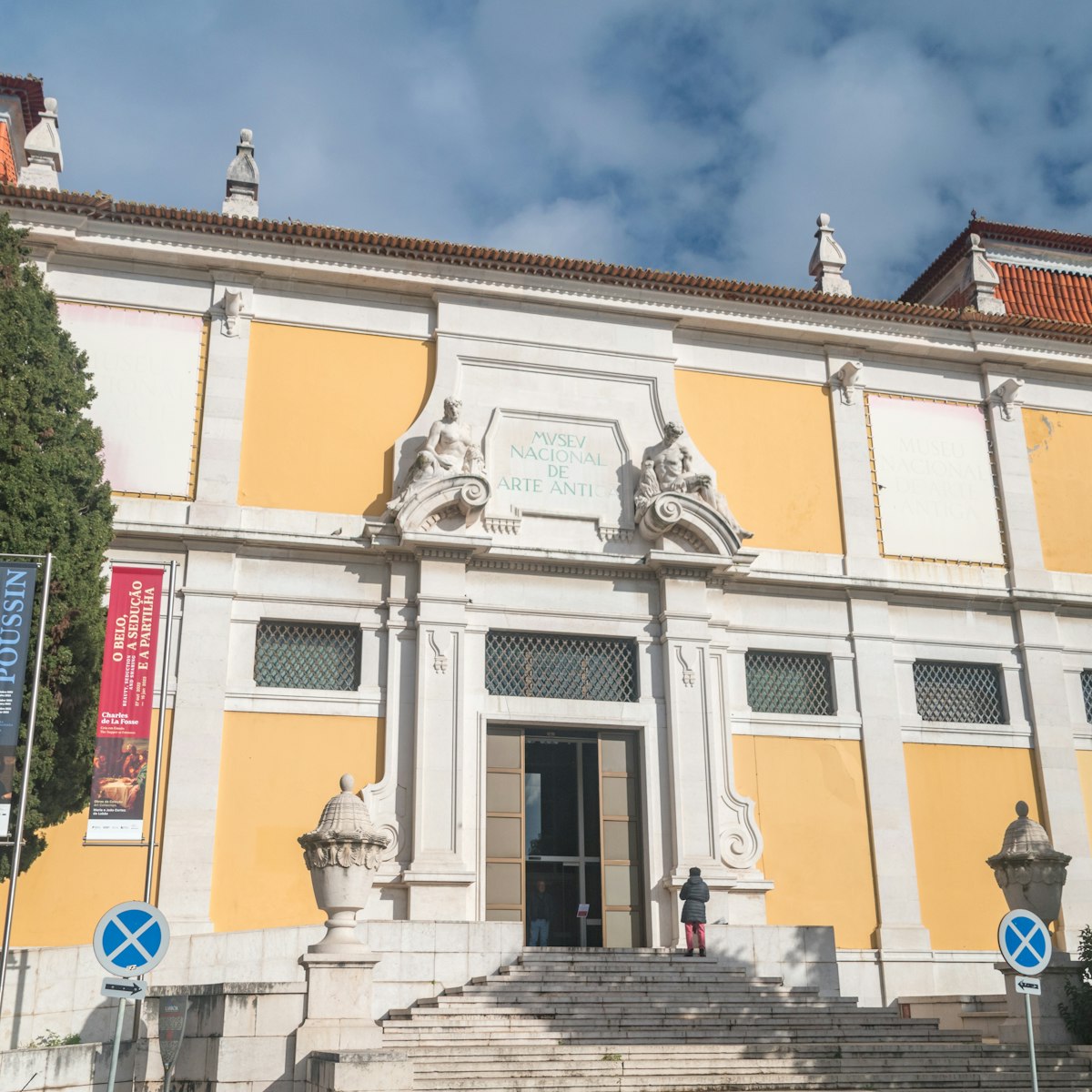
Museu Nacional de Arte Antiga
Set in a lemon-fronted, 17th-century palace, the Museu Nacional de Arte Antiga is Lapa’s biggest draw. It presents a star-studded collection of European…
Top picks from our travel experts
10 of the best things to do in portugal.

Observatório do Lago Alqueva
Offers two-hour open-air sessions taking in the marvellous star-filled skies of the Alentejo. You'll get an overview of constellations visible with the…
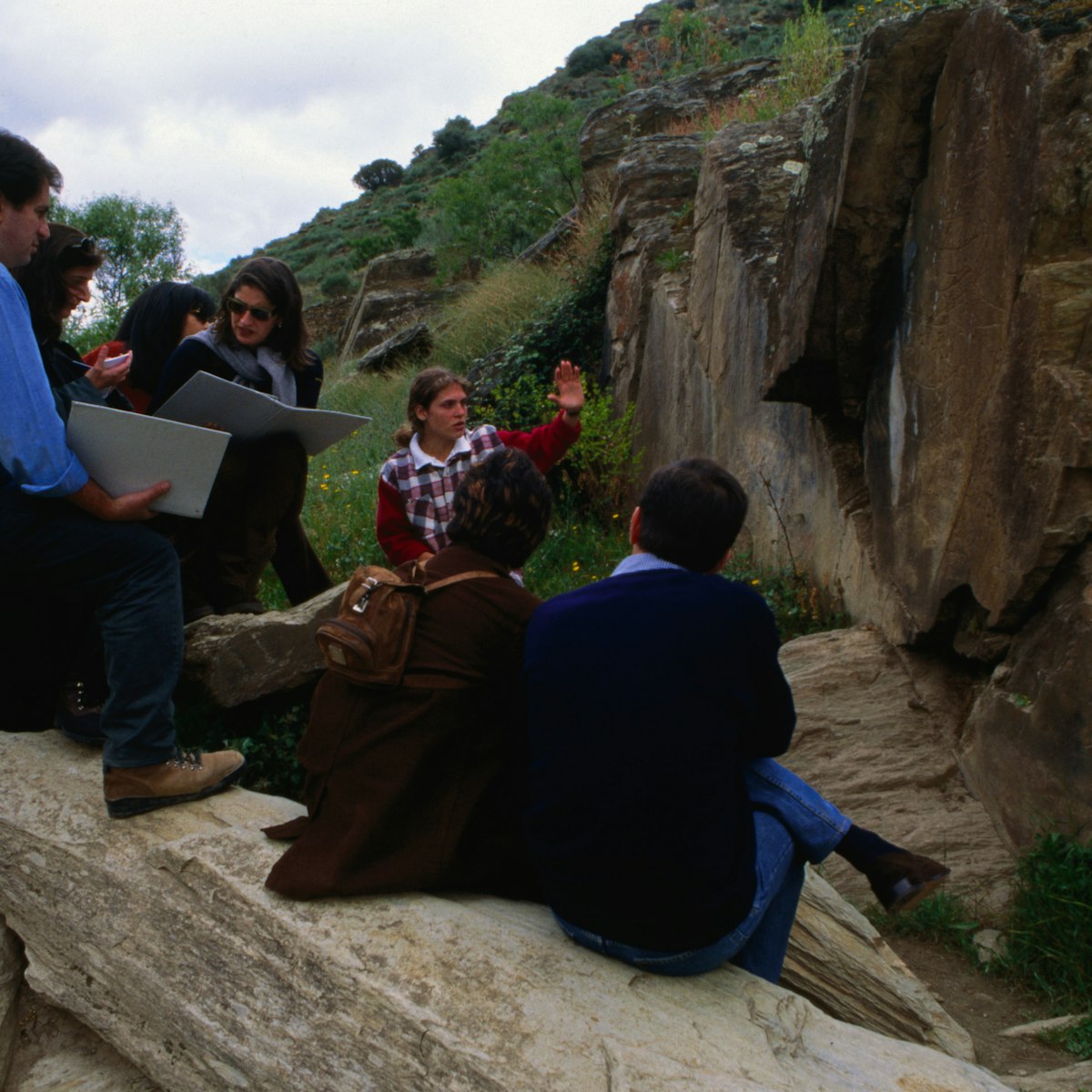
Parque Arqueológico do Vale do Côa
Most visitors to Vila Nova de Foz Côa come for one reason: to see its world-famous gallery of rock art. Although the park is currently an active research…
Planning Tools
Expert guidance to help you plan your trip.
Best Things to Do
From wine tasting to stargazing, experience the best of Portugal with this guide to the top things to do.
Things to Know
From what to wear to restaurants to the best way to get around, our Porto resident gives you the lowdown on things to know before you go to Portugal.
Transportation
From coastal train rides to DIY exploration with a hire car, here's how to get around Portugal.
Visa Requirements
All the info you need about getting a visa for Portugal, how long you can stay and the new visa-waiver program coming in 2024.
Money and Costs
From free museums to wonderful medieval architecture, it's possible to get by on as little as €50 a day in Portugal. Here's how.
Traveling with Kids
Children are welcomed everywhere you go in Portugal. Check out our top tips and the coolest experiences for your next family trip in Europe.
Best Road Trips
Throw together an Iberian soundtrack and you're ready to hit the open road in Portugal. Here are our top Portuguese road trips, from the hills to the coast.
Plan with a local
Experience the real Portugal
Let a local expert craft your dream trip.
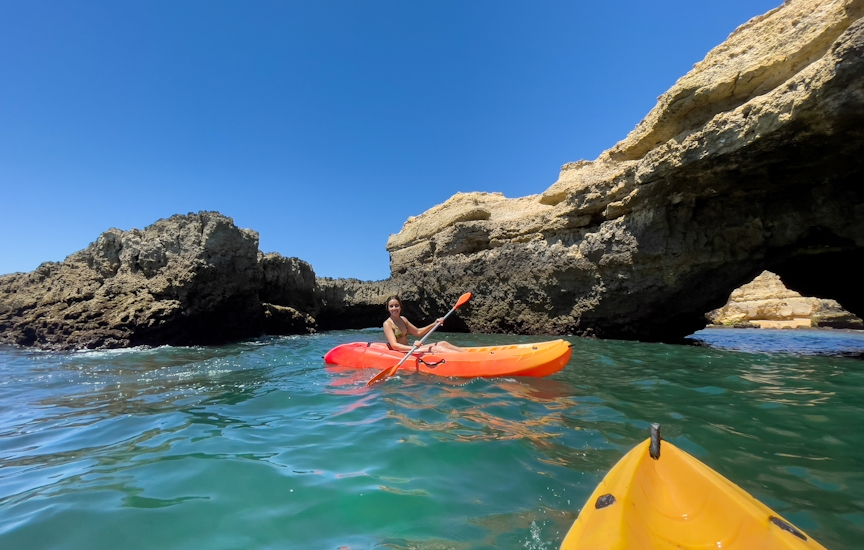
Latest stories from Portugal
Filter by interest:
- All Interests
- Adventure Travel
- Art & Culture
- Beaches, Coasts & Islands
- Food & Drink

Destination Practicalities
Feb 25, 2024 • 7 min read

Feb 23, 2024 • 6 min read

Jan 22, 2024 • 7 min read
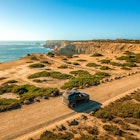
Dec 19, 2023 • 7 min read
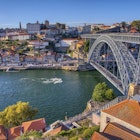
Dec 18, 2023 • 5 min read

Dec 4, 2023 • 6 min read

Nov 17, 2023 • 7 min read

Nov 17, 2023 • 5 min read

Oct 24, 2023 • 5 min read

Aug 15, 2023 • 5 min read
in partnership with getyourguide
Book popular activities in Portugal
Purchase our award-winning guidebooks.
Get to the heart of Portugal with one of our in-depth, award-winning guidebooks, covering maps, itineraries, and expert guidance.
Portugal and beyond
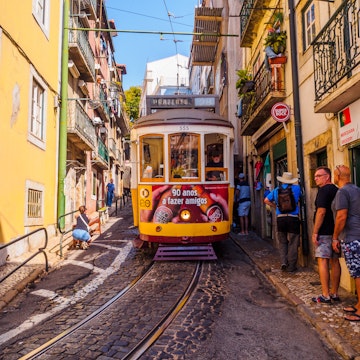
Explore Portugal
Plan your trip to portugal: best of portugal tourism.
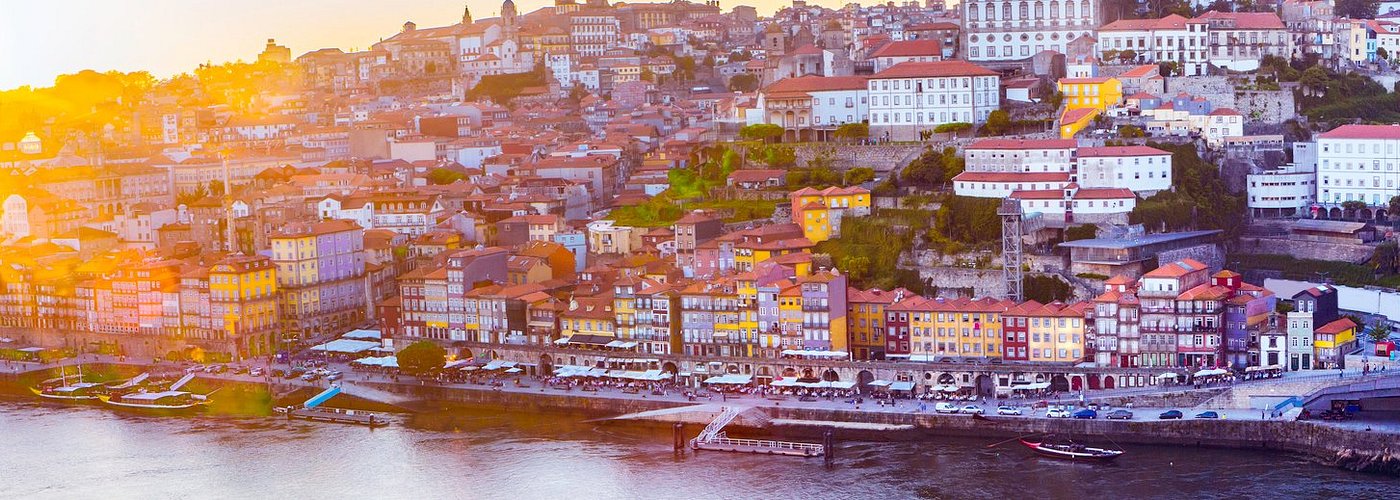
Essential Portugal
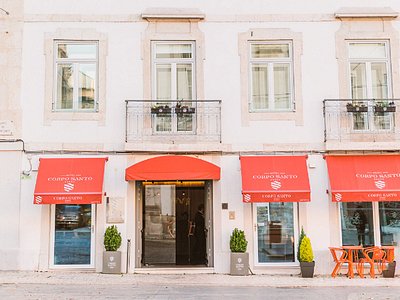
Trending in the forums
Portugal Is Great For
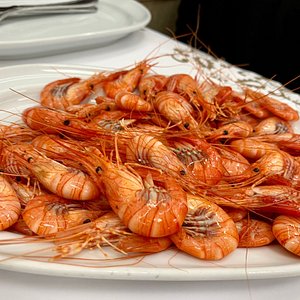
Art & history
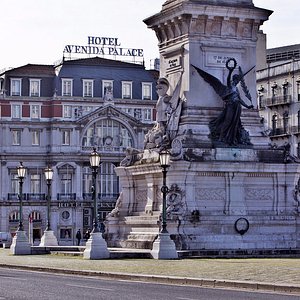
The great outdoors


25 Top-Rated Tourist Attractions in Portugal
Written by Paul Bernhardt Updated Mar 15, 2024
Visiting Portugal is to discover a remarkably diverse destination. Inextricably linked with the sea, the country has more than 800 kilometers of enticing Atlantic Ocean coastline. Lisbon, the capital city, enjoys a stunning location near the mouth of the River Tagus. From here, trailblazing mariners set sail in the 15th and 16th centuries on epic voyages of discovery, and Portugal has nurtured a proud seafaring tradition ever since.
Portugal's interior melds dramatic northern mountain ranges with the vast rolling plains of the country's sun-baked central regions. In the south, some of the best beaches in Europe flank picturesque coves and warm, shallow waters. Dotted throughout are stone-built villages, enchanting towns, and cosmopolitan cities where historic palaces and castles, museums, and monasteries are waiting to be explored.
And traveling to Portugal can also mean a visit to the verdant, subtropical island of Madeira - the "Garden Isle" - or the isolated, but tranquil Azores archipelago. For more ideas on the best places to visit, see our list of the top tourist attractions in Portugal.
1. Mosteiro dos Jerónimos, Lisbon
2. oceanário de lisboa, lisbon, 3. palácio nacional de sintra, lisbon coast, 4. kayaking the lisbon coast, 5. torre de belém, lisbon, 6. convento do cristo, tomar, 7. bom jesus do monte, braga, 8. hiking the gerês mountain range, 9. universidade de coimbra, 10. museu calouste gulbenkian, lisbon, 11. castelo de guimarães, 12. torre de clérigos, oporto, 13. castelo de são jorge, lisbon, 14. sé (cathedral) and roman temple, évora, 15. mosteiro pálacio nacional de mafra, 16. igreja de santo antónio and the museu municipal, lagos, 17. silves castle, 18. cross-border zipline, alcoutim, 19. palácio da bolsa, oporto, 20. alcobaça, 21. paiva walkways (passadiços do paiva), arouca, 22. côa valley archaeological park (parque arqueológico do vale do côa), vila nova de foz côa, 23. alentejo by horseback, 24. cabo da roca, other must-see highlights of portugal.
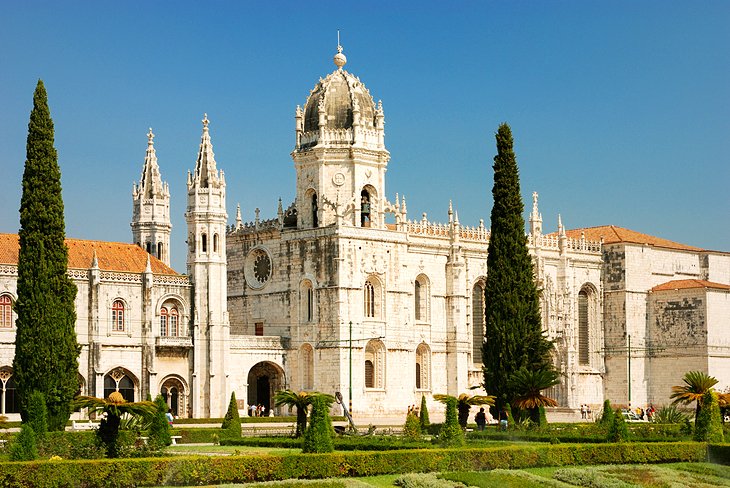
Belém is synonymous with Portugal's golden Age of Discovery . It's from the shores of this Lisbon suburb that intrepid navigators set sail in the 15th and 16th centuries on long and perilous voyages to chart unknown waters and map new territories.
One such mariner, Vasco da Gama, discovered the sea route to India in 1498, and to honor his achievement, King Manuel I commissioned a monument that became a lasting symbol of the country's astonishing era of conquest and expansion. Today, the Mosteiro dos Jerónimos is one of the country's most cherished and revered buildings, and is a must-see on every tourist's agenda.
The church and monastery embody the spirit of the age, and feature some of the finest examples of Manueline architecture found anywhere in Portugal; the beautifully embellished decoration found on the South Portal is breathtaking.
Inside, the beautiful cloister is equally exuberant. Appropriately, the church houses the tomb of Vasco da Gama and other national figureheads, including Luís de Camões, Portugal's greatest poet and chronicler of the discoveries.
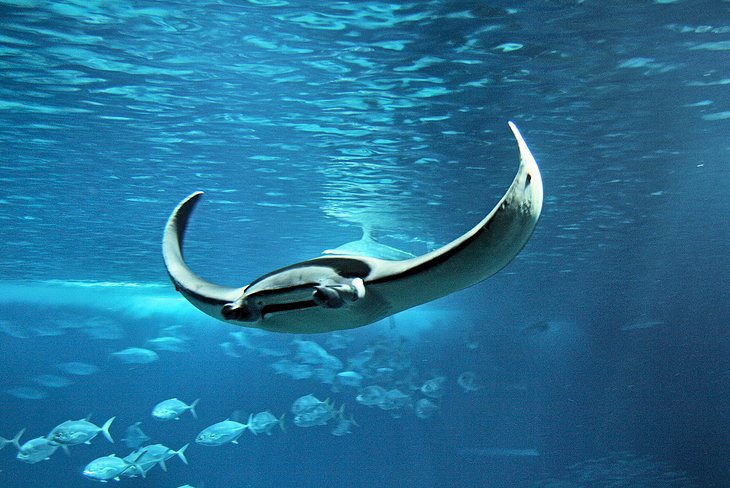
Arguably Portugal's most popular and family-friendly visitor attraction, Lisbon's oceanarium is brilliantly conceived to highlight the world's diverse ocean habitats. This is one of Europe's best and largest oceanariums , containing a vast array of fish and marine animals.
Four separate sea- and landscapes recreate the ecosystems of the Atlantic, Pacific, Indian, and Antarctic oceans. A huge central tank, visible from different levels, teems with shark, ray, and many other finned wonders and denizens of the deep. The transparent plexiglass design is such that smaller tropical species housed in separate aquaria set around the main tank appear to be swimming with their larger cousins.
Complementing this amazing spectacle are the open-air landscapes, where penguins, sea otters, and other cute and cuddly birds and mammals co-exist in carefree harmony.
- Top-Rated Tourist Attractions in Lisbon
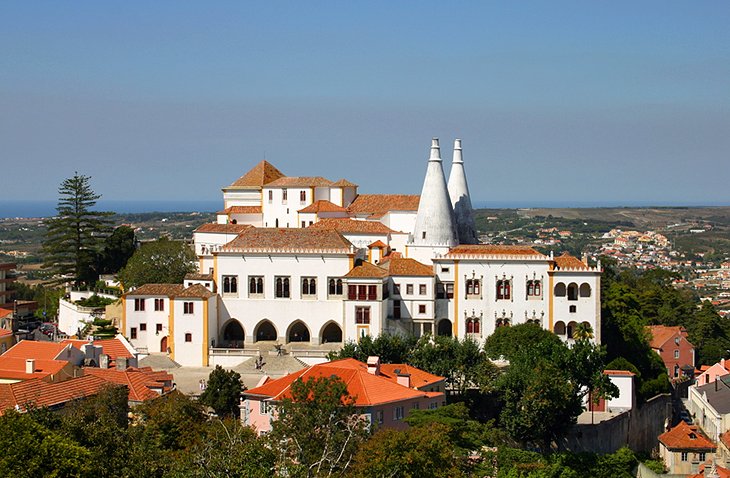
Nestling in the lap of a wooded mountain range, Sintra's stunning location is reason enough to visit this charming, verdant town. Indeed, UNESCO acknowledges the destination as a World Heritage cultural landscape such is its beauty and the significance of the collection of historic visitor attractions clustered in and around the old town, Sintra Velha .
A favorite summer retreat for the kings and queens of Portugal and an alluring destination for numerous writers and poets, including Lord Byron and William Beckford, Sintra exudes romance. The old town is a maze of cobbled lanes lined with handsome town houses painted in pastel hues of pink, mustard, and lilac. The narrow streets surround a pretty central square that's dominated by the wonderful Palácio Nacional de Sintra .
Easily recognized by its huge conical chimneys, Sintra's National Palace dates from the late 14th century and is the oldest surviving palace in Portugal. Regally furnished, the building is set over several floors, many conveying a unique theme and decorated accordingly. A highlight is the magnificent Sala dos Brasões , a glittering domed hall embellished with the coats of arms of 72 noble Portuguese families.
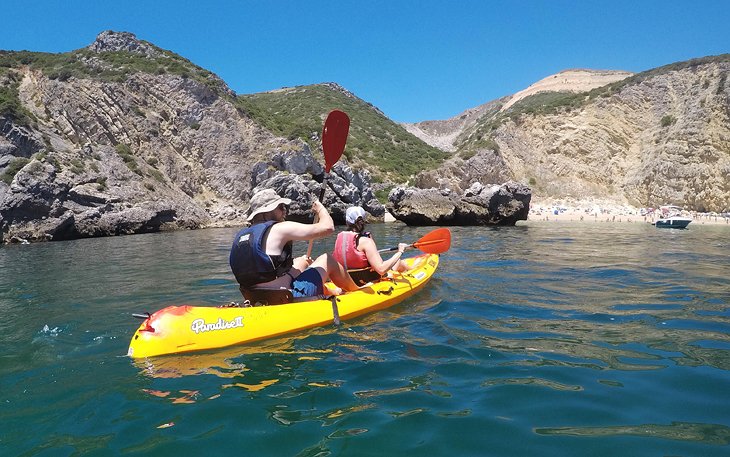
Taking to the sea by kayak to explore the Lisbon coast makes for a rewarding maritime excursion. Besides offering an extra dimension to the sightseeing experience, paddling the coastline provides an excellent excuse to exercise in a salt-laced, pristine environment.
Indeed, Lisbon's proximity to the ocean allows for a wide range of exciting water sports, and discovering the beaches, bays, and coves set along the region between the Portuguese capital and the resort town of Cascais is a fun-packed way to enjoy a day out.
Beyond the area, the crystal-clear waters off the Serra da Arrábida Natural Park , which encompass places like Setubal and Sesimbra , comprise a unique landscape of magnificent, ancient sea cliffs that teem with birdlife.
Most of the coastline here lies within a protected marine reserve - a sanctuary that includes within its boundaries the wonderfully picturesque Ribeira do Cavalo beach.
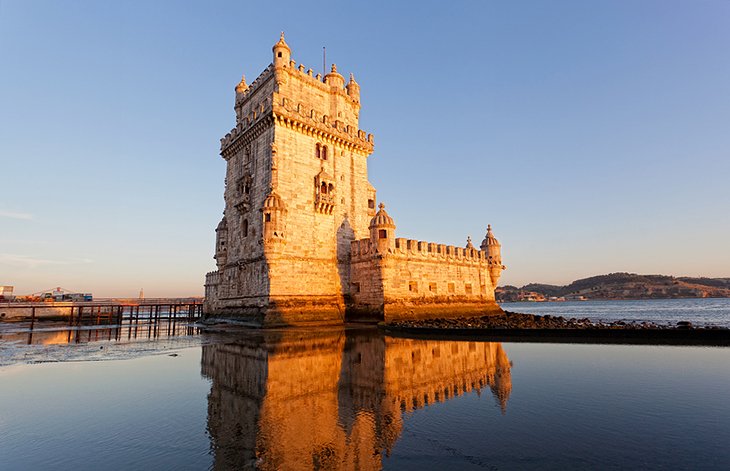
One of Portugal's best-loved historic monuments and a Lisbon icon, the Torre de Belém stands as a symbol of the Age of Discovery and the voyages of exploration undertaken in the 15th and 16th centuries.
Completed in 1521 as a fortress to defend the approaches to the River Tagus, the tower is regarded as a masterpiece of military architecture. Designed in the Manueline style by Francisco de Arruda, the façade is a confection of beautifully carved stone, typified by maritime motifs, such as twisted rope and the armillary sphere. An impressive Renaissance loggia heightens the decoration.
The tower's cultural significance is such that UNESCO has listed it as a World Heritage Site.
- Visiting Torre de Belém: Top Attractions, Tips & Tours
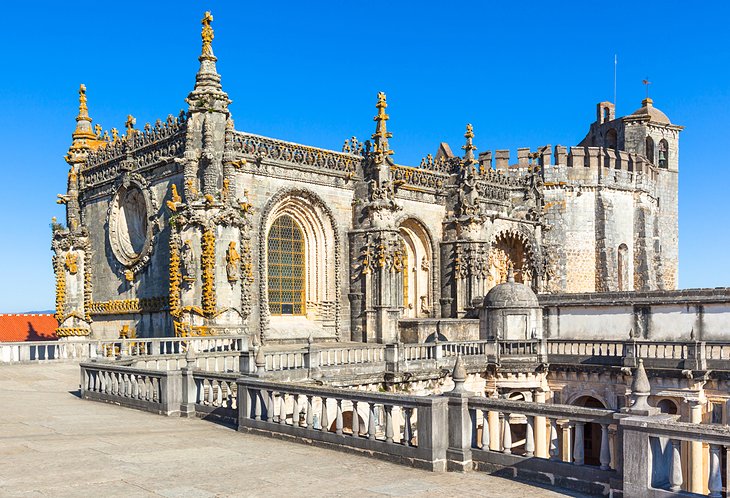
Dominating the charming riverside town of Tomar is a mighty castle that shields the Convento do Cristo , one of Portugal's standout historic attractions.
Founded in 1160 as the headquarters of the Order of the Knights Templar, the Convent of Christ is as awe-inspiring as it is mysterious, its masonic heritage tangible and beguiling. At its center is the medieval Charola , the original Templar church, richly decorated and exuding all the strange symbolism associated with the Order of Christ.
The 16th-century cloisters bewitch with Manueline flourishes and tease visitors with their concealed spiral staircases. And the convent's magnificent Manueline window , designed by master sculptor Diogo de Arruda, remains one of the most architecturally appealing aspects of any building found in Portugal.
- Top-Rated Tourist Attractions in Tomar & Easy Day Trips
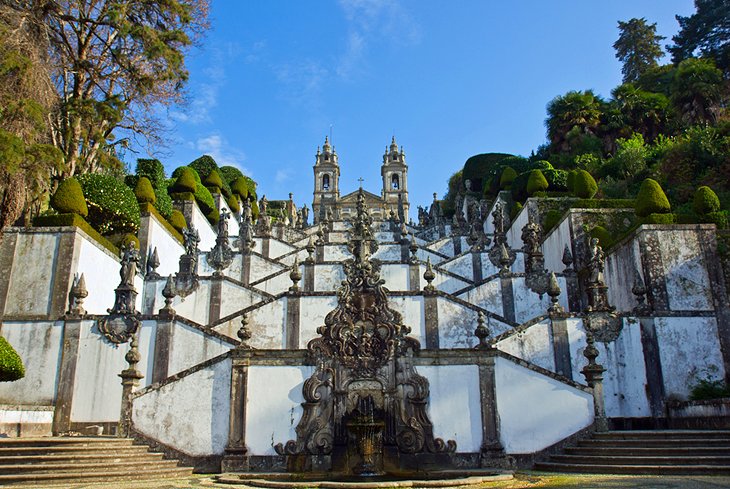
Bom Jesus do Monte , Portugal's grandest religious sanctuary, is located on a wooded slope six kilometers east of Braga and is one of the most important pilgrimage sites in the country.
Comprising a monumental Baroque Escadaria (stairway) and the church of Bom Jesus, this spectacular complex also features several chapels adorned with sculptured scenes from the Passion of Christ; fountains positioned at various points on the long ascent; and statues of biblical, mythological, and symbolic figures.
Climbing the lower section of the 116-meter-long ornamental granite staircase is to slowly zig-zag past a steep Sacred Way, with chapels showing the 14 Stations of the Cross.
Midway, the white, interleaved Escadório dos Cinco Sentidos depicts the five senses by way of finely carved statuary.
The final section is the Staircase of the Three Virtues, representing Faith, Hope, and Charity, that leads to the church. Your efforts will be rewarded with an inspiring panorama of the surrounding countryside. For the less active, a vintage 1882 funicular whisks visitors to the top in just three minutes.
- Read More: Top Tourist Attractions in Braga & Easy Day Trips
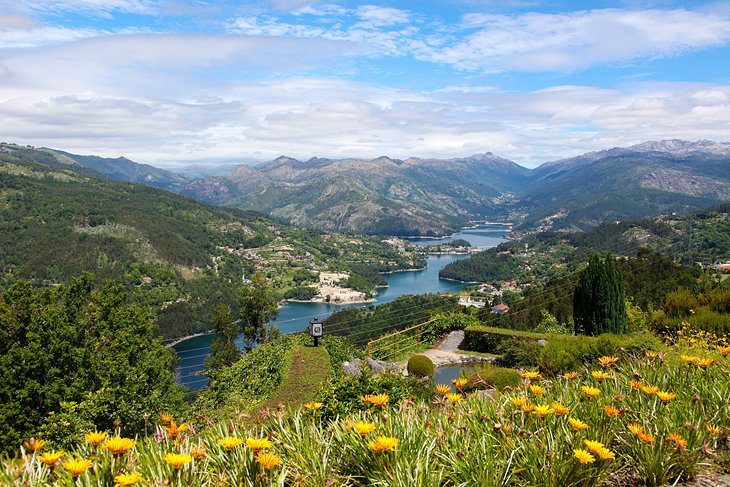
The Serra do Gerês is a mountain range of breathtaking beauty found in northern Portugal's remote Minho region. Set within the glorious Parque Nacional da Peneda-Gerês, one of the top places to visit in Portugal , the granite peaks that define the character of this vast national park number among the highest and most spectacular in the country.
As one of Portugal's greatest natural attractions, the Gerês Mountains draw walkers, hikers, and lovers of the outdoors to one of Europe's last great wildernesses, a stark and rugged landscape noted for its lush valleys dotted with shimmering lakes, a scattering of traditional villages, rare flora and fauna, and a way of life that has all but disappeared from the rest of the country's mountain regions.
The area is crisscrossed by ancient granite trails, which are signposted for hikers to follow, either as a short stroll or a challenging day trek. Most of the tracks are 10 to 16 kilometers in length and of varying grades.
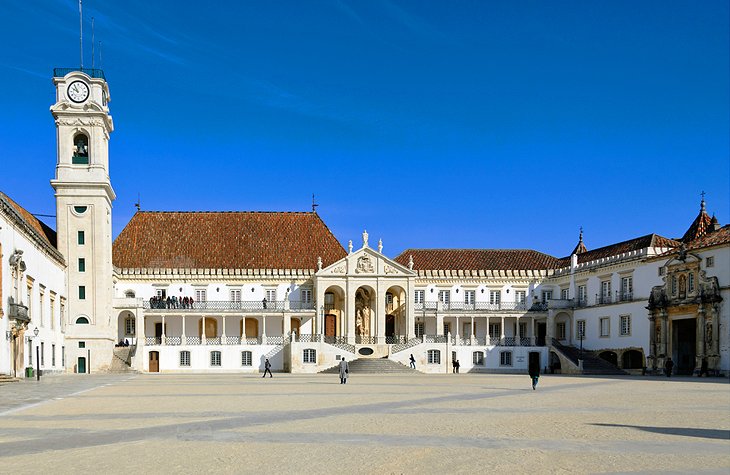
The Universidade de Coimbra is Portugal's oldest seat of learning, founded in 1290 by King Dinis. Acknowledged by UNESCO as a World Heritage Site , the historic buildings of the Velha Universidade , or old Coimbra University, surround a beautiful colonnaded central square, the Paço das Escolas.
The Alta and Sofia wings of the university - a former royal residence - reward visitors with a number of star features, including the astonishing Biblioteca Joanina , a sumptuously decorated library installed in 1717 by King João V.
A tour also takes in the dazzlingly ornate 16th-century Capela de São Miguel . Those with a head for heights can climb the landmark 18th-century clock tower for a grand perspective over Coimbra, one of the country's most attractive cities.
- Top Tourist Attractions in Coimbra & Easy Day Trips
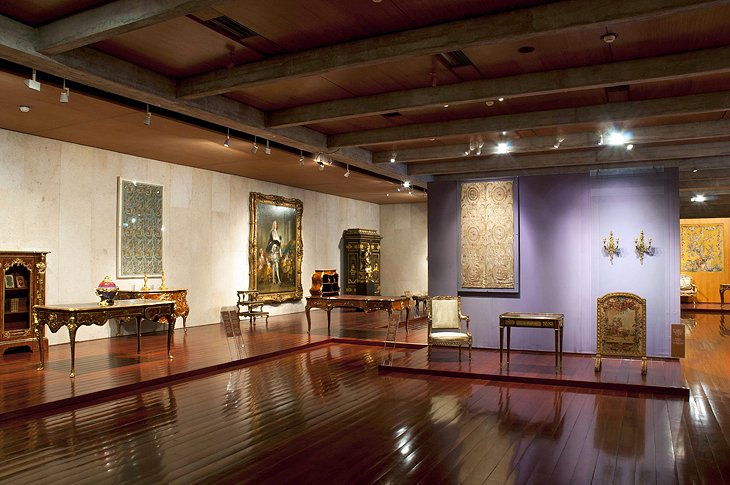
Lisbon is blessed with some truly world-class museums, and one of the finest is the Museu Calouste Gulbenkian . The museum's collection numbers some 6,000 pieces, all of which belonged to just one man: Calouste Sarkis Gulbenkian, a wealthy Armenian oil magnate who bequeathed his priceless hoard to the Portuguese nation upon his death in 1955.
Quite simply, this is one of the finest collections of art in Europe . The exhibits span more than 4,000 years from classical and oriental Antiquity to European art of the early 20th century . No other museum has such varied pieces of art from so many places in the world, and visitors can spend hours mulling over treasures such as the 11 Roman medallions found in Egypt; 16th-century illustrated manuscripts; masterpieces by Rubens, Rembrandt, and Turner; Louis XV and Louis XVI furniture; and Art Nouveau jewelry made by Rene Lalique.
The museum lies in beautiful lush gardens that are perfect for picnics, especially during the summer months.
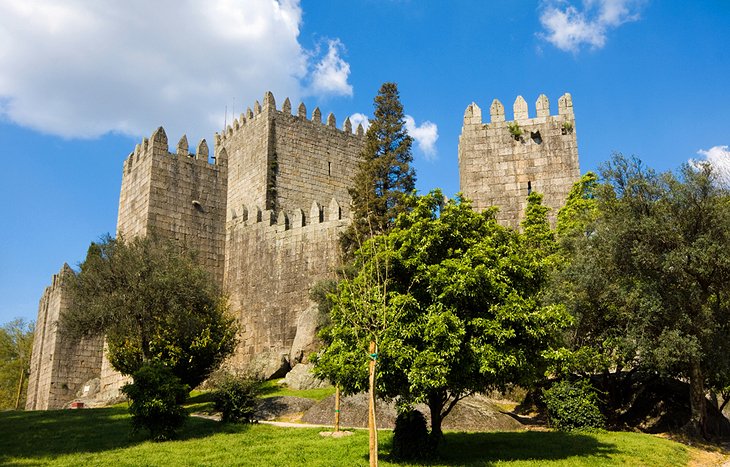
The birthplace of the nation and where Portugal's first monarch, Dom Afonso Henriques, was born in 1110, Guimarães was once the capital of the kingdom of "Portucale."
Recognized by UNESCO as a World Heritage Site for its collection of historic monuments grouped in and around the old town center, it is the Castelo de Guimarães that best symbolizes the role played by the town in defining the nation's culture and tradition - it even appears on the Portuguese coat of arms.
Originally built in the 10th century, but substantially extended by Henry of Burgundy two centuries later, the stronghold, on an elevated outcrop of granite, comprises a central keep - the Torre de Menagem - surrounded by massive battlements and fortified towers.
Dom Afonso was baptized in the tiny Romanesque chapel of São Miguel , located just outside the castle walls, and visitors can peek inside the diminutive space to see the font. A walk along the ramparts is inspiring, but for the best views, climb the keep.
- Top-Rated Tourist Attractions in Guimarães
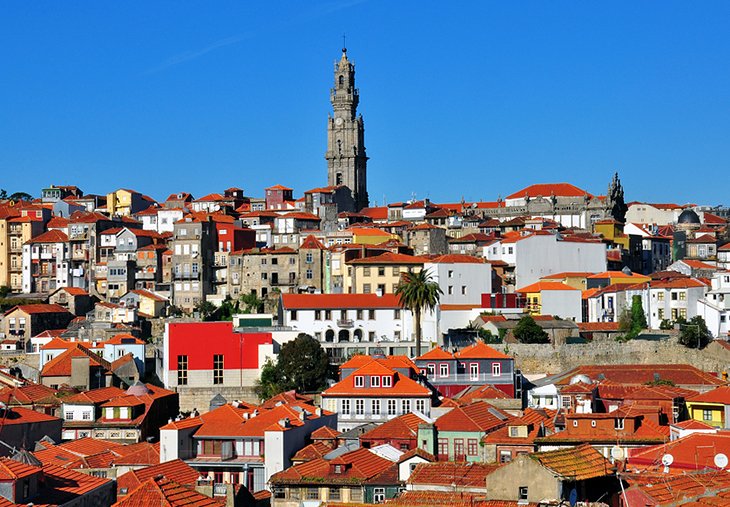
The spindly, needle-like Torre de Clérigos is one of Oporto's defining landmarks. Standing 75 meters above the streets and overlooking the old town, this slender tower was built in the 18th century by Nicolau Nasoni and exudes a bold sense of the Baroque. Designed as part of the Igreja dos Clérigos, the tower was completed in 1763 and at the time was the tallest building in Oporto.
To reach the top, visitors need to climb upwards of 200 steps, but the huffing and puffing will all be forgotten as you embrace truly magnificent views of the city and the River Douro.
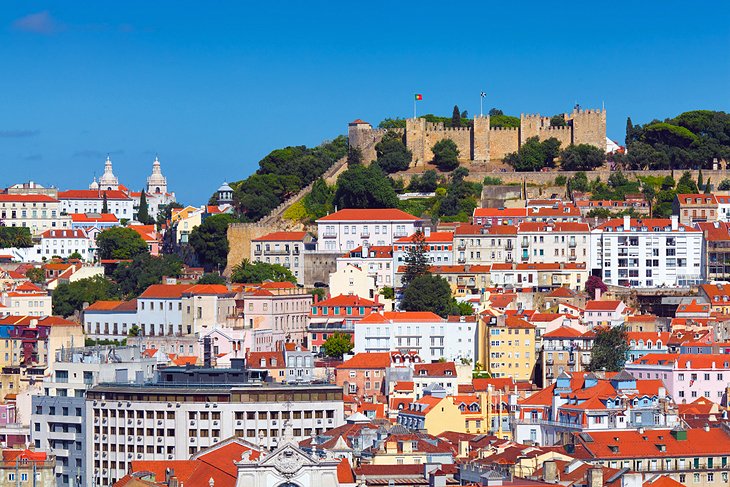
Its commanding position crowning a hill and overlooking Lisbon's bustling Baixa (downtown) district defines Castelo de São Jorge as the city's most visible historic monument. Hugely popular with locals and tourists alike, the foundations of this impressive castle date from the late 12th century when King Afonso Henriques recaptured the city from the Moors and built a palace over the ruins of their hilltop citadel.
In 1511, the royal residence was extended and reinforced with sturdy battlements. The great earthquake of 1755 leveled much of the structure, and what remains today is largely the result of substantial renovation.
Exploring the castle is great fun. Visitors can walk the ramparts and the castellated towers, one of which, Torre de Ulisses, has a camera obscura that projects views of the city onto the inside walls. The walls enclose an archaeological site with the remains of the original Alcáçova palace and ancient Moorish foundations.
The observation terrace near the entrance affords the most spectacular views across Lisbon and the river.
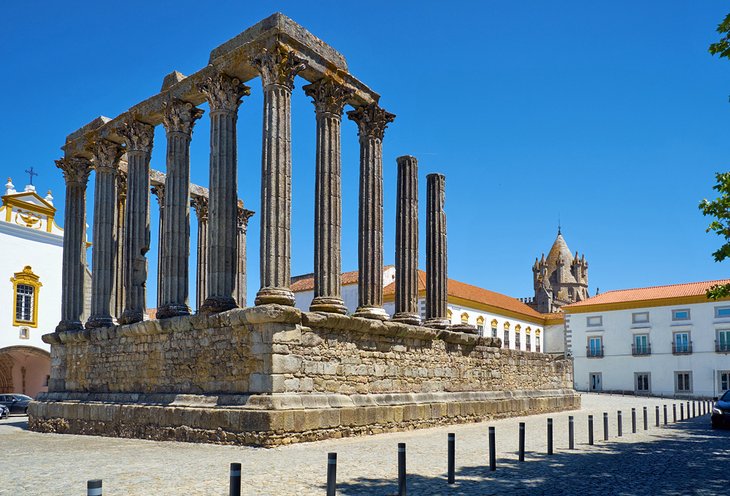
Set deep in southern Portugal's sun baked Alentejo province is Évora, one of the country's most enchanting cities. The Romans established themselves here in 57 BC, but it was under Moorish rule that the town began to take shape, its maze of narrow lanes and alleys typical of Islamic urban design. Christian reconquest saw the construction of the Sé , Évora's impressive cathedral and one of several stunning visitor attractions in the old town.
Consecrated in 1204, this celebrated religious building melds the Romanesque with the Gothic and the Baroque, and after admiring the interior, visitors can nip up to the roof, which offers fantastic views over the vicinity.
Nearby is Évora's most iconic monument, the Roman Temple . Erected in the 2nd or 3rd century AD, this is the most impressive Roman building in the country. In fact, Évora's historic legacy is such that UNESCO has declared the destination a World Heritage Site .
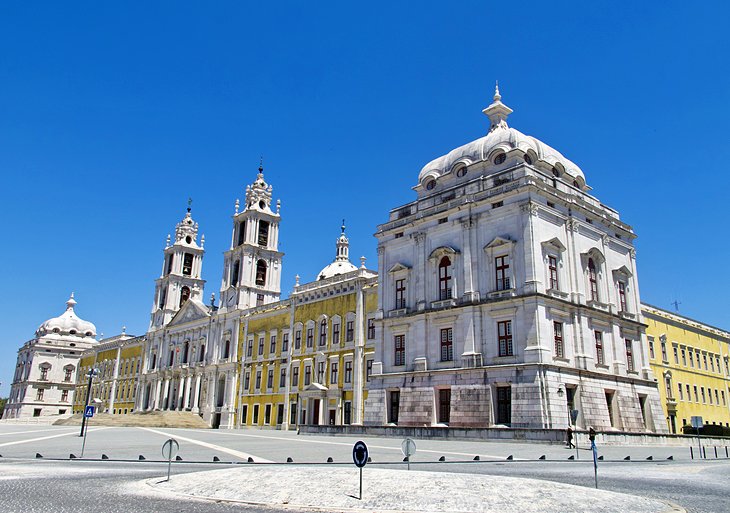
The majestic National Palace and Monastery of Mafra looms over the pleasant countryside town of Mafra and represents an outstanding example of grandiose excess.
Work began in 1717 on what was originally supposed to be a simple monastery and basilica, commissioned by Dom João V to honor the birth of the king's first child. But as wealth from Brazil swelled the royal coffers, the project took on a new dimension and eventually, a huge Baroque palace was built, lavishly decorated with exotic furnishings and numerous works of art.
A tour allows access to the monastery, palace, church, and basilica. One of the undoubted highlights of the National Palace and Monastery of Mafra is the sumptuous marble floored library, where more than 40,000 rare and precious books line Rococo-style wooden bookcases - one of the most important collections of manuscripts and literature in Europe.
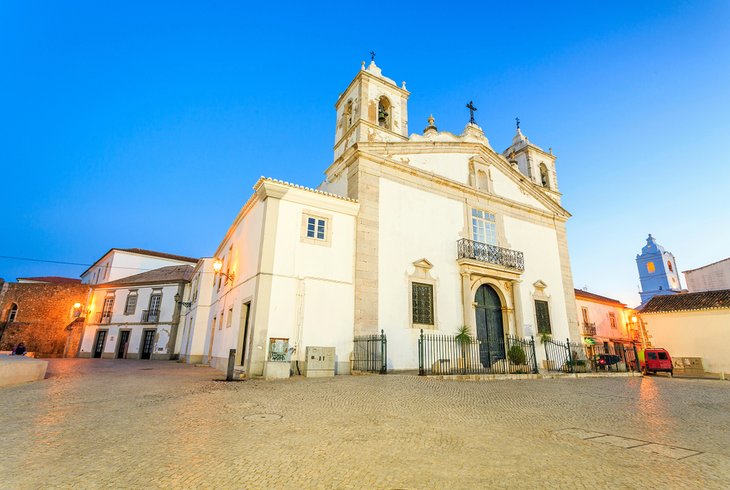
The Municipal Museum in Lagos holds the quirkiest collection of archeology and ethnography in the Algarve. The wonderfully eclectic display of local handicrafts, curios, and artifacts perfectly illustrates the region's diverse culture and heritage and includes items like an altarpiece handcrafted from cork and a realistic homemade scale model of an imaginary Algarve village.
A highlight is the impressive Opus Vermiculatum Roman Mosaic, unearthed in 1933 by the museum's founder, Dr José Formosinho. Tours conclude with a visit to the Igreja de Santo António and a dazzling interior of ornate gilded carvings and decorative azulejos panels.
- Top-Rated Tourist Attractions in Lagos
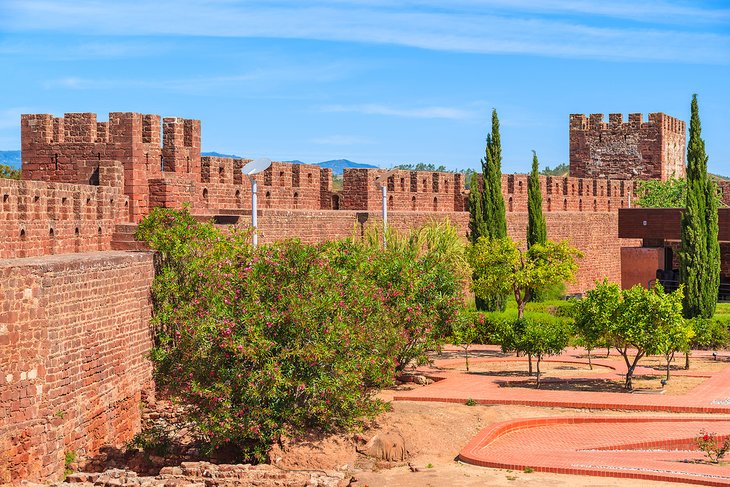
As Xelb, Silves was once the capital city of Moorish Algarve, and the Arabs named the region al-Gharb .
During the early 12th century, the town was renowned as a center of learning, a place where Islamic writers, philosophers, and geographers gathered. To protect the inhabitants, the Moors built a mighty castle on an elevated position overlooking the town.
Captured later by Crusaders, the fortress stands today as a permanent reminder of Moorish domination and Christian Reconquest. It is the most impressive historic monument in the Algarve and one of the top castles in Portugal . Its huge walls of red sandstone color the pleasant riverside town of Silves below with an inviting ochre glow.
Visit during early August and revel in the annual Medieval Festival set outside the sturdy battlements.
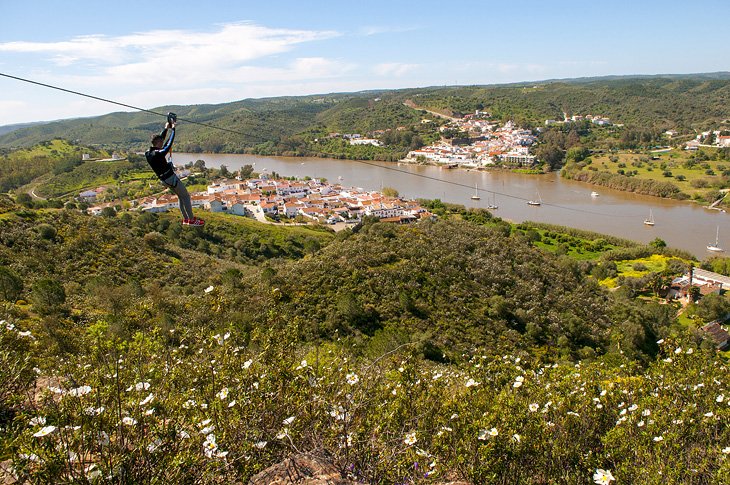
Spanning Spain and Portugal and currently the world's only cross-border zipline , this is one of the most daring and radical tourist attractions in the country. Connecting Sanlúcar de Guadiana in Spain's Huelva province with Alcoutim in the far north of the Algarve, the line measures 720 meters and joins the two countries across the wide and meandering River Guadiana.
Participants, fully kitted out in safety harnesses and helmets, begin their flight from a departure platform set high above the river overlooking the sleepy hamlet of Sanlúcar. Crossing the river at speeds of between 70 and 80 kilometers per hour, they literally fly through time, gaining one hour because of the time difference between the two countries.
Thrilling and wholly original, the ride offers a totally different Algarve visitor experience, and it's not everyday you can boast of traveling from one country to another in under one minute!
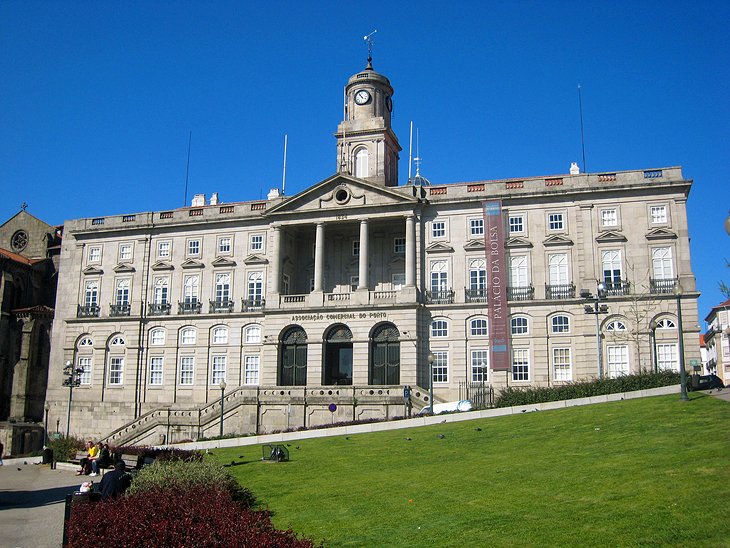
Oporto's alluring medley of visitor attractions includes the city's former stock exchange building, the beautiful Palácio da Bolsa . Built by merchants in the mid-19th-century on a site where the monastery of São Francisco once stood, the palace lies within the old city boundaries and as such enjoys UNESCO World Heritage status.
The dazzling interior reflects the wealth pouring into the city at that time, and a tour of the ornate rooms and galleries reveals a grandness and richness as extravagant as any royal palace. Epitomizing this opulence is the incredible Salão Árabe, the Arabian Room. Inspired by the Alhambra in Granada , the magnificently gilded salon is wrapped in blue and gold Moorish-style decoration that shimmers like Aladdin's cave.
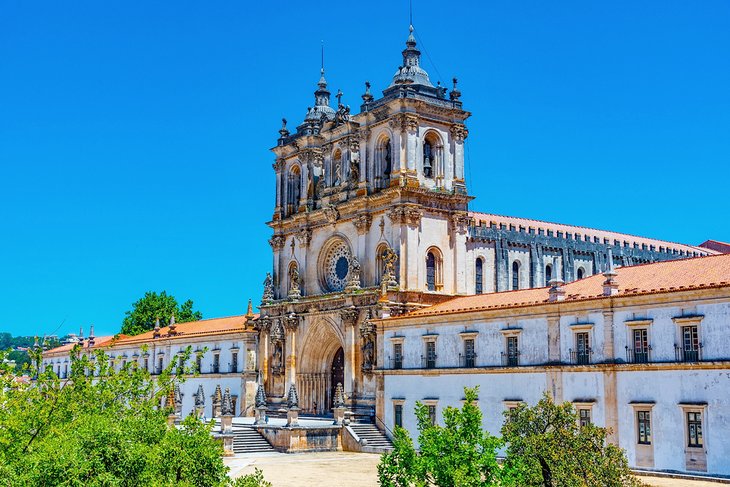
Portugal's central area is home to one of the country's hidden gems, Alcobaça. It's a quaint, small place off the main tourist track, allowing you to fully immerse yourself in the remarkable Old Town. Spend time wandering the winding streets full of cafes, restaurants, art galleries, and shops.
The town is in the heart of Portugal's agricultural region and is renowned for Pêra Rocha' pears and apples which feature prominently in the local gastronomy.
A highlight of a visit, though, is the Monastery of Alcobaça. This UNESCO World Heritage site is a shining example of Gothic, Baroque, and Manueline architectural styles. It's a quiet and contemplative place that has survived from the 12th Century until today. The Monastery is Portugal's largest church and is especially noted for having one of the largest medieval Cistercian cloisters in Europe; the Claustro do Silencio.
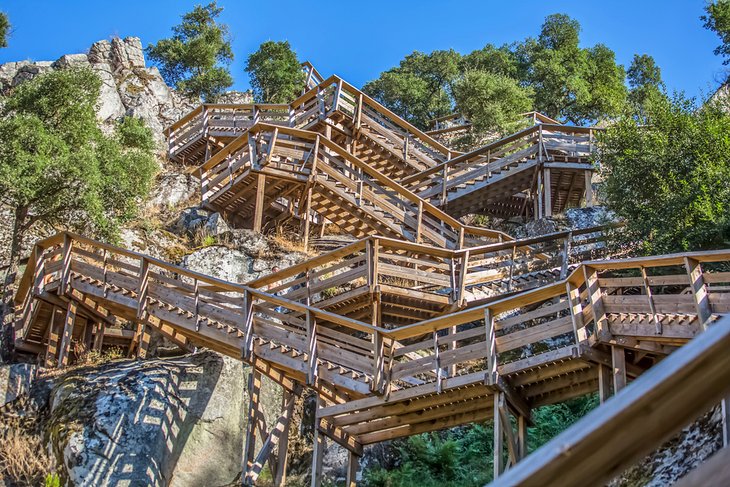
Translated as the Paiva Walkways, this award-winning facility ticks all the green boxes. Located outside the town of Arouca, a 70-kilometer drive north of Aveiro in central Portugal, the Paiva Walkways provide a challenging but highly rewarding eight-kilometer hike over an elevated boardwalk that dips, climbs, and meanders through the Arouca Geopark - an unspoiled landscape of outstanding beauty, and a biodiversity hot spot.
The walk commences at Areinho and partway follows the pristine River Paiva downstream. Very soon, you're hiking through a rugged, seldom-seen environment of peaceful, verdant woodland and deep, yawning gorges.
Along the way, you pass tumbling waterfalls and serene, mirror-like pools. Quite often the trek involves negotiating long flights of zigzagging steps over steep inclines: the route really does test stamina and physical fitness.
The walk takes around 2.5 hours to complete , ending in Espiunca. Remember to pack sunscreen, energy snacks, and plenty of water.
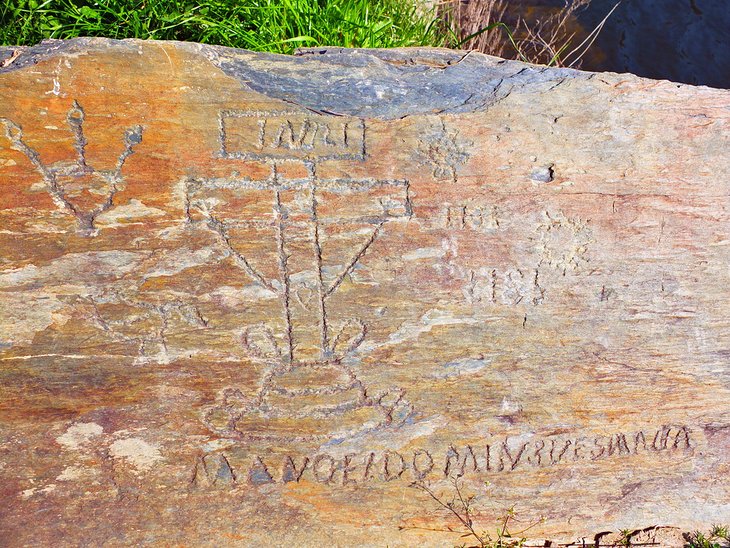
In the early 1990s, a team of engineers surveying a valley of the River Côa, in northeastern Portugal, while planning the construction of a dam discovered thousands of rock drawings from prehistoric times etched into giant slabs of granite. It was a rare and outstanding find.
The dam project was subsequently canceled, and the engravings - featuring horses, cattle, weapons, and human and abstract figures, the earliest of which date back 22,000 years BCE - were eventually designated a UNESCO World Heritage Site.
Today, visitors can admire this ancient rock art preserved in situ at the Côa Valley Archaeological Park by joining a guided tour in all-terrain vehicles. They can also find out more about the history behind the origins of the artwork and explore the valley through multimedia, photography, and images of the engravings at the fabulous Côa Museum, located at the gateway to the park.
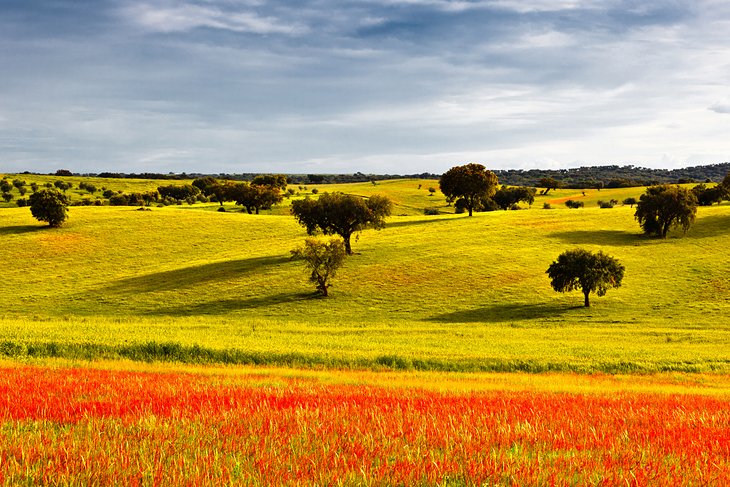
Whether following a narrow, gurgling stream; traversing a flower-flecked meadow; or plodding over a soft, sandy track, one of the great things to do in the Alentejo is to explore the region on horseback.
The province is known for its love affair with horses - the beautiful and mild-mannered Lusitano breed is synonymous with this part of Portugal, especially in towns like Alter do Chão , home to the Coudelaria de Alter stud.
Leisurely rides can be enjoyed in the countryside or along the coast, led by expert guides who were practically born in the saddle. Comporta is a favorite seaside destination; inland, head for places like Alcácer do Sal , on the River Sado, and Ourique , located deep in the forested hinterland.
Cabo da Roca is most notable for being the westernmost point in Europe . Dramatic cliffs descend into the crashing waves of the Atlantic Ocean and unsurpassed views extend to the horizon. A historic lighthouse stands as a sturdy sentinel on this wind-blasted rugged point of land, a welcoming beacon for wandering mariners.
Search out the plaque and read the famous words of Luís de Camões, who like many who lived in the 14th Century, truly believed that this was the edge of the world "where the land ends and the sea begins."
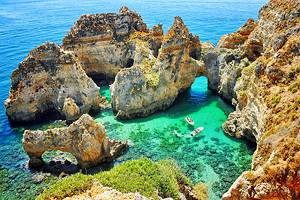
Exploring Southern Portugal : Portugal's fine beaches offer pleasant year-round diversion and, in the Algarve especially, are sited near some fabulous holiday resorts. In fact, southern Portugal is also known for its standout destinations, such as the regional capital Faro , plus Tavira and Portimão . Remember, too, that Portugal's islands offer a totally different travel experience. Learn more about Funchal in Madeira and Ponta Delgada in the Azores.

More on Portugal
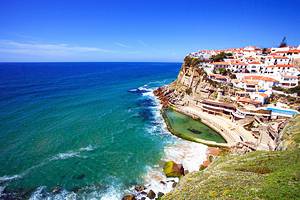

30+ Portugal Travel Tips for First Timers & Must Knows Before You Go
Last Updated: July 20, 2023
*FYI - this post may contain affiliate links, which means we earn a commission at no extra cost to you if you purchase from them. Also, as an Amazon Associate I earn from qualifying purchases. Check out our Privacy Policy and Disclosure. for more info.
Take a single glance at Portugal and you’ll soon leap to the same conclusion as its millions of doting visitors: this is one of those destinations that seems to have it all.
From verdant valleys and golden beaches to fairytale castles and buzzy cities, visitors are swimming in choice as much as they are in sweet, custardy pastries.
But it’s not all custard tarts and photo opps. The truth is, Portugal often catches first time visitors off guard with random culture shocks, unexpected tourist traps and (sadly) even pickpockets and scams.
Luckily, I’ve learned all these the hard way (over 3 week-long trips) so you don’t have to.
So, from tactical tips for itinerary planning to assorted mistakes to avoid, here are my top Portugal travel tips and must knows for first time visitors. I hope you find them helpful!

Save this list of Portugal Travel Tips for later!
You’ll be very glad you did.
1. Go beyond the most famous Portuguese destinations
We’ll start with the basics: when planning your trip to Portugal, remember that there’s a lot to see beyond the coastal hotspots of Lisbon, Porto, and the Algarve.
Portugal is a (satisfyingly rectangular) country composed of 18 districts and two autonomous regions, with a myriad of places to visit beyond the most frequented, from its many historic cities up North (e.g. Braga, Guimares, Lamego) and inland (e.g. Coimbra, Evora, Elvas), to its spectacular nature in Peneda-Gerês National Park and on their many islands.
SO, all that to say, if time permits, definitely expand your itinerary beyond the most famous sights, because this will allow you to experience a bit more of the country, while dodging some of the popular areas’ notorious crowds at the same time.

2. Public transport is fine for city to city travel, but you’ll need a car for more remote areas
I’ve never rented a car in Portugal, and have found the public transport system to be simple and easy for getting from city to city.
But, truthfully, the most flexible way to get around and potentially explore off the beaten path is renting a car. Doing so will give you the best opportunities to control your own schedule, and find more remote areas like quieter nature spots or beaches (especially in the Algarve).
I did find the lack of car to be quite limiting when we wanted to get out to less popular areas, so if exploring more offbeat spots is a priority to you, then a car rental is something to consider.
This Portugal tip comes with a big disclaimer however: beware that driving in Portugal involves many tolls and a lot of close encounters with the country’s most notorious danger….. Portuguese drivers.
For a potential ‘in-between’ option then, I’d suggest looking into taxis/hiring a driver. I’ve found these services to be quite affordable in Portugal, with Uber being an especially easy option.
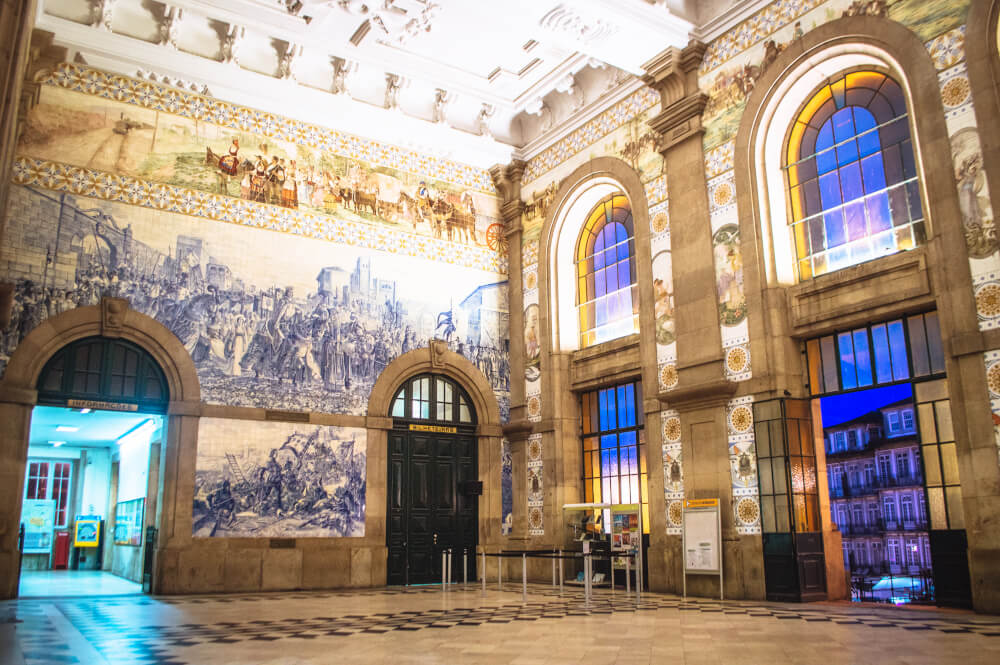
3. Consider flying in/out of different airports
In terms of arriving in Portugal, there are 3 international airports: Lisbon (LIS), Faro (FAO) and Porto (OPO).
And after personal experience at each of these airports, I have the following planning tip to offer: if you are visiting multiple destinations, consider booking flights into one city and then out of another (provided the price difference isn’t eye-gougingly painful).
This is because Portugal is small, but many of its most popular destinations aren’t that close together, so getting around does still take time, hence why you’d ideally want to avoid having to double back.
In the past, I’ve flown into Porto for instance and then spent 10 days going from there down to Lisbon, then down to Lagos in the Algarve and then departing via Faro Airport.
This made for a much smoother journey than going all the way back up to Porto, which meant more time spent soaking in views like these:

4. On a budget? Look into Europe’s low cost airlines
If you’re travelling Europe on a budget, then here’s a big Portugal travel tip: Portuguese airports are very well serviced by budget airlines like RyanAir and easyjet .
SO, if you’re planning a big Europe trip involving other countries, it may be worth looking into whether you can find cheaper flights into other European destinations, then flying into Portugal through a budget airline. This could potentially save you hundreds of euros!
You might want to check out my cheap flights to Europe guide for more.

5. Use the TAP Portugal Stopover to Save Money
Another potential money saver is looking into a TAP Portugal Stopover.
TAP Portugal is an airline that offers a really great deal where you can organize a free stopover in either Lisbon or Porto for up to ten nights en route to another destination.
So, if you plan properly, you can essentially get two destinations for the price of one!
NOTE: While this tip could potentially save you money, beware that TAP Portugal doesn’t have the best reputation, and is notorious for delays/other issues. One of my friends living in Portugal even told me that people say TAP stands for ‘Take Another Plane’ so be sure to keep these potential drawbacks in mind before booking.
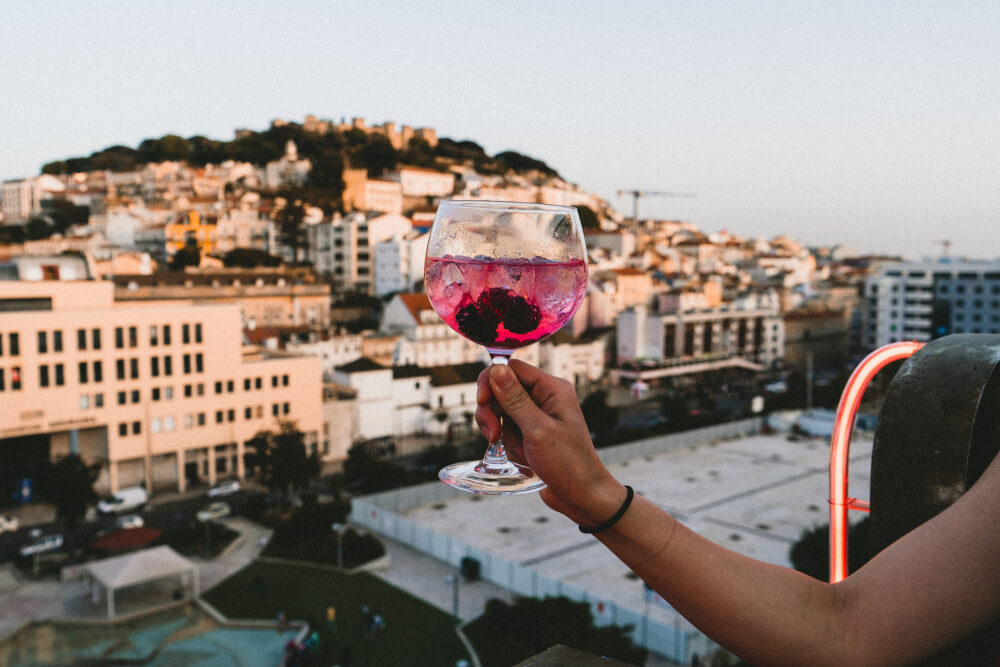
6. Avoid visiting Portugal in July and August
Now as for when to visit Portugal, a good rule of thumb is to avoid July and August. I say this in my general Europe tips post for pretty much every destination.
This is when the crowds and heat are at their worst, with hyper inflated prices to match.
The same applies for major school holidays like Easter because Portugal is a very popular family vacation spot among Europeans.
Instead, aim to visit between May – June or September – October. I’ve been to Portugal before in both March and April and found it to be quite rainy both times, so shoulder season would be more ideal for dodging both crowds and biblical downpours.
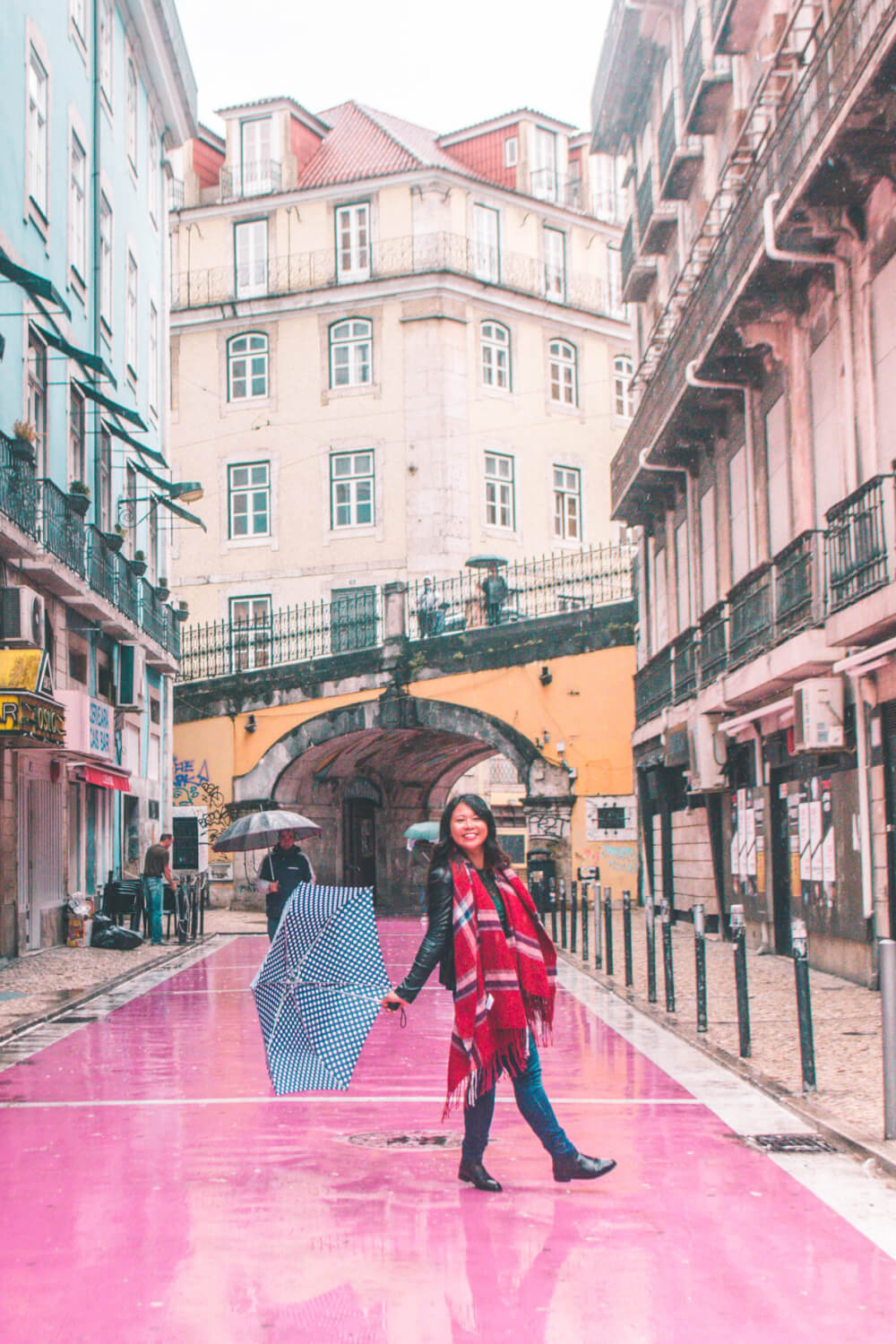
7. Beware that there will still be crowds in shoulder season
On that note though, I don’t want you to underestimate how crowded it can get in Portugal, even in shoulder season.
Portugal may still be seen as an up and coming destination among North American travellers, but it has been a go-to vacation spot among Europeans for YEARS and years and years…
So don’t be surprised when there’s a lot of people around. Even in March. or April. Sadly, there’s no true ‘off-season’ in Portugal these days!
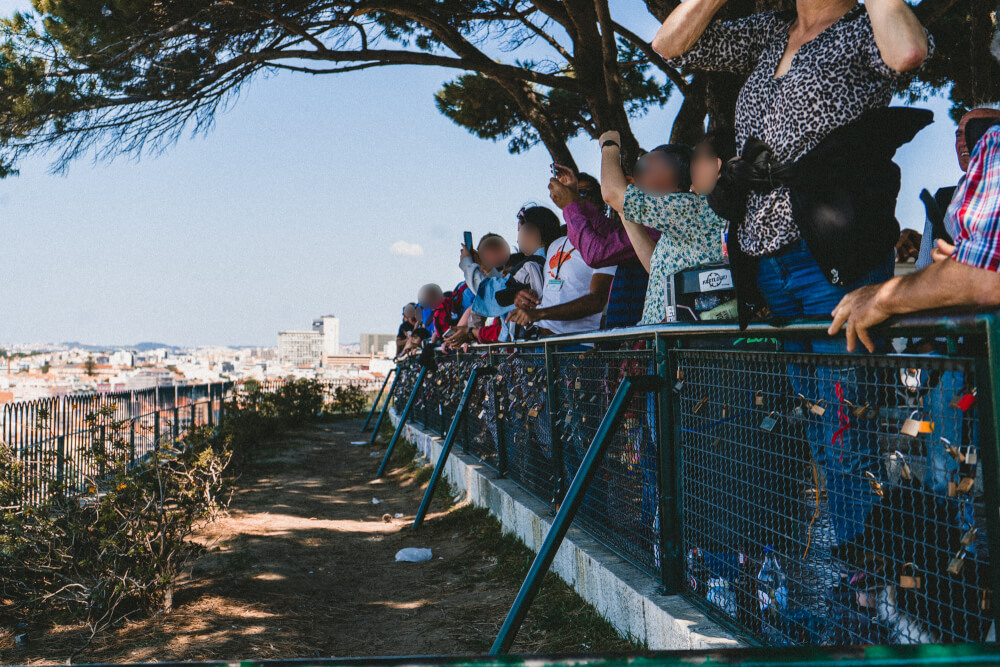
8. Book popular day trip destinations as overnight stays instead
Of course, in spite of the country’s frightening popularity, there are still ways to avoid crowds and outsmart your fellow tourists.
One of my top Portugal travel tips for this is booking popular day trip destinations as an overnight stay instead.
This will allow you to wake up really early to see the busiest sites before the day trip crowds arrive, and then enjoy them properly after they leave.
I did this for instance in Sintra, opting to stay for two nights instead of going as a day trip from Lisbon as most visitors do. The result? I was able to enjoy many of Sintra’s palaces without feeling like I was in a selfie stick mosh pit.
… So, I’d highly recommend doing popular day trips as overnight stays instead. Book early enough and sometimes accommodation in these areas is cheaper than in big cities!

9. Learn some Portuguese basics & have Google Translate handy
For first time visitors to Portugal, an immediate culture shock is often that English is not as widely spoken here as other tourist areas in Europe, especially among older residents.
And while getting with English is usually fine in larger cities, once you venture out into smaller towns, speaking no Portuguese can be a challenge… so I’d advise having Google Translate (one of my must-have Europe apps ) ready to go.
BUT more importantly: at the very least, you should learn how to say hello and thank you. So, memorize these! Tattoo them on your wrists:
- Hello is Olá, but it’s more common to greet according to the time of day so Bom Dia (Bong Dia) for good morning, Boa Tarde (Boa Tarht) for good afternoon and Boa Noite (Boa Noit) for good night
- Thank you in Portuguese is gendered, and the way you say it depends on if YOU are a man or woman. So men say Obrigado, women say Obrigada

10. Note that there’s differences between European and Brazilian Portuguese
Now, if you decide to go all-out and learn some Portuguese for your trip, it’s probably a good idea to make sure you’re learning European Portuguese pronunciation, as opposed to Brazilian Portuguese.
Like with most languages, Portuguese has various accents/dialects/variations, but I’ve heard the difference between European vs. Brazilian Portuguese can actually be quite stark, so to maximize your chances of being understood, try to make sure you’re learning European Portuguese.
One channel I came across that was great for this was Practice Portuguese, so give them a watch.
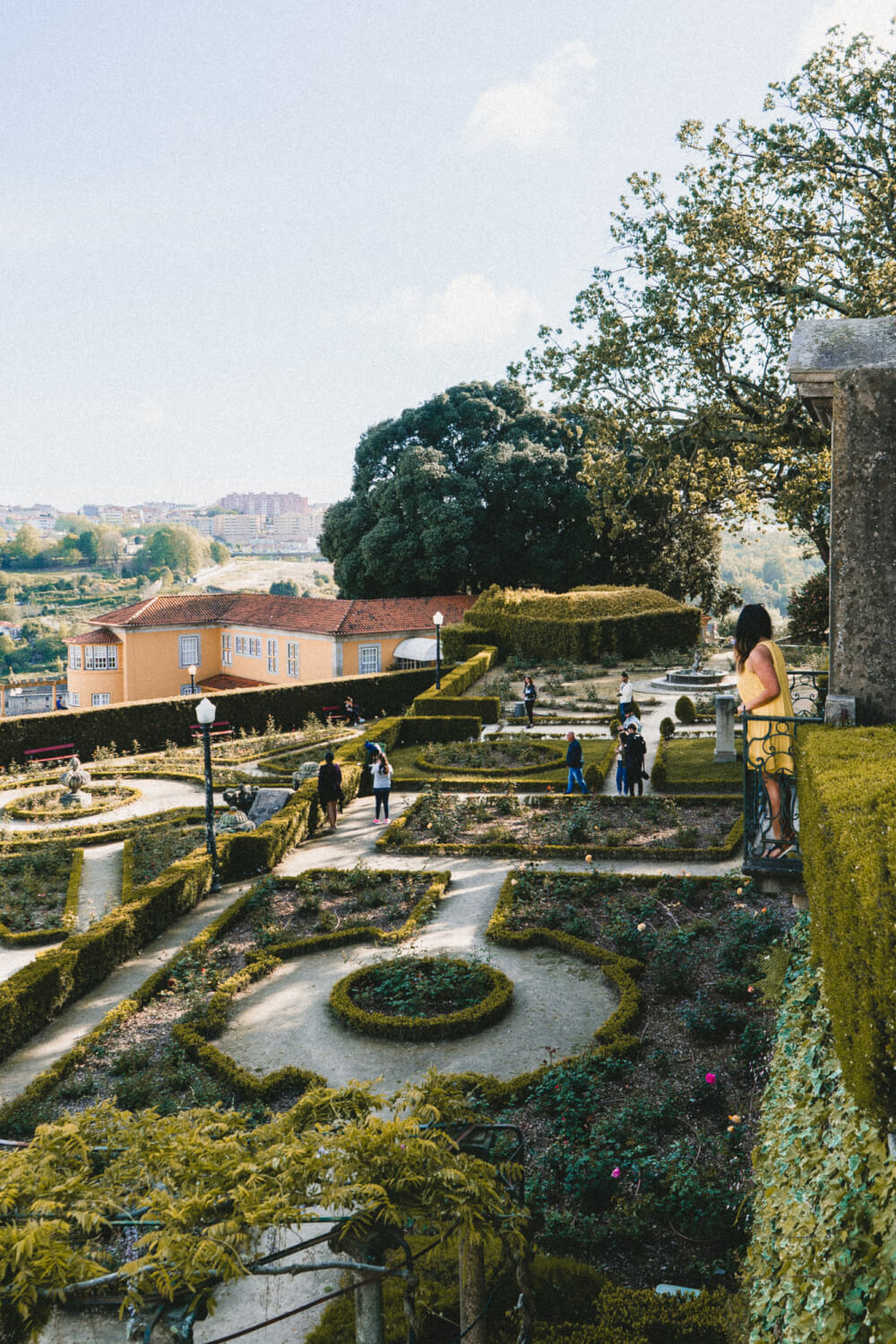
11. And… remember that Portuguese and Spanish aren’t the same
It feels silly that I have to say this, but I’ve anecdotally heard of many visitors busting out Spanish in Portugal, expecting to be understood.
Therefore let me clarify this most obvious Portugal travel tip: remember, in Portugal, they speak Portuguese, which may share some similarities with Spanish, but is an entirely different language of its own.
So keep in mind that while you may be somewhat understood, it’d be pretty rude to just randomly speak Spanish at people. So… let’s all just make a pact right now to not do that.

12. Learn to pronounce destination names in Portuguese
Apart from learning the basics in Portuguese, another important Portugal language tip is to learn how to properly pronounce your destinations in Portuguese.
This will save your life when it comes to asking for directions, because many places are pronounced differently to how they may be pronounced phonetically in English.
I found this video to be super helpful for this purpose.
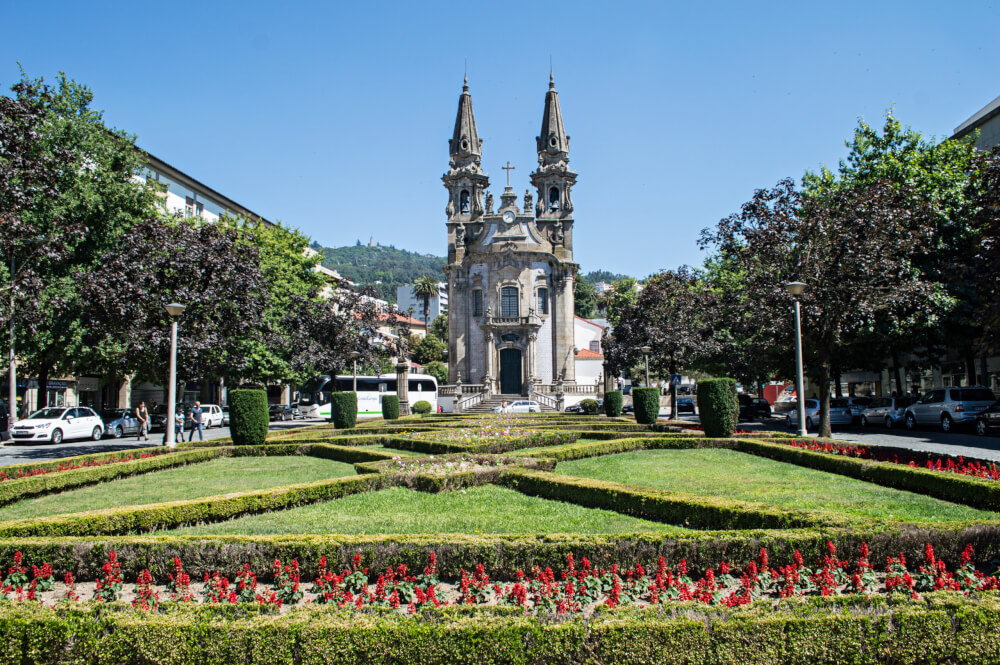
13. Beware of ‘Portuguese Time’
Another cultural difference is to beware of Portuguese time.
Unlike in some central European countries like Germany , Austria or Switzerland, punctuality isn’t really a huge priority in Portugal, and things tend to be more laidback in terms of time.
As a tourist, this probably won’t impact you that much unless you’re making plans with Portuguese friends, but just know that time is definitely a bit more flexible there, and so if you have tours that start a bit later than planned, just don’t be too surprised.
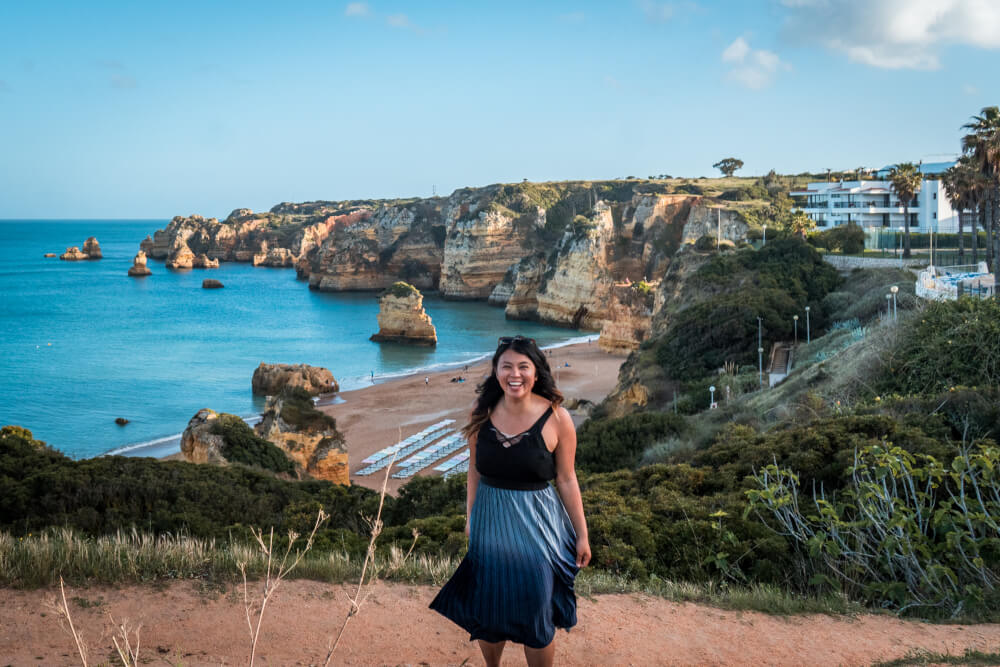
14. Be prepared to walk uphill a LOT
Now onto another Portugal travel tip that pretty photos fail to convey: prepare yourself for the leg workout of your LIFE.
Portugal is overall an incredibly hilly country, so you’ll be encountering plenty of ups and downs during your visit, especially if you visit Lisbon and Porto.
The cobblestones are also very slippery, especially when it rains so make sure you have good, solid footwear. Don’t say I didn’t warn you.
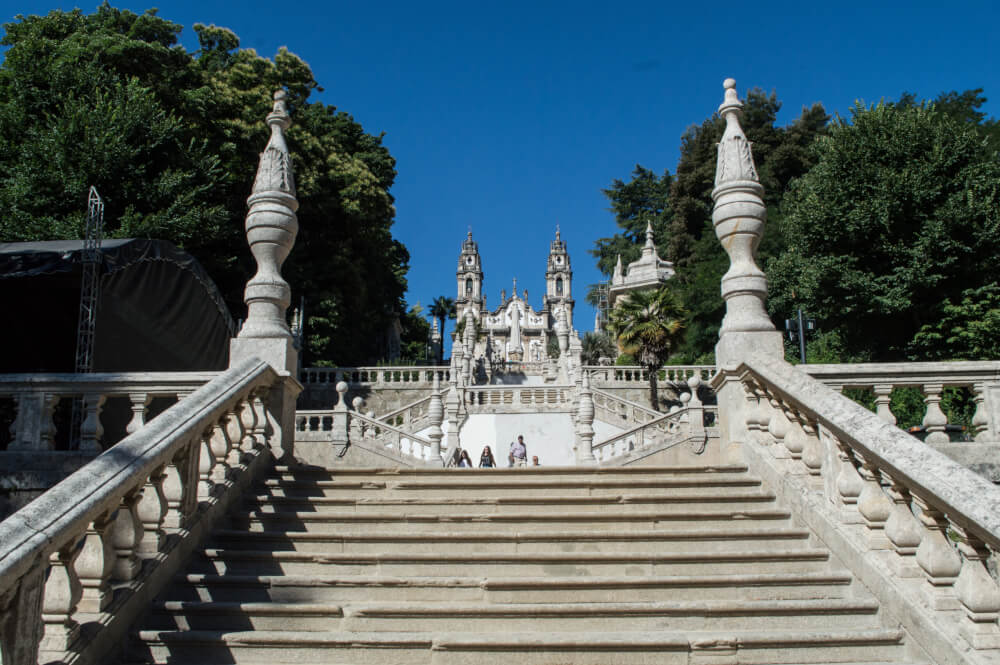
15. Consider attraction passes/cards to save money
If you plan to visit a lot of museums and paid attractions while you’re visiting Portugal, you should also look into attraction passes like the Lisbon Card and the Porto Card which offer you unlimited public transport and also admission to multiple attractions for one set price.
This can work out to a lot of savings, although to be honest, I’ve found many of the best things to do in these cities are free!
Especially if you’re not super into museums, this option may not be worth it, so just crunch the numbers and total up the price for your must-see attractions to see if the pass works out to be cheaper.
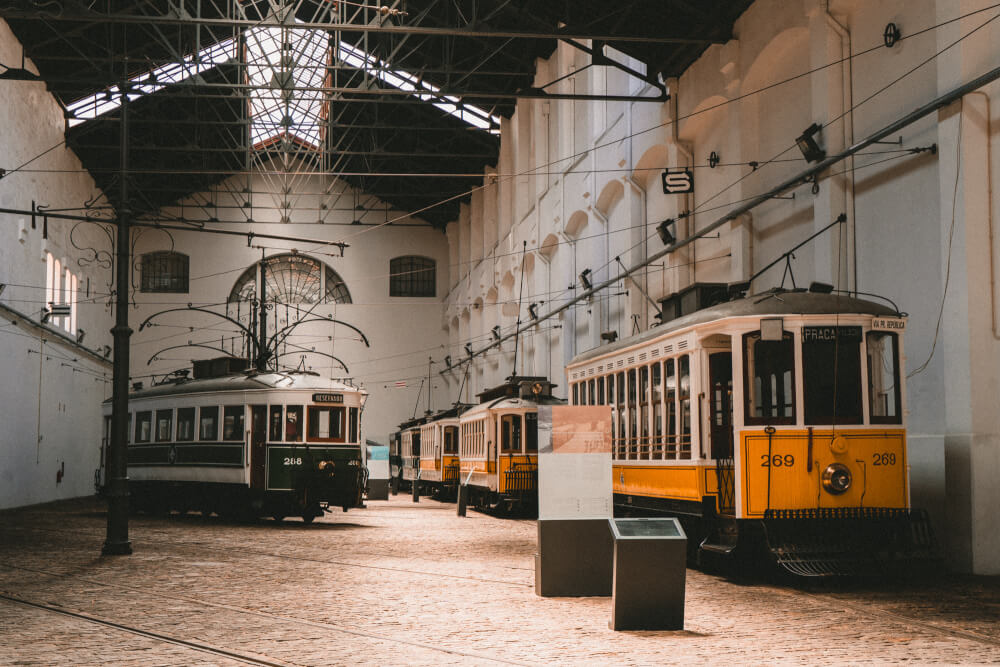
16. Beware of tourist traps
Okay, now it’s time for me to get a little controversial. I love Portugal as a destination, but I have to concede there are a lot of tourist traps (many of which are perpetuated by online guides/influencers) so I’m going to quickly share my opinion on some to be mindful of in the country’s most popular destinations:
Here are some tourist traps in Lisbon to keep in mind:
‘The Pink Street’: In real life, it’s just a street with restaurants and bars, and the pink isn’t nearly as perfect or vibrant as the photos make it look. It’s also usually crowded in the evenings… so don’t get your hopes up too much!
Tram 28: Super congested, super busy, lots of pickpockets, and you can enjoy the views much better if you just walk along the same route.
The Santa Justa Lift: Nice to look at, with great view from the top, but the lines are insanely long and you can easily walk up to the viewpoint for free and not have to wait in line. The best part of this attraction is really just seeing it and enjoying the view, so don’t think it’s a must do to actually ride it.
Here are some tourist traps in Porto to keep in mind:
Libreria Lello: Initially got famous because it was claimed that JK Rowling wrote Harry Potter there or was inspired by it (a claim she has now publicly denied). It is of course still a very pretty bookshop but unless you get there first thing in the morning or just before they close, it will not be magical at all because it is painfully crowded and almost impossible to get these nice photos without people in them because the shop is small. There’s also a 5 euro voucher you have to purchase to get inside, which gives you 5 euros off a purchase, but it’s not free to go in to take a look.
Private Property Viewpoints: Unfortunately, irresponsible Instagrammers have made a habit of taking photos from areas that are private property, so many of the most sought after views in the city aren’t actually open to the public. So, make sure you do your research before you set out!

17. Look beyond social media to find unique hidden gems
So, on that note, it’s important to look beyond social media to find fun places to visit and cool activities in Portugal.
Most travel content about Portugal focuses on the same spots over and over, but the flip side of that is there are TONS of cool gems just everywhere that you can kind of discover along the way for yourself.
I would recommend doing research on Portuguese language blogs or check out local Portuguese bloggers to get an inside scoop on more offbeat places because there are so many, and I can’t wait to go back and see more for myself.
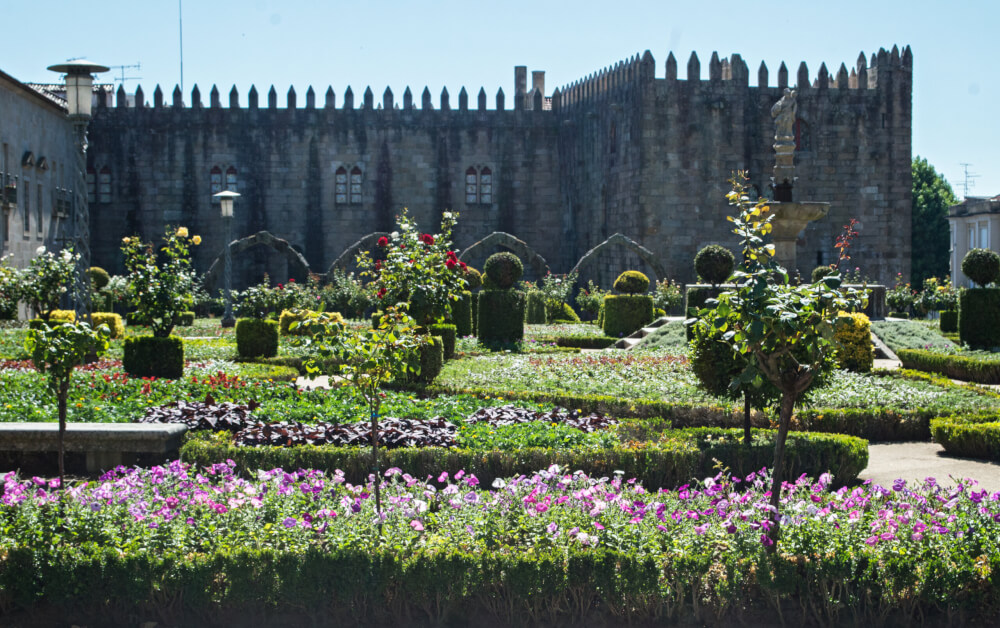
18. Seek out Miradouros everywhere you go
On that note, one really easy way to find beautiful places in Portugal is searching for Miradouros.
This is Portuguese for viewpoints and there are SO many of them especially in Lisbon.
So if you ever feel bored, just search Miradouro and go – guaranteed you’ll find a good view.
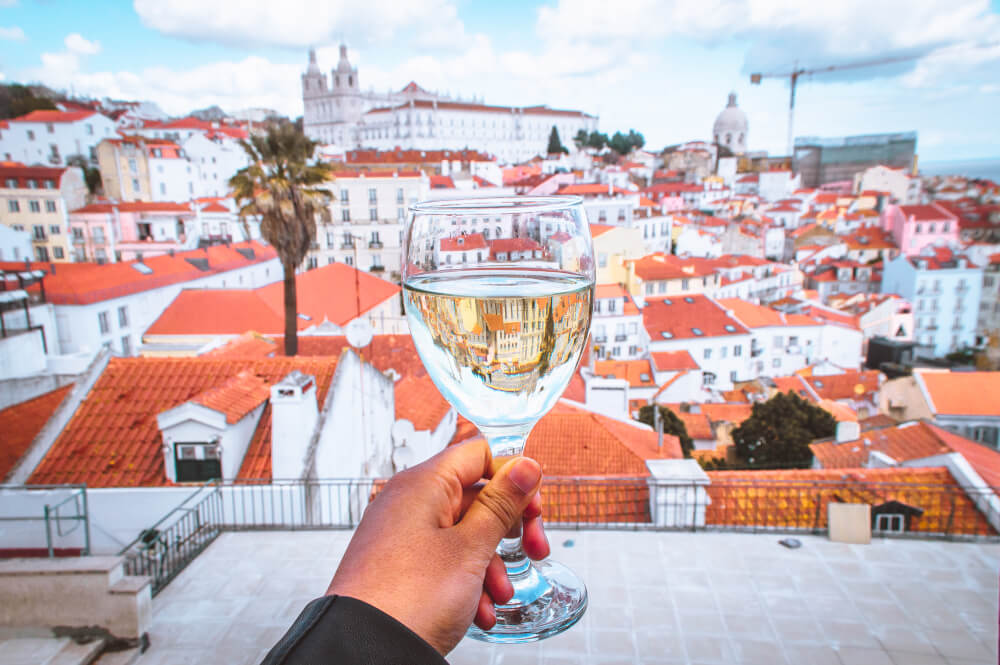
19. Beware that free museum days aren’t free for everyone
A lot of travel guides online have been perpetuating the Portugal travel tip that many museums are free on the first Sunday of each month in Portugal…
BUT it’s important to note that actually when you look at the fine print, many of these offers are only valid for residents of Portugal (e.g. here ) so keep that in mind and double check on official websites before you head out expecting your freebie.
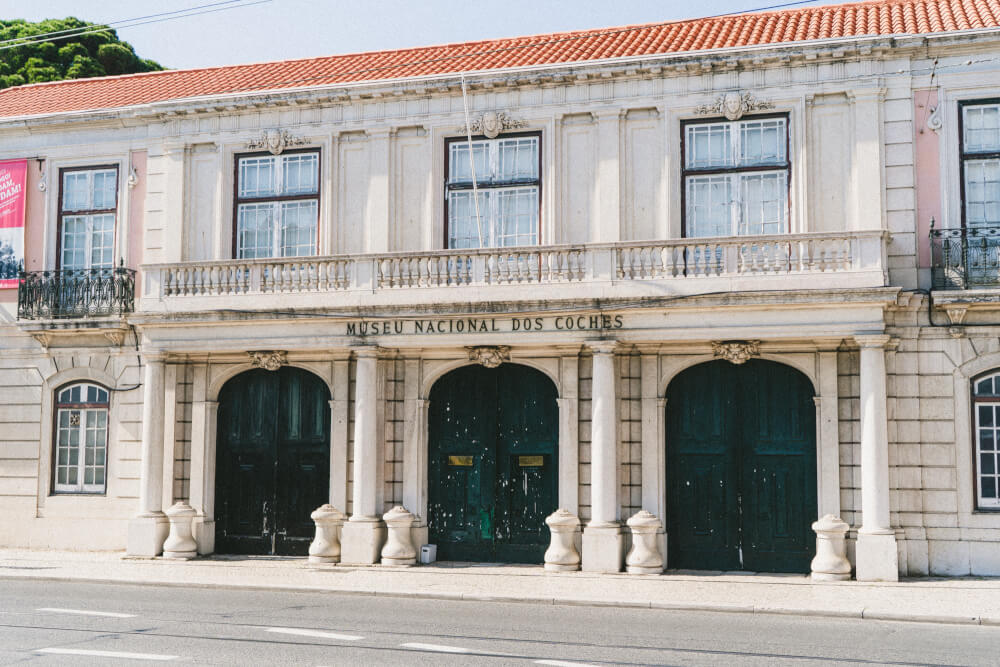
20. Make sure you try Vinho Verde
Moving onto Portugal tips for food and drink – AKA the most delicious and valuable section.
My first recommendation is to try Vinho Verde or green wine. I know it sounds weird, but the ‘green’ part of the wine has less to do with the wine’s colour, and more with its age.
In short, Vinho Verde is a young drinkable wine that’s not aged, and often a little fizzy, making it THE most delicious and refreshing accompaniment for a sunny terrace. I warn you though: this is some dangerously drinkable stuff, and you’ll be swallowing it by the gallon throughout your trip.

21. And avoid ordering Port wine with your meal
On the topic of wine, if you find yourself wanting to try the famous Portuguese Port wine, know that it’s a very sweet dessert wine that is usually enjoyed on its own after a meal (though sometimes before) and not one you sip during your meal.
… So avoid pairing your dinner with Port. That’s not the best way to enjoy it!

22. Research regional specialties before you go
Food-wise, Portuguese cuisine is super hearty and delicious, with many regional specialties depending on where you are in Portugal so be sure to Google the particular must-tries of your destination.
Of course, I can’t resist sharing a few quintessential recommendations.
First off, if you’re by the coast, fresh seafood is abundant and delicious, especially Bacalhau or Codfish which is available in literally hundreds of ways, including Pastéis de Bacalhau which are deep fried balls of potato and cod. So good!
In Porto, one very gluttonous must-try is the incomparable Francesinha – a thick sandwich stuffed with all kinds of meat and cheese then topped with more melted cheese, a dreamy sauce and often a fried egg.
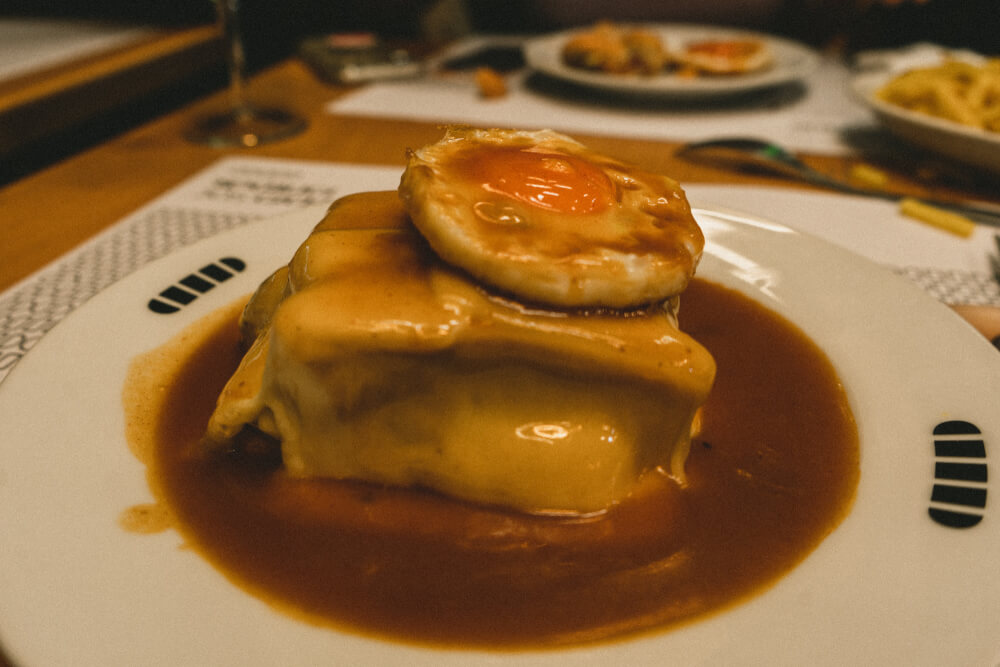
And, a specialty of Belem and Lisbon is the almighty Pastel de Nata. These are egg custard pastries that come in a crispy crust. They are absolutely incredible, and sure to be one of the highlights of your trip (and possibly life).

23. Consider ordering Petiscos to sample a variety of flavours
Not sure where to begin with Portugese cuisine? A great way to try a lot is by ordering Petiscos, which are small shareable bites similar to Tapas.
Of course, what is served as Petiscos can vary regionally as well, so be sure to do some research or ask for local recommendations, but overall, ordering a bunch can be a nice way to try a lot of different dishes and it can also be a more affordable alternative to getting full main dishes as well.
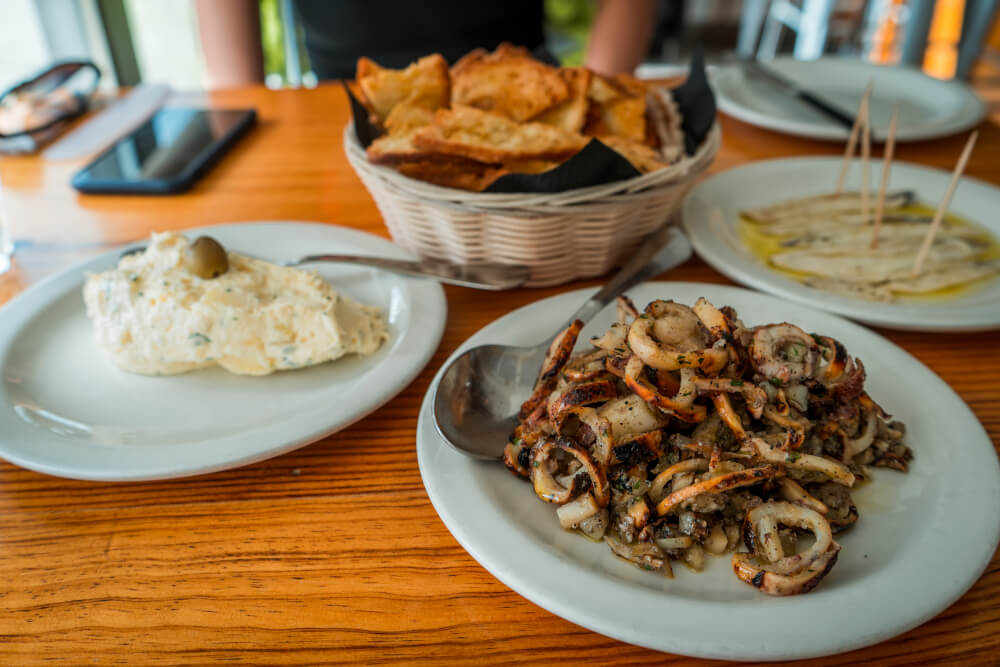
24. Prepare for late meal times
In terms of dining out, there are a few things you should know. First off – mealtimes in Portugal may be later than you’re used to.
It’s not uncommon for dinner time to be around 8 or 9pm or even later. Meals often last longer here too, taking several hours, so don’t feel any need to rush. Remember, Portuguese time is relaaaaaxed and fluid.
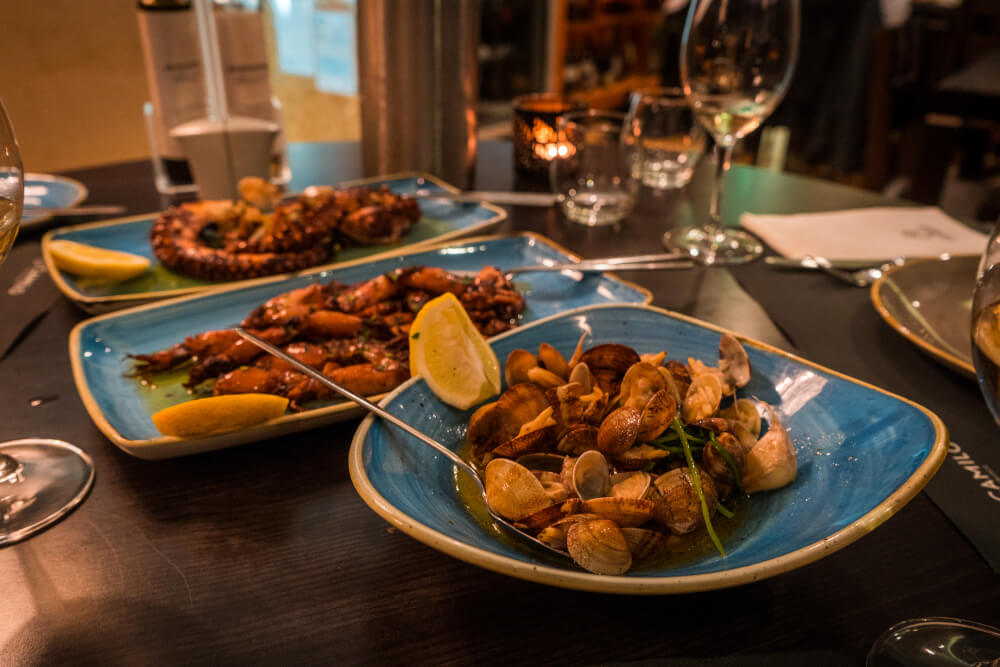
25. Do not expect continual service in restaurants
Another Portugal must-know is you should not expect continual service in restaurants here.
Often smaller local restaurants (or their kitchens) will be closed in the late afternoon to early evening, so from 2 or 3pm until 7pm, during which they only have some snack items or might not be open at all.
In larger cities, you’ll probably still find some places open but often these will be the ones that cater more to tourists.
So, keep these timings in mind so you can manage your hanger accordingly.

26. Learn how to spot tourist trap restaurants in Portugal
Speaking of restaurants that cater to tourists, there are a few easy ways to spot touristy restaurants in Portugal.
The first is if they’re in a particularly touristy area near a big attraction, you can probably expect prices to at least be a bit higher, and the value for money to be worse. A huge red flag is any place where there’s a host actively trying to get you to eat at their restaurant, as well as places with huge pictures or where the menu is a bunch of languages.
Often you can escape these by just walking a few blocks away from the main sights so be sure to look around a bit before committing.
Or if you want to enjoy the atmosphere because sometimes these touristy restaurants do have some great views and locations, just pop in for a drink, rather than a full meal.
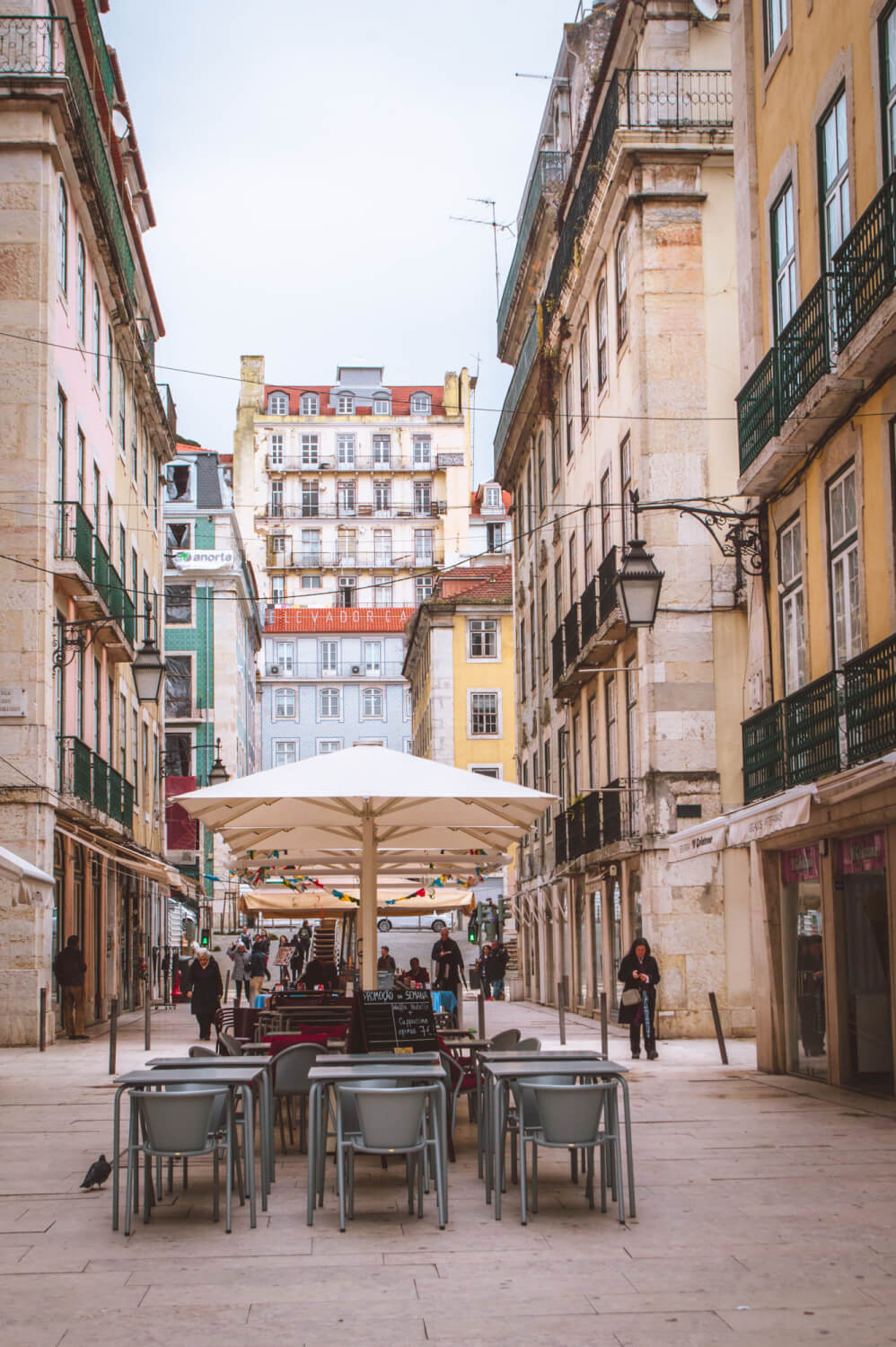
27. Know that your table snacks will probably cost extra
Another important Portugal must-know is that often when you arrive at a restaurant, there will be snacks like olives or bread put on the table.
To the surprise of many first time visitors, these aren’t actually included and come at an extra cost, known as “Couvert”, which is usually 1-2 euros per person.
Just know this isn’t a scam, it’s just a cultural difference in the way they charge for things so keep that in mind if you’re eating at a restaurant, and feel free to say ‘no thank you’ if you don’t want any, and you will not be charged for them. The price of the Couvert is also usually listed on the menu, so you can double check the cost before committing.
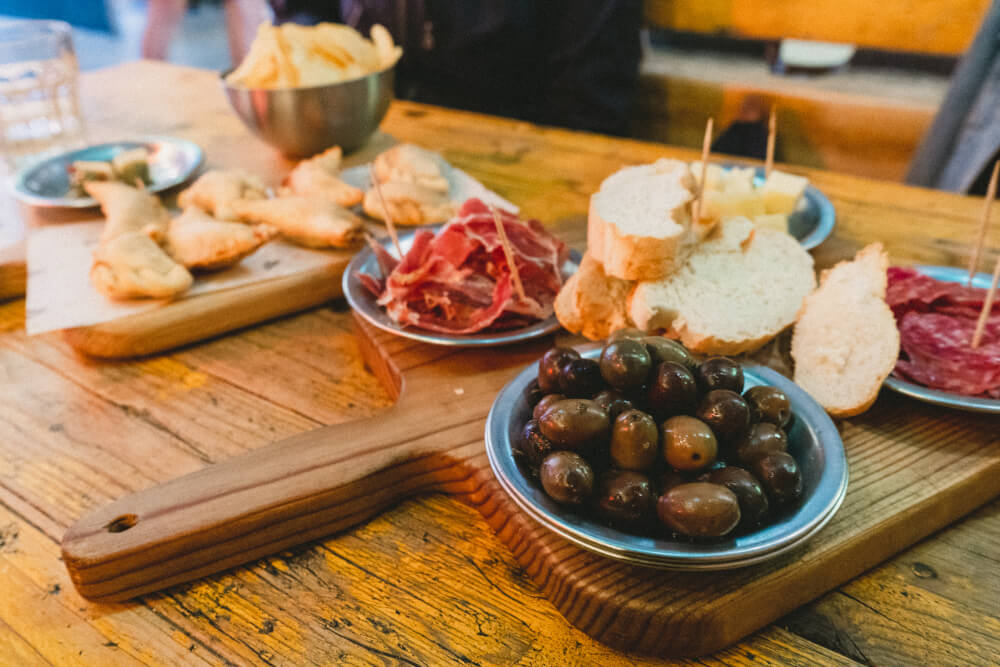
28. Learn Portuguese tipping etiquette
Tips aren’t expected in Portugal to the same extent as in North America, but if you want to, usually rounding up or doing 10 percent is fine.
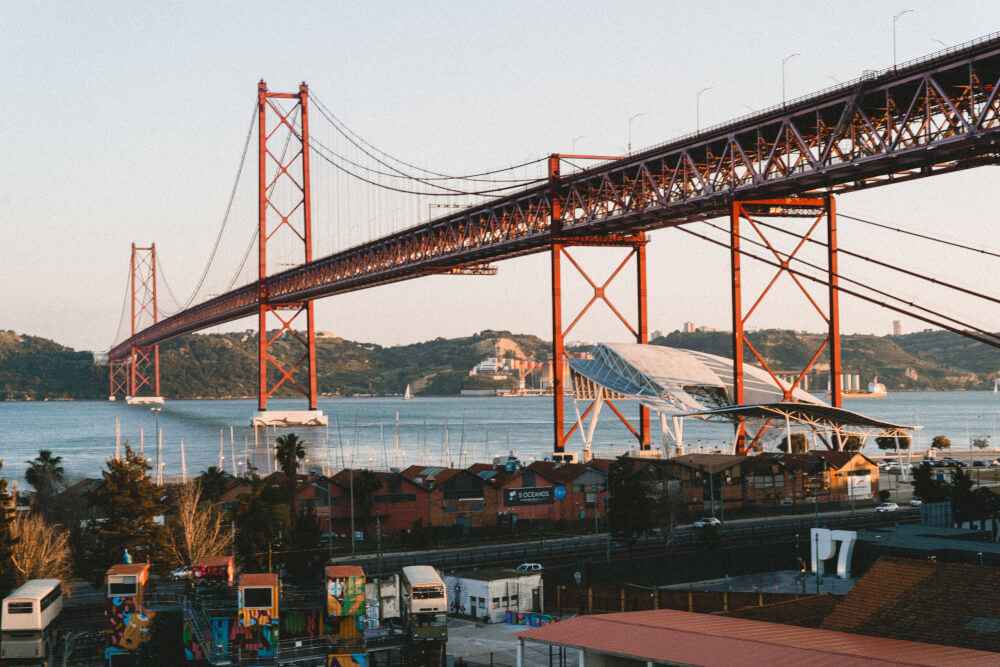
29. Bring cash (in smaller denominations)
Another important Portugal must-know once you arrive is that you should make sure you have cash on you.
While many places are taking card now, paying with cash is still the norm in Portugal, especially with smaller bills. The smaller the denominations you can get the better, because I’ve found that smaller places like cafes don’t like to break large bills. Ideally, keep to ten euro bills or below.
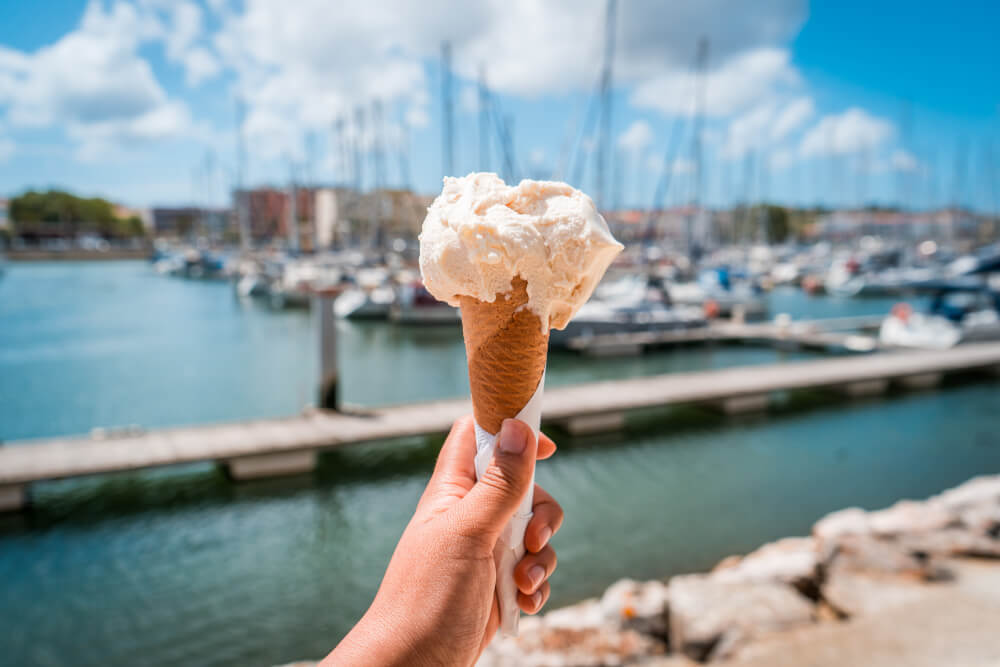
30. Don’t carry too much cash at once
That said, do not bring too much cash out with you at once, especially in touristy and busy areas in Lisbon, because pickpockets can be a an issue.
I’ve only been pickpocketed twice in my life and Lisbon was one of them so I’m still a bit sore about that.
So, go by my rule of thumb, which is to not carry more cash than you can stand to lose.
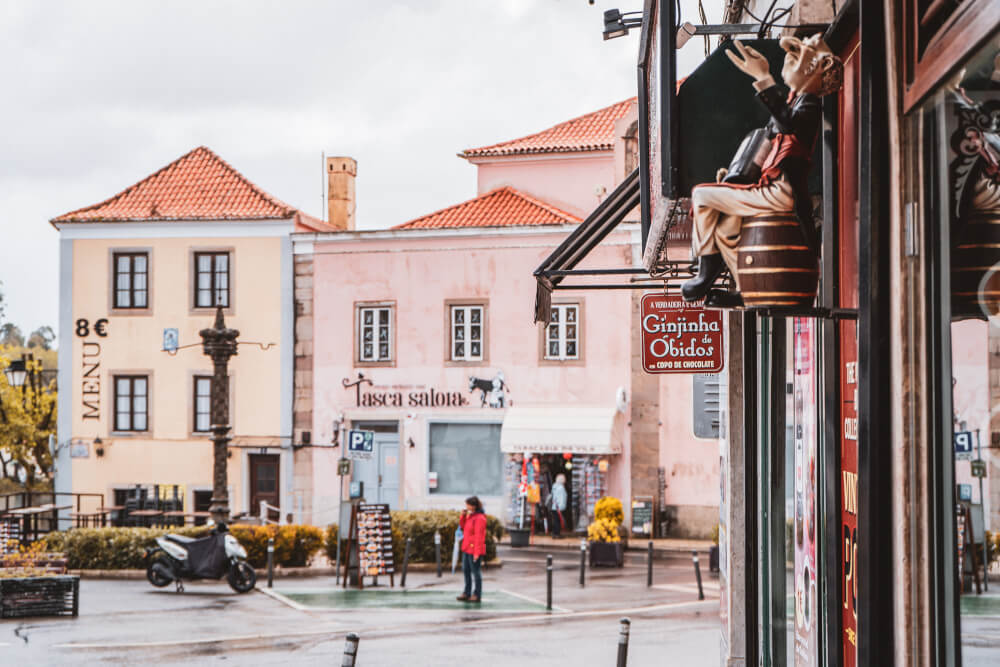
31. Beware of sketchy dealers
Another scam to look out for is dealers offering to sell you ‘illicit substances’ when you’re just out and about, minding your own business on the street.
This is of course mainly an issue in high-traffic tourist areas, as they always target silly tourists who don’t know better.
Here’s how it works: someone will come up to you and ask if you want something innocent like sunglasses, then they’ll follow up with whether or not you want said illicit substances. Apart from the fact that this already sounds sketchy, they’re also not selling real illicit substances, so no matter what, make sure the answer is no.

32. Be mindful of later opening times
Another thing to be mindful of when visiting Portugal is opening times.
(I’m talking of course about actual shops and restaurants, not those aforementioned dealers)
Overall, things run on a later schedule in Portugal relative to most of central Europe, so you can expect supermarkets to not open until 8am and close later as well, usually at 9 or 10pm.
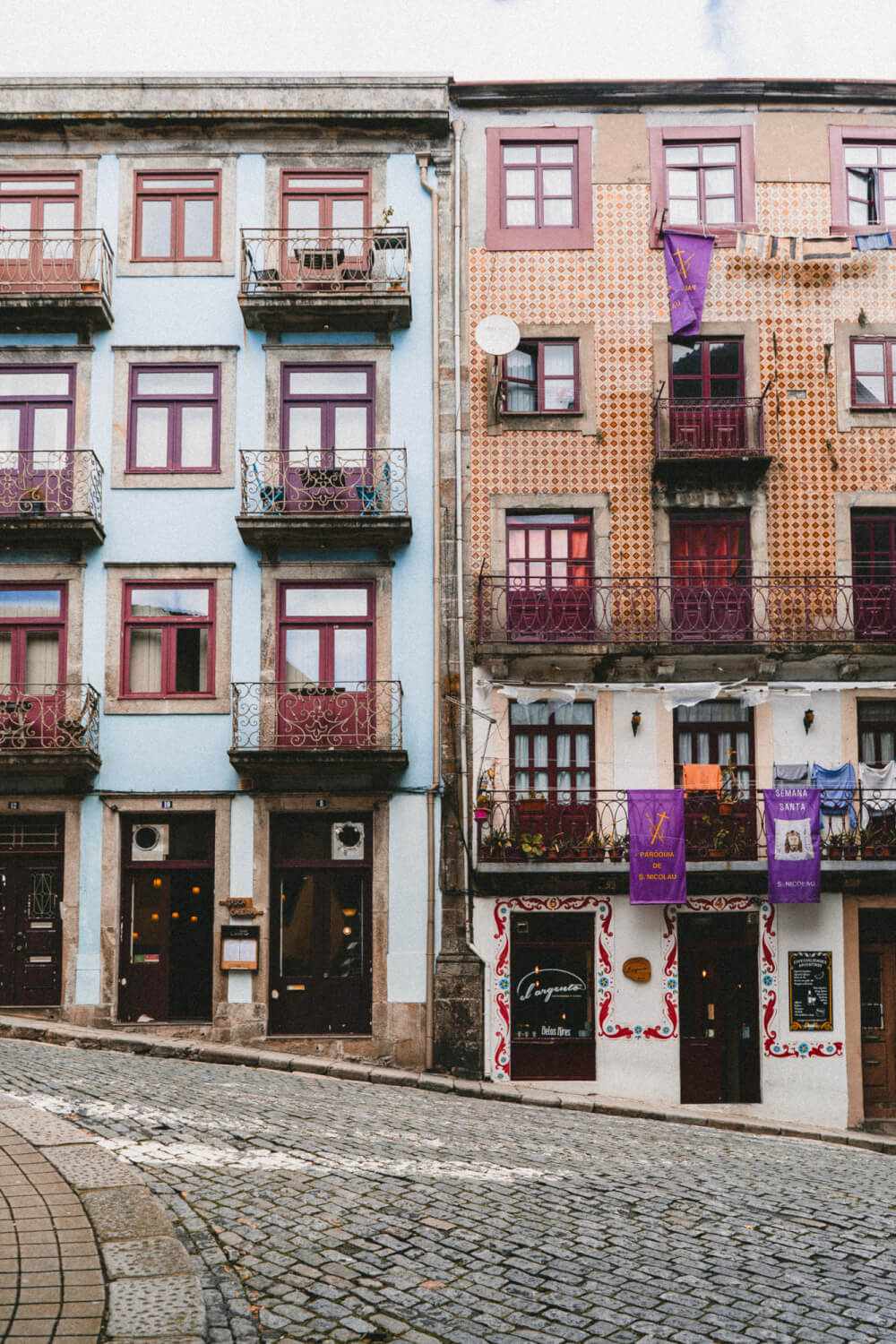
33. Pack warmer layers no matter when you visit
Okay final Portugal packing tip for you, be sure to pack some warmer layers, even if you’re going in the summer because the wind in Portugal (particularly along the coast) is vicious .
No – seriously. My trauma can attest! Portuguese wind can be really biting, especially when temperatures drop at night, so having at least one warm layer in your suitcase is a must.
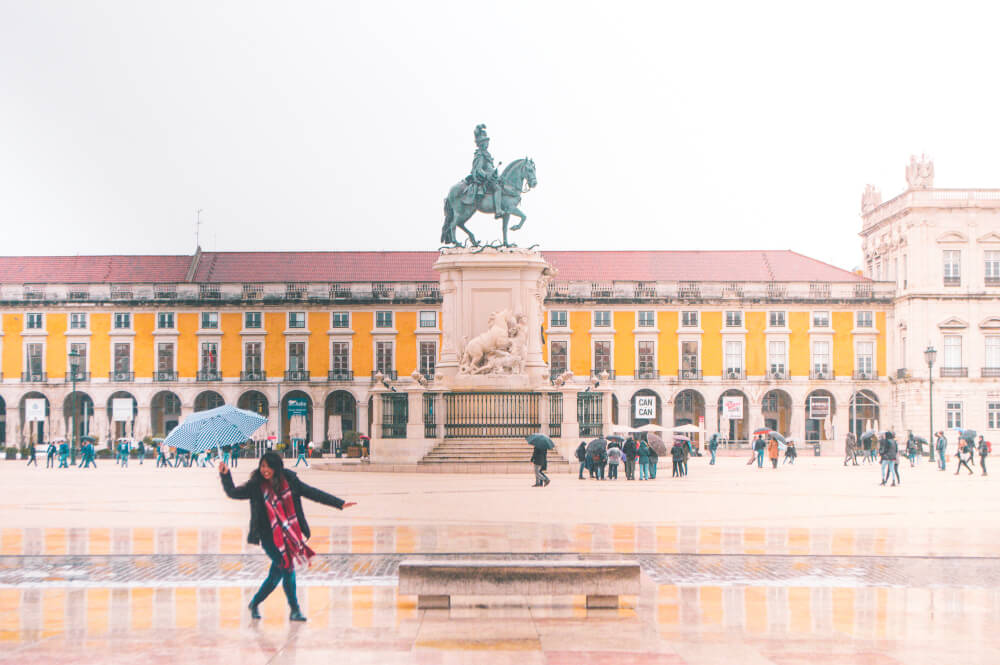
I hope this list of Portugal Travel Tips was helpful!
Congratulations on making it through the longest ever list of Portuguese travel tips. I admit this was already a VERY long list of tips for Portugal, but if you have any more questions, let me know in the comments.
My Go-To Travel Favourites:
🧳 Eagle Creek: My favourite packing cubes
💳 Wise: For FREE travel friendly credit cards
🍯 Airalo: My go-to eSIM
🏨 Booking.com: For searching hotels
📷 Sony A7IV: My (amazing) camera
✈️ Google Flights : For finding flight deals
🌎 WorldNomads: For travel insurance
🎉 GetYourGuide: For booking activities
1 thought on “30+ Portugal Travel Tips for First Timers & Must Knows Before You Go”
Thank you! I enjoyed the common sense approach. This was very helpful.
Leave a Comment Cancel reply
By using this form you agree with the storage and handling of your data by this website. *
Wander-Lush
28 Unforgettable Things to Do in Portugal: The Ultimate List
Portugal is easily one of the most rewarding travel destinations in Europe, with cosmopolitan cities, quaint villages, wine country, pristine forests – and not to forget, 1,800 kilometres (1,100 miles) of picturesque coastline ranging from dramatic cliffs, coves and caves to placid, sandy beaches.
Add to that more than 800 years of history, a fabulous food scene, music traditions and much more, and mainland Portugal plus the diverse islands of Madeira and the Azores have something to offer literally every type of traveller.
This mega Portugal Bucket List brings together 28 of the best things to do in Portugal, including must-sees, immersive cultural experiences , hands-on activities, and quirky and alternative Portugal attractions.
→ Don’t miss: The best places to visit in Portugal
Please note: This post contains affiliate links, meaning I may earn a commission if you make a purchase by clicking a link (at no extra cost to you). Learn more.
28 of the best things to do in Portugal
Ride the #28 tram in lisbon.
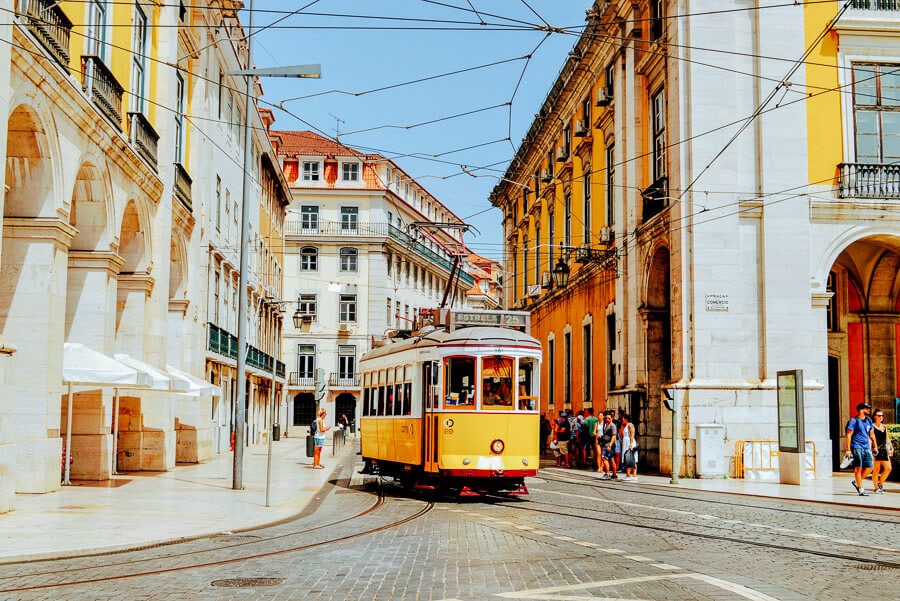
There’s no better introduction to Lisbon , the capital city of Portugal, than a self-guided tour by tram. A Lisbon icon, electric trams first launched in 1901 and have been ferrying locals and visitors alike up and down the city’s hills ever since.
Tram 28 is the best route for sightseeing and views. Think of it as Lisbon’s more authentic answer to a hop-on-hop-off tour bus! Running between Martim Moniz and Campo Ourique, it takes passengers along some of the city’s most beautiful streets, past key landmarks including Lisbon Cathedral, the Thieves Market, São Jorge Castle, National Pantheon, Miradouro da Graça, Arco da Rua Augusta, and more.
At just €3 per trip (paid either in cash to the driver or using a rechargeable Viva Viagem card), it’s also a very affordable way to see the best of Lisbon. Climb aboard a vintage Remodelado carriage, stake out a spot on one of the wooden benches, and sit back and absorb the sights and sounds of Lisboa.
The tram runs seven days from 6am. It’s a good idea to arrive early to beat the crowds. Riding the whole line takes around 50 minutes one-way depending on traffic. For a less-touristy alternative, the #12E tram follows a similar route through the historic Alfama neighbourhood , stopping at São Jorge Castle and Se Cathedral.
Alternative Lisbon experience: Follow the 28 tram route in a private electric tuk-tuk and snap photos of the charming yellow trams along the way!
Learn how to make Pastel de Nata in Belem

When visiting Portugal, it’s mandatory to munch on as many rich and flaky Pastel de Nata (Portuguese egg tarts) as humanly possible. This delicious pastry was born in the shadow of the iconic Belem Tower (Torre De Belem) in the 18th-century kitchens of Jerónimos Monastery, making Lisbon the spiritual home of Pastéis.
While you should definitely buy a pack or two of authentic Belem custard tarts to take home as a souvenir , why not go one better and learn how to make them from scratch yourself. It’s a life skill that will serve you well!
A Pastel de Nata Masterclass is a must-do for foodies and a great experience for kids. The original recipe is a closely guarded secret, but padeiras are more than willing to spill the beans for eager visitors who want to master the art. The best workshops take place in local bakeries and teach you how to make the creamy custard from scratch.
Try it: Book a Pastel de Nata Workshop with an expert baker , including a glass of Ginjinha sour cherry liqueur in an edible chocolate cup to pair with your fresh-baked tarts.
Cruise the Douro River in Porto
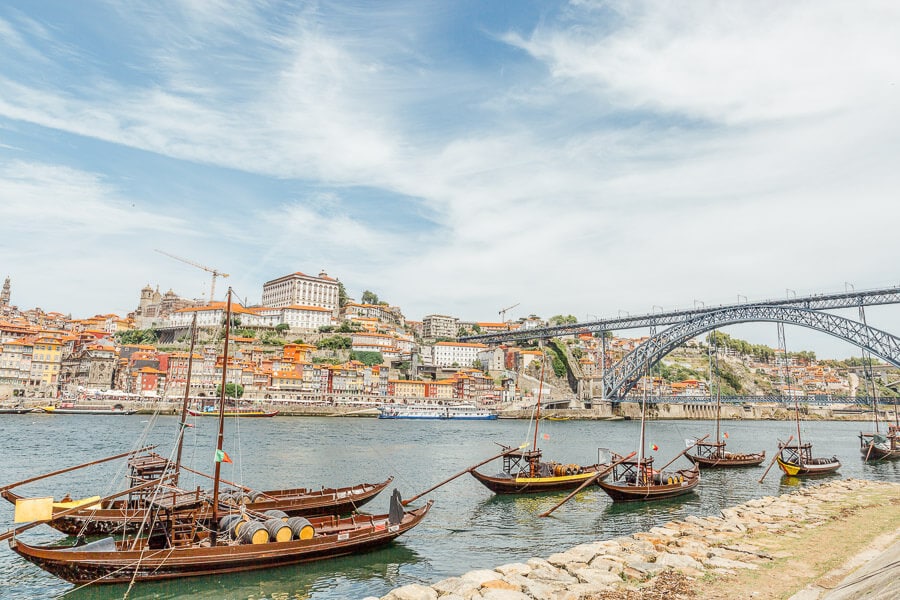
Life in Portugal’s second city revolves around the Douro River, giving Porto some of its most famous landmarks including its handsome bridges and medieval Ribeira (riverside) district, with its colourful merchant houses and historic cafes .
Do as Porto’s wine merchants once did and let the trade winds whisk you through the city. A boat trip on the Douro is the perfect way to tour the top sights and learn what makes Porto one of the country’s most interesting cities .
In the past, rabelo – low-slung wooden cargo boats – were used to transport barrels of Port wine from the vineyards in the country’s interior to the city and onward to the shipping docks. A fleet of colourful rabelo now float the same historic route, taking visitors down Porto’s life-giving river and showing off the best of the city from a unique perspective.
A typical boat tour of Porto covers the famous ‘Six Bridges’ including Ponte D. Maria Pia, Ponte Infante Dom Henrique and Ponte de Dom Luís I, the Gaia caves, and the Cabedelo Nature Reserve. You’ll see the Foz do Douro, where the river empties out into the Atlantic Ocean, and the Barra do Douro with its dazzling lighthouse.
Take a day trip to the splendid Pena Palace
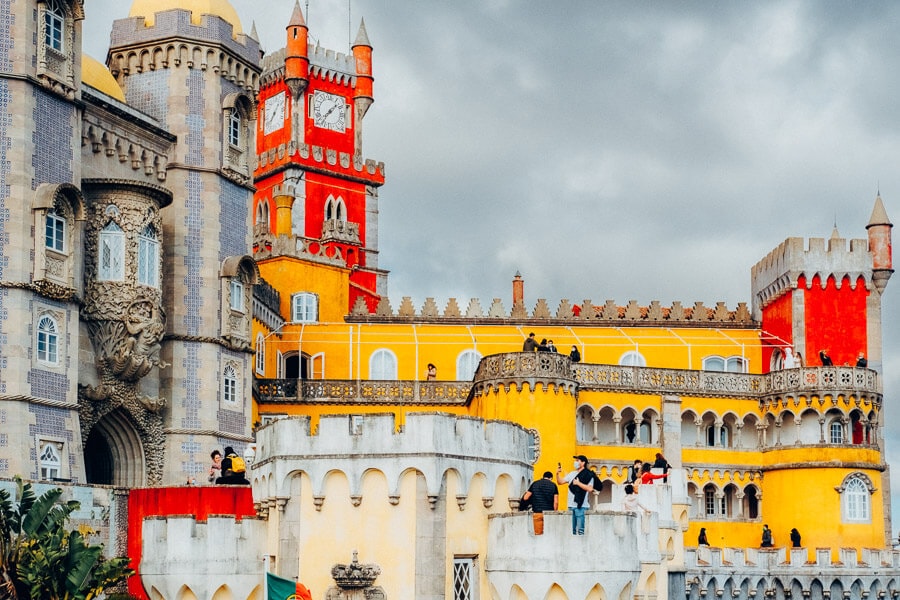
Pena Palace (Palácio da Pena) is one of the most popular tourist attractions in Portugal and a highlight of Sintra, a convenient day trip from Lisbon. Considered one of the finest expressions of 19th-century Romanticism in Europe, it’s both a UNESCO World Heritage Site and one of the Seven Wonders of Portugal.
Set atop a hill and enveloped by green forest (200 hectares of which is the royal garden), Pena Palace is instantly identifiable because of its bright red, yellow and mauve facades, scalloped white trimmings and pointed turrets. It might look cartoonish in photos but seen up close in person, it’s very lavish indeed – especially the painted interiors, which were used as a summer royal residence for Portugal’s ruling family.
A Sintra day trip is very easy to organise, travelling by train on the CP-Sintra line from Lisbon. Pena Palace is a 30-minute bus ride from the railway station.
Alternatively, a combination Sintra, Cabo da Roca and Cascais day tour from Lisbon is a good choice if you’re on a tight timeline. Other noteworthy landmarks in the area include the National Palace on Sintra’s central square, Monserrate Palace and the Moorish Castle, later on this list of things to do in Portugal.
Pena Palace tickets: Pre-purchase your tickets online and skip the queue.
Listen to Fado music in Chiado, one of the best things to do in Portugal for local culture
Recognised as part of UNESCO’s Intangible Cultural Heritage of Humanity, Fado is a beloved Portuguese tradition that incorporates music, lyrics and movement. For an insight into the nation’s seafaring heritage, watch a live Fado performance in Chiado in Lisbon where Fado has been humming in the streets for more than 200 years.
Though its exact origins are a bit of a mystery, it’s widely believed that Fado emerged in the mid-1800s at a time when Portuguese mariners were undertaking their most daring sea voyages to the New World. Singing and dancing became something of a ritual for sailors as they searched for a reprieve from their stressful day jobs.
Somewhat ironically, much of Lisbon’s Fado music is soulful and almost mournful. Coimbra Fado, by contrast, is more upbeat – apparently it was devised as a way for male students at the university to woo their female counterparts!
Fado is most commonly associated with Lisbon’s old Alfama and Mouraria districts. In the beginning the singers were all male, but today it’s women who take the lead, reciting stirring melodies that transport listeners to another time and place, accompanied by 12-string guitars and violas. Bars and restaurants in Alfama and Bairro Alto host Fado performers, and the popular Fado in Chiado theatre stages shows every night of the week.
Experience Fado: Folk music performances in Lisbon .
Tour one of the world’s oldest universities in Coimbra
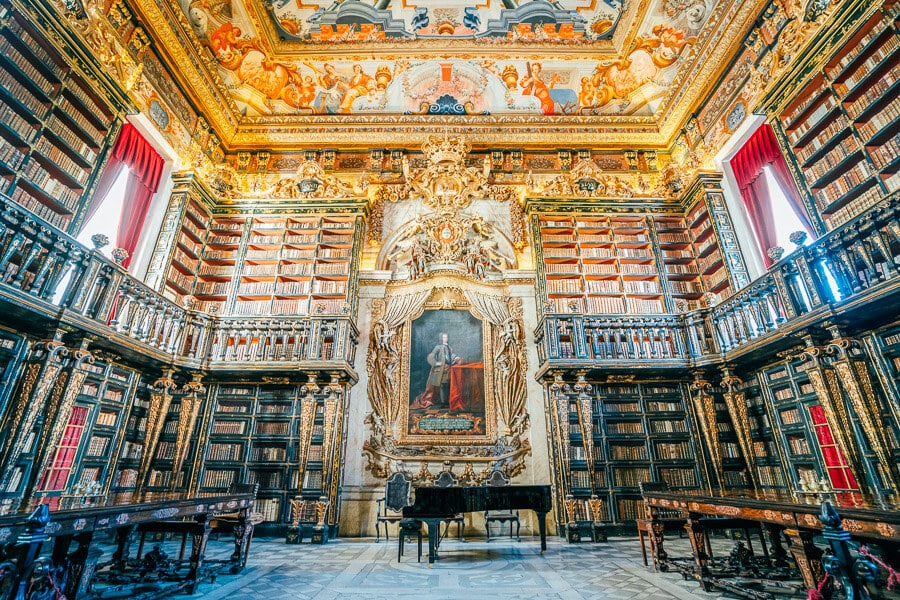
Have you ever been to a university that is a combination of a palace, a church and has strong vibes of Harry Potter ’s Hogwarts? If you haven’t, it’s time to add Coimbra University to the long list of things you must do in Portugal.
Coimbra is the biggest city in Central Portugal. You can easily reach it by train from Lisbon in about two hours or Porto in about one hour, or stop here on your road trip from Lisbon to Porto . There are many historical monuments in Coimbra but the university campus, designated as a UNESCO World Heritage Site in 2013, is the most famous.
With a history dating back to the 13th century, this stunning university is actually the oldest of its kind in Portugal and one of the oldest in Europe . It is located in what used to be a royal palace and has many interesting treasures to explore as well as commanding fabulous views of Coimbra and the Mondego River.
Some of the most interesting places on the university campus are the Capela de São Miguel, with its beautifully decorated ceiling and walls, the chambers of the palace, and the rooftop balcony that offers excellent views of the area. One place you must visit is the Biblioteca Joanina. Walking into this ancient library feels like stepping into a movie set: all golden decorations, a piano, and a resident colony of bats!
You can visit Coimbra University by yourself if you wish, but it’s best to take a tour to learn about the history and secrets that hide in the various chambers. The university organises guided tours. Note that if you buy your own tickets, there are two types – make sure you buy the one that includes a visit to the library.
By Maya from Chasing Lenscapes
Pre-purchase your Coimbra University tickets: These skip-the-line tickets include an in-depth 90-minute tour of the main halls and the Biblioteca Joanina.
Take a stroll in the enchanting Bucaco National Forest
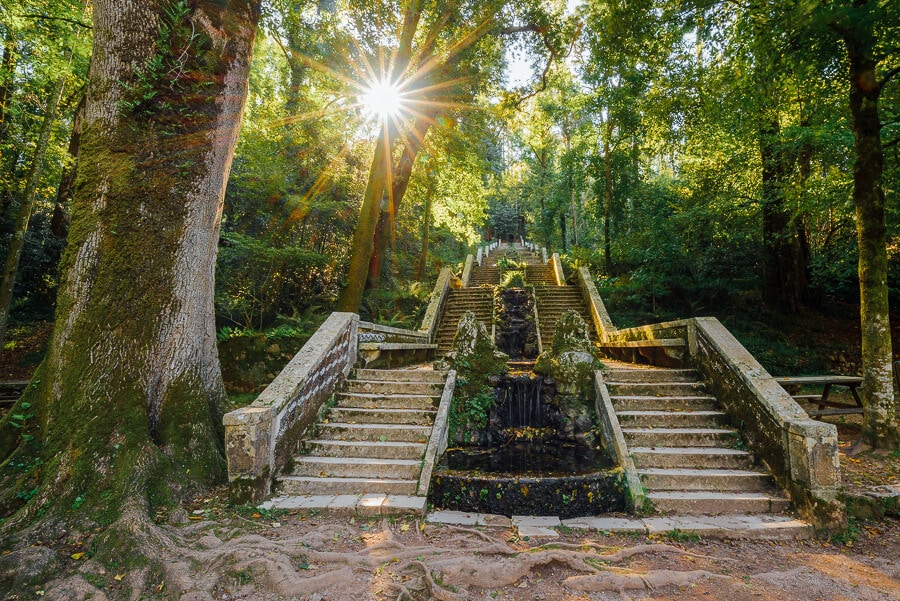
Located roughly 30 kilometres (19 miles) north of the historic city of Coimbra, the Buçaco National Forest is a true gem in Portugal. This 105-hectare green space houses one of the most remarkable tree collections in Europe, including species dating back to the Portuguese Age of Discoveries (around 500 years ago).
In the 17th century, the forest was settled by the Order of Discalced Carmelites – though it was previously inhabited for centuries before that. The monks built its walls, little chapels that are still standing today, and a convent that was supposed to be converted into a royal palace but is now a unique luxury hotel, the Buçaco Palace.
The best way to explore the forest is by foot, walking at least one of the many trails that take you through this enchanted place. Be sure to grab a map at the information centre (Posto de Turismo do Luso-Bussaco) as it will be very useful. Some of the points of interest you can’t miss while wandering through Buçaco are the Buçaco Palace, Fonte Fria fountain, and Portas de Coimbra (Coimbra Gate).
The most convenient way to get to the forest is by car, so this is a great opportunity to take a scenic road trip through central Portugal .
By Or from My Path in the World
Drink Port wine in the Douro Valley

If you’re in Portugal and you haven’t tried Port wine, have you even been to Portugal at all?! A tasting of the nation’s most famous export is an absolute must, and the best place to do it is the Douro Valley outside Porto, one of Europe’s most famous wine regions .
There are many advantages to doing a wine tasting in the Douro Valley rather than in Porto city. In Porto, you will only find overpriced touristy Port tastings; whereas in the Douro Valley, you will be able to visit centuries-old wine estates ( quintas ) in person. The acres and acres of vineyards here are incredibly picturesque and give visitors the chance to really immerse themselves in Portugal’s winemaking traditions.
The best way to visit the Douro Valley is through an organised tour from Porto. This one by Living Tours includes two different quintas, a boat tour on the Douro river, and a generous lunch. It’s also possible to rent a car and visit multiple quintas on your own. But that would mean you can’t drink port – so a tour is definitely the preferred option here!
By Lara from The Best Travel Gifts
Best Douro Valley tour from Porto: This itinerary by Living Tours includes tastings with the winemakers, a regional lunch, and spectacular views of the terraced vineyards.
Hike the Seven Hanging Valleys Trail in the Algarve

There are few better ways to appreciate the beauty of the Algarve coastline than by foot. And thankfully, there are several stunning walkways you can take to explore one of Portugal’s premier beach holiday destinations from a different perspective.
One of the most popular walks along this stretch of sun-kissed shoreline is the Seven Hanging Valleys Trail . At just under 12 kilometres (7.5 miles) out and back, it’s an easy half-day hike, or you can do it over a full day and enjoy the many beaches you’ll pass along the way.
Beaches aside, there’s plenty to see along the path such as natural grottos (including the famous Benagil sea cave), rock arches and bridges, sea pillars, and a lighthouse.
The family-friendly hike is described as moderate, and can be hard going in the heat of the summer months, so do yourself a favour by hiking in autumn instead. At this time of the year, you’ll enjoy sublime temperatures, fewer crowds, and won’t have to jostle for a parking spot.
You can complete the track in either direction, starting at Praia Vale de Centeanes or Praia da Marinha. If you don’t fancy retracing your steps it’s possible to just do it one way and catch a cab or Uber back to your car.
By Nadine from Le Long Weekend
Kayak through the Benagil sea cave
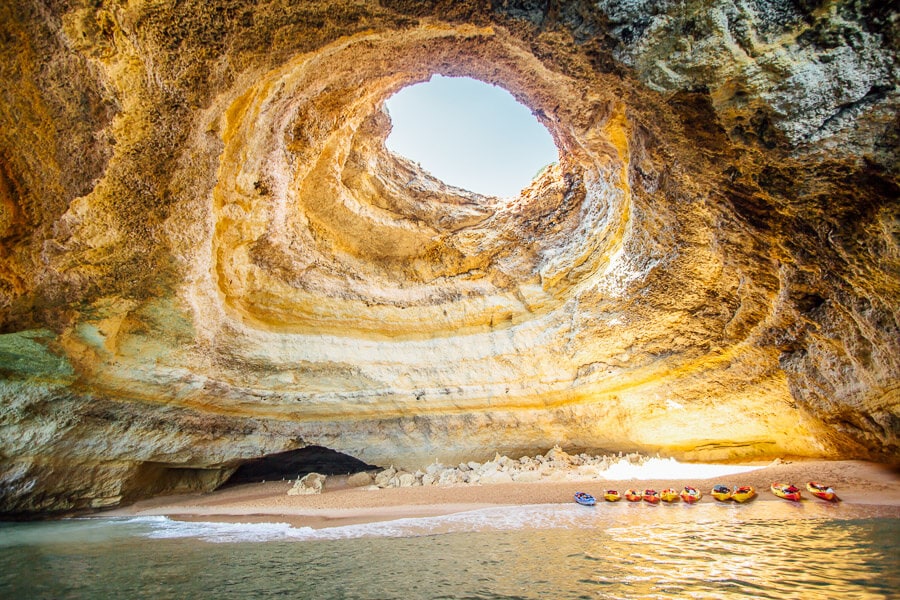
Out of all grottos that dot the southern Portuguese coast, the Benagil cave is the most captivating. That’s because, in addition to the lateral erosion caused by the pounding waves, the rain has worn away the top of the cave. The result is a natural skylight that illuminates the cavern and the beautiful patch of white sand that lies inside.
The fenced area around this ‘eye’ allows visitors to peer inside from the top of the cave. But to truly experience the magic of the Benagil grotto, you need to access it from the water.
Instead of hopping on one of the small tourist boats that pass through the cave, you could join a Benagil cave tour by kayak or SUP. Most of these tours are organised in the morning, allowing you some time to enjoy this mesmerising cave without the constant boat traffic. The beauty of arriving by kayak or SUP is that you’re allowed to actually set foot on the gorgeous beach – a privilege that boat visitors don’t have.
A kayak or SUP tour typically lasts around two hours and takes you to see several intriguing sea caves along the coastline. It can be quite intensive, depending on the water conditions, but a support boat with a lifeguard tags along and can tow your kayak if necessary.
By Sarah from CosmopoliClan
Try it: Book your Benagil cave kayaking experience with Secret Algarve.
Swim in a natural hot spring in the Azores
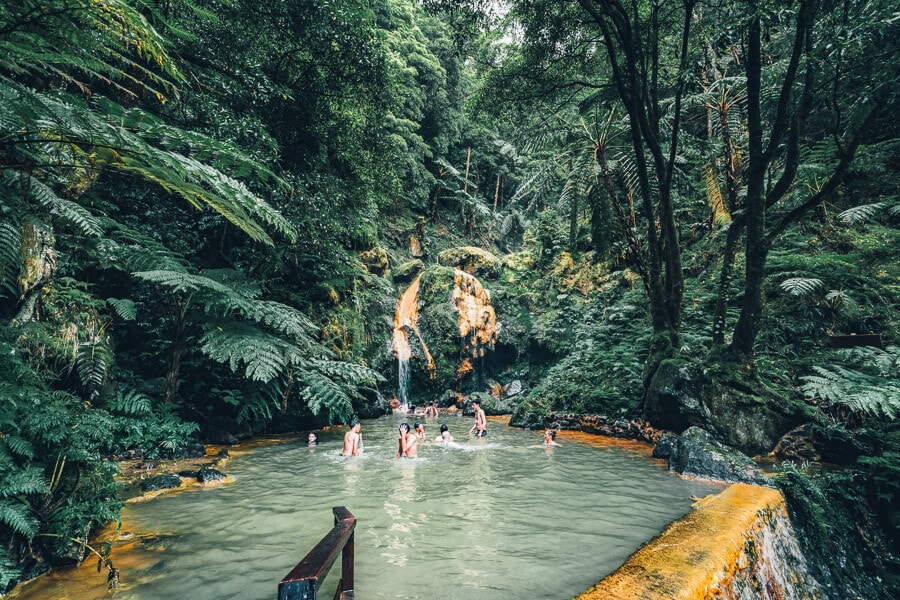
One of the most exciting things to do in Portugal is experience the hot springs on the Azorean island of São Miguel. The largest of the Azores – a chain of islands in the Atlantic Ocean and an autonomous region of Portugal – São Miguel has a wide selection of hot springs to enjoy.
There are several different geothermal springs on the island, each with its own unique feel. Terra Nostra is probably the most famous, known for its large spring-fed pool that is so rich with iron and other minerals that the water is almost golden in colour. Terra Nostra also has smaller springs as well as a botanic garden and a restaurant where you can eat cozido , an Azorean stew cooked underground using geothermal heat (look out for it later on this list).
Another cool spot is in Ponta da Ferraria, where a hot spring meets the ocean just where some rocks make a natural pool. You’ll have to time the tides just right – otherwise it can be too hot or too cold – but it’s a magical experience feeling the water’s temperature ebb and flow as the hot spring water mixes with the brisk Atlantic waters. Best of all, it’s free!
Should you want even more soaking time on your Sao Miguel itinerary , there are several other hot springs in the Azores also worth mentioning, including Poça da Dona Beija and Caldeira Velha.
Tip: Bring a dark-coloured bathing suit to enjoy the hot springs in the Azores – lighter suits may get stained by the mineral waters.
By Allison from Eternal Arrival
Experience it: Evening tour to Furnas for hot spring bathing at Poça da Dona Beija as the sun sets plus a traditional dinner under the stars.
Go hiking at sunrise on Madeira Island
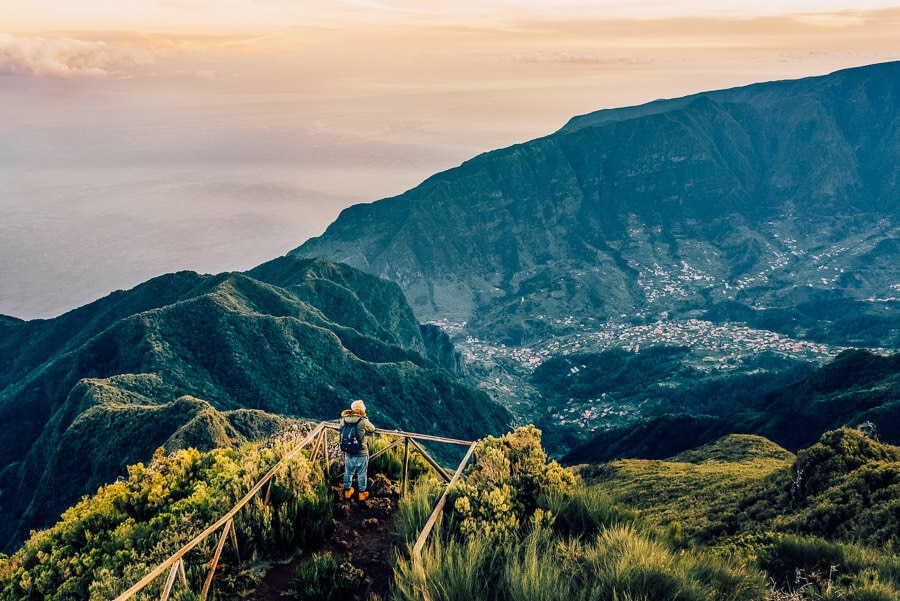
Portugal’s second autonomous island region, Madeira, comprises four islands, each with a subtropical climate and breathtaking landscapes of volcanic rock formations, dramatic cliffs and pebble beaches. It’s no secret that Madeira boasts some of the most beautiful hiking trails in Europe , many leading to high-altitude viewpoints for panoramic views of the cliffs and ocean.
From moderate and flat levada walks that take you through the island’s forested interior (a UNESCO World Heritage Site) to more challenging mountain summits that see you rise up above the clouds, Madeira is a hiker’s paradise.
The Pico Ruivo do Paul trail is an easy hike of 1.5 kilometres (just under 1 mile), taking around 45 minutes to complete. It culminates at a 1600-metre-high marked viewpoint where you are rewarded with spectacular views down to the water’s edge.
One of the most adventurous things to do in Portugal is to set out for sunrise on another popular but longer trail that links the island’s two highest points, Pico do Areeiro and Pico Ruivo. This Madeira hike is more strenuous, taking around 7-9 hours to complete the 15.6 kilometres (9.7 miles).
Ride a moliceiro boat in the quaint town of Aveiro
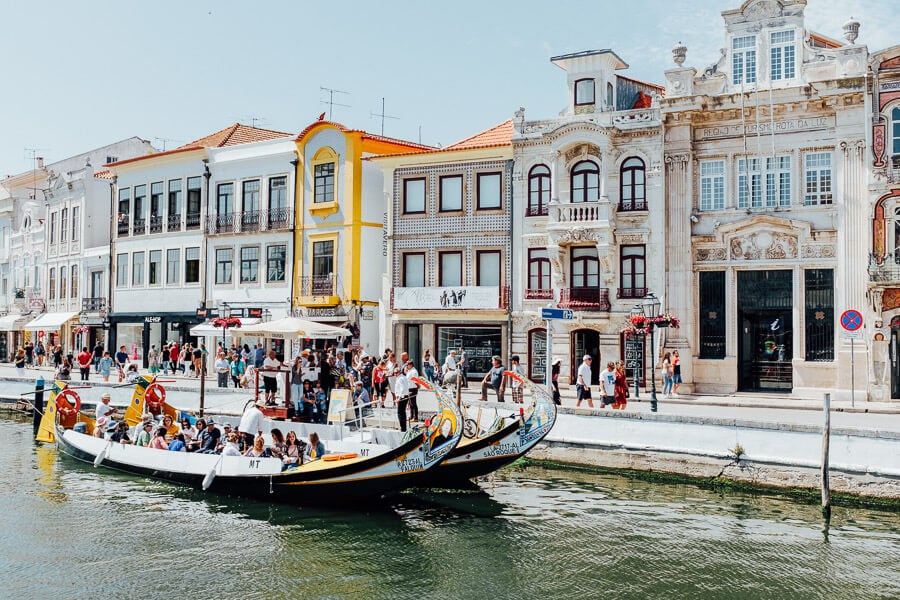
One of the best day trips from Porto is to Aveiro, a charming town known for the gondola-style boats that roam the canals. With a long history, it’s a cultural wonderland with plenty of sights and culinary experiences thrown in for good measure.
Just an hour from Porto by train, Aveiro is easy to reach and explore on foot. The main activity is riding one of the colourful molicero boats. These were originally used to farm seaweed and keep the region fertile, although they’re now more of a popular tourist attraction. A short ride will set you back €5-10.
Another place to visit is the nearby Costa Nova, a small beach town with Instagrammable huts painted in every colour of the rainbow. It’s easy to reach Costa Nova from Aveiro by hopping on a bus or hailing a taxi.
Finally, don’t miss indulging in Aveiro’s culinary gems. Ovos moles are traditional snacks from Aveiro made with sweetened egg yolk in wafer. Many cafes sell them, but there’s nowhere better than Confeitaria Peixinho where they have been made since 1856. Try the ones shaped like mini molicero boats!
By Rose from Where Goes Rose
Try it: Aveiro moliceiro experience with a visit to the Aveiro salt pan, the old Beira-Mar, neighbourhood, the Jerónimo Campos ceramics factory, and the Fish Market.
Go azulejo hunting in Porto
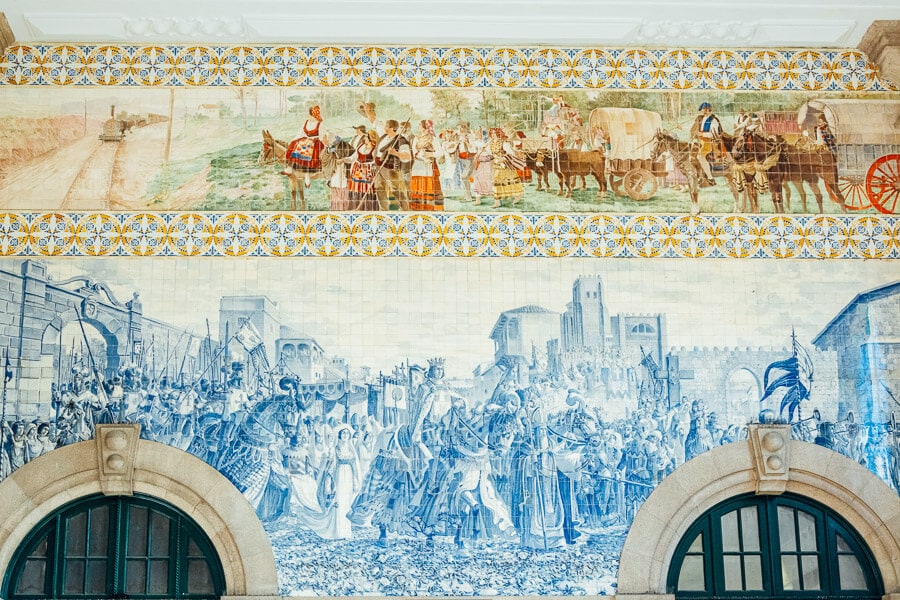
Discovering the gorgeous azulejo tiles is one of the best things to do in Porto , Portugal. The word ‘azulejo’ stems from the Arabic al zellige , which means ‘polished stone’. You will find these glazed ceramic tiles almost everywhere in Porto – from churches to railway stations, fountains to benches. Azulejo is a very important part of Portugal’s cultural heritage.
King Manuel I of Portugal brought this art form to this country in the 15th century from Seville, Spain . Initially tiles used simple geometrical patterns, but over time the repertoire transformed into a more intricate and decorative art form depicting religious stories and the history of the nation. You will mainly find these tiles in blue and white. Shades of yellow and green are also common.
You can easily explore Porto’s azulejos yourself. You will find some of the greatest works inside the Sao Bento Railway Station , where almost 20,000 azulejo tiles painted in the early 20th century by Jorge Colaco depict the history of Portugal and rural scenes. The work took almost 11 years to complete!
Other outstanding azulejos can be found at the Porto Cathedral, Igreja do Carmo, Capela das Almas, Igreja de Santo Ildefonso and the Casa da Musica.
By Moumita & Sankha from Chasing the Long Road
Alternative experience: Try a tile-painting workshop where you’ll learn about the history of azulejos while hand-painting your own souvenir tiles.
Browse the beautiful Livraria Lello bookshop in Porto

Located in the heart of Porto, the Livraria Lello is considered one of the most beautiful bookstores in the world. J.K. Rowling, author of the famous Harry Potter series, was famously inspired by it when writing her novels – she regularly visited the bookstore in the 1990s.
Founded in 1906 by the Lello brothers, the Livraria Lello, which is today one of the most famous Portuguese landmarks , attracts plenty of tourists thanks to its amazing design. Even before entering the bookstore, the white facade that combines Art Nouveau and neo-Gothic styles is quite stunning.
The exterior is certainly eye-catching, but it’s the store’s stunning interior to which the Livraria Lello owes its fame: the walls, lined with large bookcases from floor to ceiling, abound with volumes in all languages. The high point is definitely the iconic red spiral staircase.
This bookstore is so popular that an entrance fee is now charged (it costs €5, but the ticket price is deductible if you buy something inside). In any case, it’s a good idea to purchase your tickets in advance – otherwise you’ll have to queue twice: first at the ticket counter and then again to enter the bookstore. Try to visit in the morning to avoid the crowds on the staircase.
By Nesrine from Kevmrc Travel
Explore Tomar, Batalha and Alcobaca, the trio of UNESCO World Heritage Sites in Central Portugal
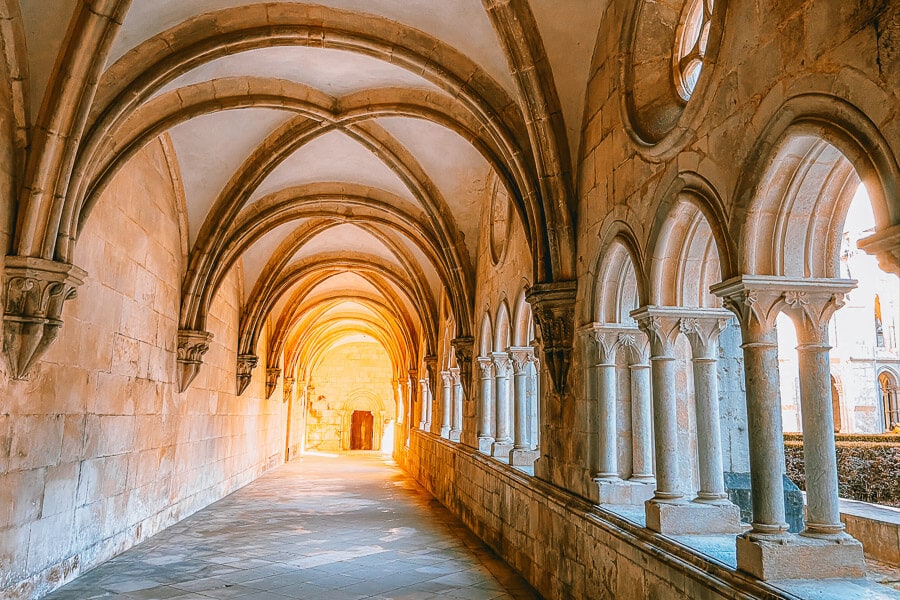
One of the best things to do in Portugal is visit the country’s UNESCO World Heritage Sites. There is a trio of monuments located in Central Portugal that can be visited in one day as they are all located within an hour of one another.
The three UNESCO World Heritage Sites are the Convent of Christ in Tomar, Alcobaça Monastery, and the Monastery of Batalha. The first, the Convent of Christ in Tomar was originally a 12th-century Knights Templar stronghold until its dissolution in the 14th century. The Knights of the Order of Christ, as the Templars became in the 15th-century, continued at Tomar and aided Portugal in its maritime explorations during the Age of Discoveries. The site consists of both a convent and a castle built in the Romanesque, Gothic and Renaissance styles.
The Monastery of Batalha is a Dominican monastery originating in the late 14th century. It contains examples of Gothic and Manueline architecture styles. Alcobaça Monastery is a 12th-century monastic site credited with introducing Gothic buildings to Portugal.
All three sites are rich in architecture and history. All can be visited as part of a day trip tour from Lisbon if you are travelling in Portugal without a car. There is a discounted ticket for entry to all three sites which is valid for one year.
By Cath from Passports and Adventures
Day tour option: Book a private day trip from Lisbon with transfers and skip-the-line access to the monasteries.
Walk the medieval walls of the Moorish Castle in Sintra
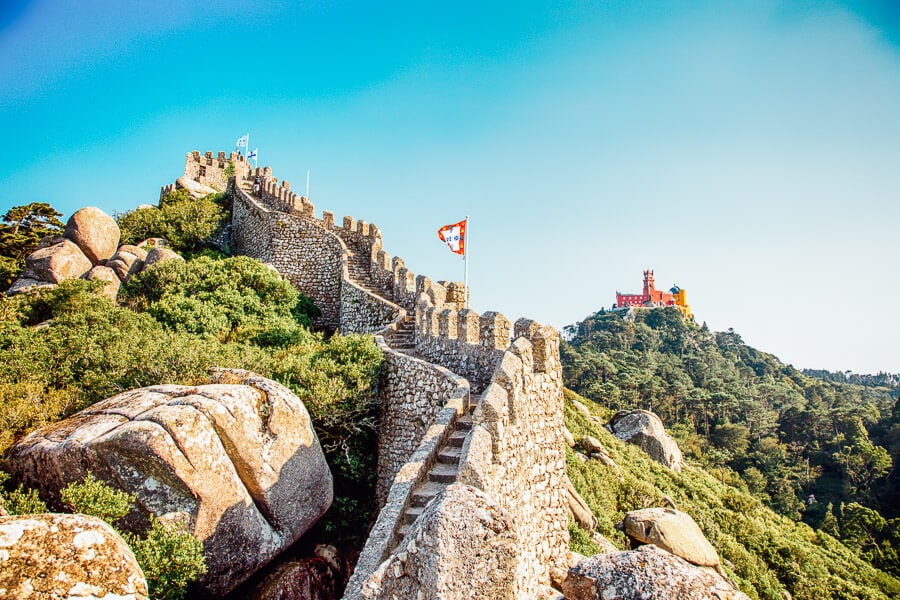
Castelo dos Mouros (the Moorish Castle) is located in Sintra. Like the Pena Palace, it sits high on a craggy outcrop and can be seen for miles around. It’s less touristy than Pena and a more relaxing experience. Its rich history and spectacular views earn the Moorish Castle a spot on the best Sintra tours from Lisbon .
The Moors reigned from the 8th to the 12th centuries in Portugal and during this time, the strategic location of this very large castle (directly above the town) meant that it was the defensive centre for the whole Sintra region. This was also true during the later Christian rule of Sintra.
Make sure you stroll around the formidable castle walls and see the 12th century Igreja de São Pedro Chapel. From atop the walls there are incredible views of the Sintra mountain range.
This castle is also an unforgettable sight when you see it from a distance. The Royal Tower of Sinta (Torre Real) is the best place to view the castle from afar. Walking from the Pena Palace to the Moorish Castle is a wonderful experience, but there is also a regular bus service.
By Paula from Portugal Travel Hub
Explore the old town in Obidos
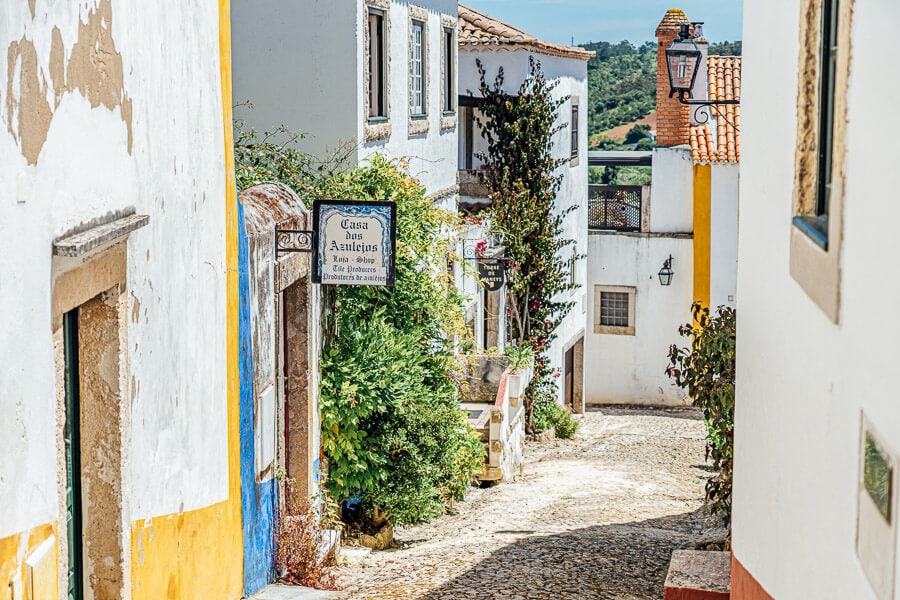
Only an hour’s drive away from bustling Lisbon (making it a great spot on a Portugal road trip ), the sweet, fairytale village of Obidos is a must-see in Portugal. The town is still surrounded by fortified walls and was actually gifted from King Denis of Portugal to his Queen for their wedding in 1282.
Medieval cobbled streets lined with small shops and whitewashed houses are a perfect backdrop for photos. A must-do in Obidos is to try the famous sour cherry liquor, Ginjinha de Óbidos , which originated with 17th-century monks from the region who combined brandy with Morello cherries. It’s traditionally served in little edible chocolate pots to taste for only €1 – and it’s simply delicious. Trust me, you’ll want to purchase a bottle to take home with you.
After you’ve wandered the beautiful streets, don’t forget to check out the well-preserved Obidos Castle. It’s a great place to walk around and you can even stay the night if you feel like treating yourself!
By Cazzy from Dream Big Travel Far
Explore Obidos: History tour of the village and Jewish neighbourhood with a Ginjinha tasting .
Go beach-hopping in Lagos
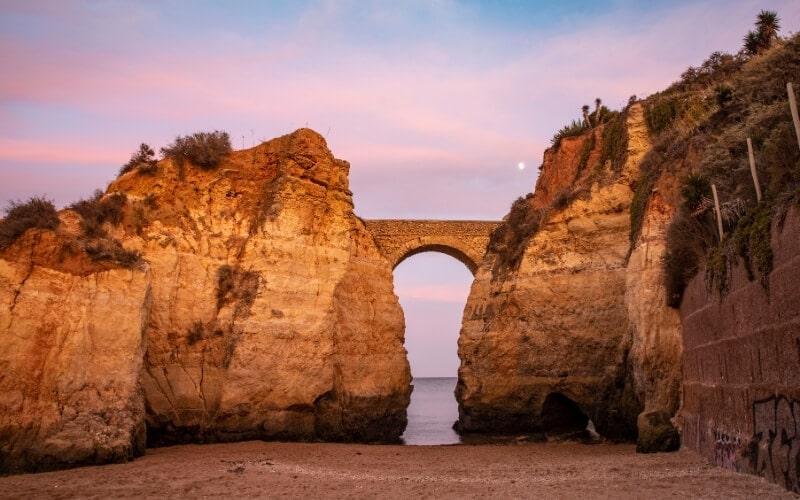
Portugal’s southernmost region of Algarve is known for its golden sandy beaches, secluded swimming coves, rugged cliffs and sculptural sea caves. If you’ve come to Portugal in search of surfing, swimming or sunbathing, a tour of Lagos’s stunning beaches is something not to be missed.
The coastal city of Lagos is the ideal spot for a balance of city and surf. From lounging to exciting water sports, there is no shortage of activities to keep you entertained. Beach-hopping is indisputably the thing to do in this part of Portugal. Highlights include Praia dos Estudantes (‘Students’ Beach’), one of the most striking beaches thanks to the Roman-style bridge – once part of a now-fallen fortress – that stretches out between two rock formations over the ocean. The quiet cove here is ideal for frolicking in peaceful tides.
Meia Praia beach is an enormous stretch of sand just outside Lagos. Spanning a monumental 4 kilometres (2.5 miles), it’s never too difficult to find space to stretch out your towel here.
Visit the anchor cemetery on Tavira Island
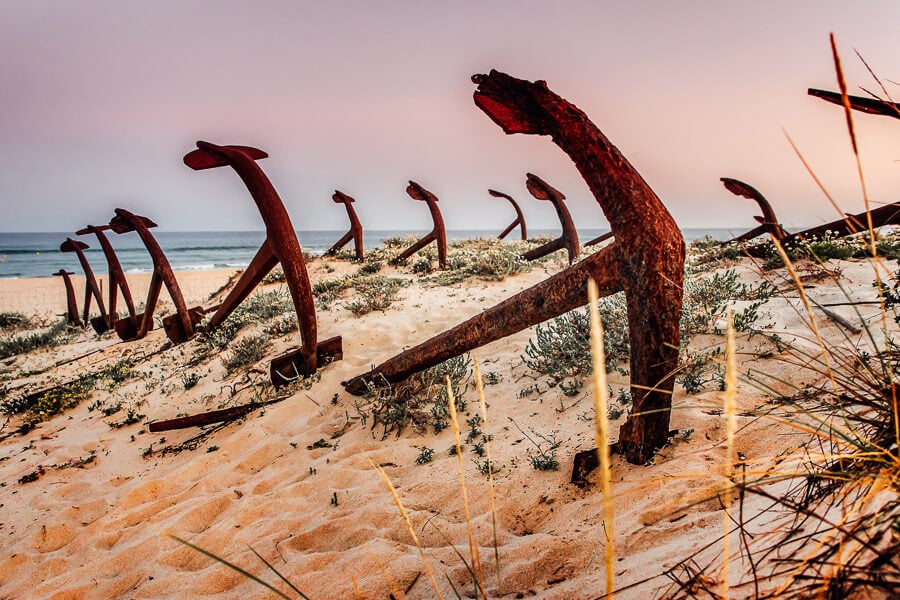
One of the quirkiest attractions in Portugal is the anchor cemetery on Tavira Island. On the sand dunes cascading into Barril beach , there are more than 200 large, rusty anchors. They were once used in tuna fishing when the island was a base for fishermen during the season. When the tuna population declined, the fishermen abandoned their anchors on the beach.
To this day, nobody really knows who collected them all and lined them up – but the truth is, whoever it was did the area a huge favour! Now, instead of being an abandoned location with old tumbledown fishing shacks, it has become one of the most popular tourist attractions in Tavira.
The fishing shacks have been transformed into busy restaurants and cafes, and the old train line that transported the tuna is now being used to ferry tourists on a small scenic train. It costs €1.50 one-way and takes you from the footbridge by Pedras d’El Rei, connecting the mainland with the island, over to the anchor cemetery.
Alternatively, you can walk a 1.3-kilometre-long trail next to the train line. There are also boats and ferries taking visitors from Tavira to the island. Unless you go on a private boat tour, you will be dropped off at Tavira beach. You then have to walk along the beach for 5 kilometres (3 miles) to reach the anchors.
By Linn from Amused by Algarve
Visit the Capela dos Ossos ‘Bone Chapels’ in Evora & Faro
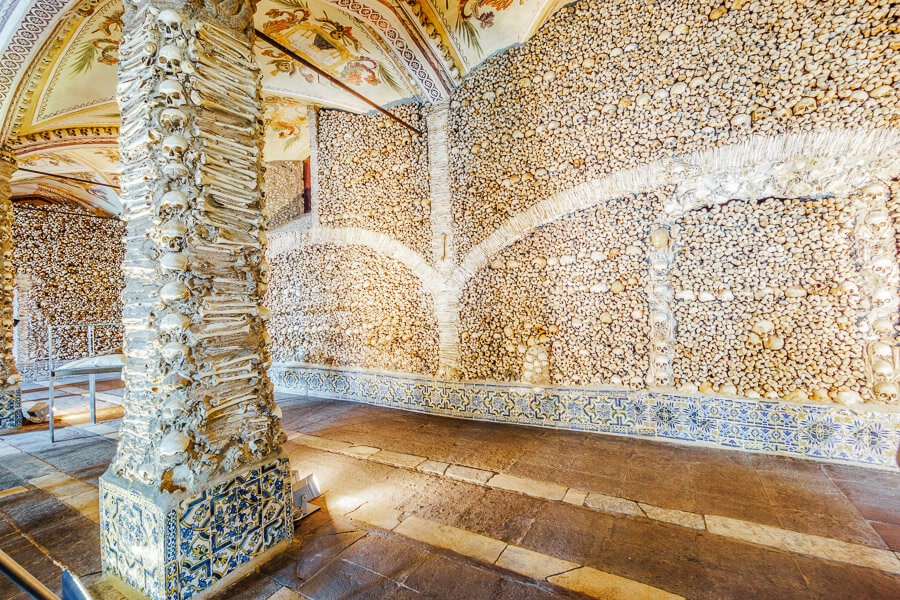
Many visit Portugal for the beaches, the food and the epic palaces – but there is something more off-beat that draws visitors to Portugal: a visit to the famous Capela dos Ossos or ‘Bone Chapels’.
Some will consider these unique religious sanctuaries a dark tourism destination , and while they are not for everyone, they are a very interesting (if not a bit macabre) site. The two most popular bone chapels in Portugal are at Evora and Faro. Both are very different from one another and for many visitors, places they never forget.
The Evora Bone Chapel, the larger of the pair, is located near the Igreja de São Francisco Évora Chapel (St. Francis Church). Crafted from the bones of more than 5,000 individuals, the chapel measures 18 metres long and 11 metres wide. The bones are laid out expertly, with skulls positioned in the interior as rousing decorations.
The second Capela dos Ossos, the Faro Bone Chapel, is located in the town of Faro within an unsuspecting church, the Igreja Do Carmo, in a small square. The tiny bone chapel is located at the rear of the church off a beautiful garden. This bone chapel is a complete contrast to the Evora Chapel in that it’s only 5 metres long and just over 2 metres wide.
By Bec from Wyld Family Travel
Walk part of the Portuguese Camino de Santiago
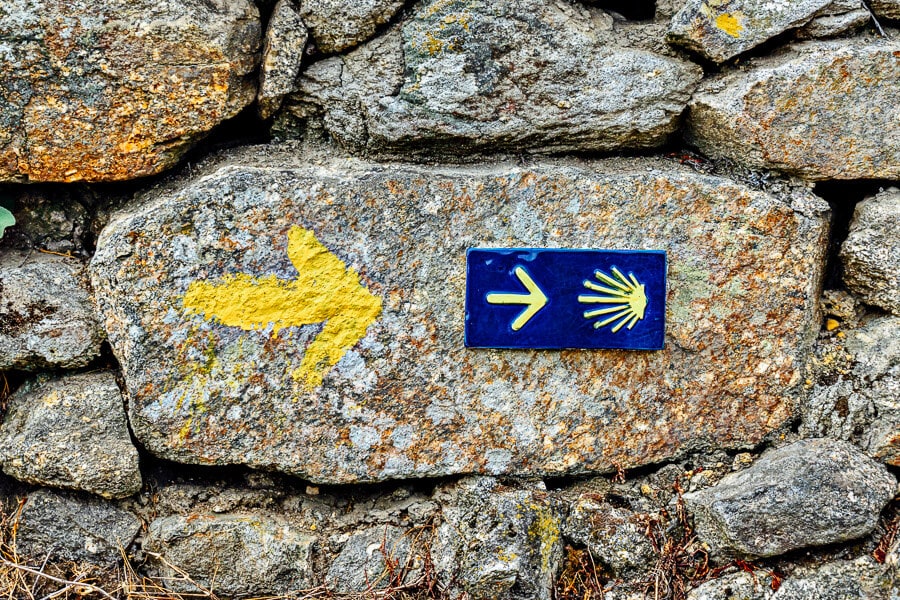
Walking the Portuguese Camino de Santiago is an amazing cultural experience and a great way to discover the country. The Portuguese Camino is the second most popular Camino route; about 100,000 people accomplish it every year.
Starting in Lisbon and finishing in Santiago de Compostela in Spain, the total distance of the Camino from Lisbon is 630 kilometres (391 miles). It takes 30 days to complete. Many people start walking the Portuguese route from Porto, which reduces the distance to 260 kilometres (162 miles). The way is marked with yellow shells and arrows.
Spring is the best time for walking the Portuguese Camino. The weather is nice, it’s warm and sunny, there are not too many tourists, and fields and hills along the route are covered in wildflowers.
Crossing a country on foot, visiting both well-known attractions and off-the-beaten-path places, is a truly unique way of travelling. Some of the highlights of the Portuguese Camino include Lisbon, Santarem, Fatima, Tomar, Coimbra, and Porto.
The best thing about the Camino is that anybody can do it. There are no rules or limitations – you can complete the entire Camino or walk only a section, carry your own backpack or use a luggage transfer service.
By Alya from Stingy Nomads
Learn to surf in Nazare
Nazare on the Costa da Prata is a magical place, even more so if you’re a surfer searching for the best waves on earth. Pros and novices alike have wet dreams of the legendary Nazare waves. Riding in Nazare’s cold Atlantic water and frothy white surf is about as refreshing and exhilarating as it gets.
According to the Guinness Book of Records, Praia do Norte (North Beach) in Nazare is home to the world’s largest waves ever surfed. The wide beach is just the place for experienced surfers hoping to ride one of Nazare’s legendary monster waves, which often reach up to 30 metres (almost 19 miles) high.
The lighthouse on the cliff above Praia do Norte is the best vantage point to watch these giant waves and the gutsy surfers living their best lives. Inside the lighthouse is a cool surf museum with paraphernalia and quotes from famous surfers who braved the monsters and lived to tell the tale.
Nazare is a great place for beginners, too. There are several surf schools and camps in town to choose from. Instructors will ease you into things and build up your confidence on the town beach with smaller waves. When the time is right, you will join the legends of Praia do Norte.
By De Wet & Jin from Museum of Wander
Go stargazing in Monsaraz
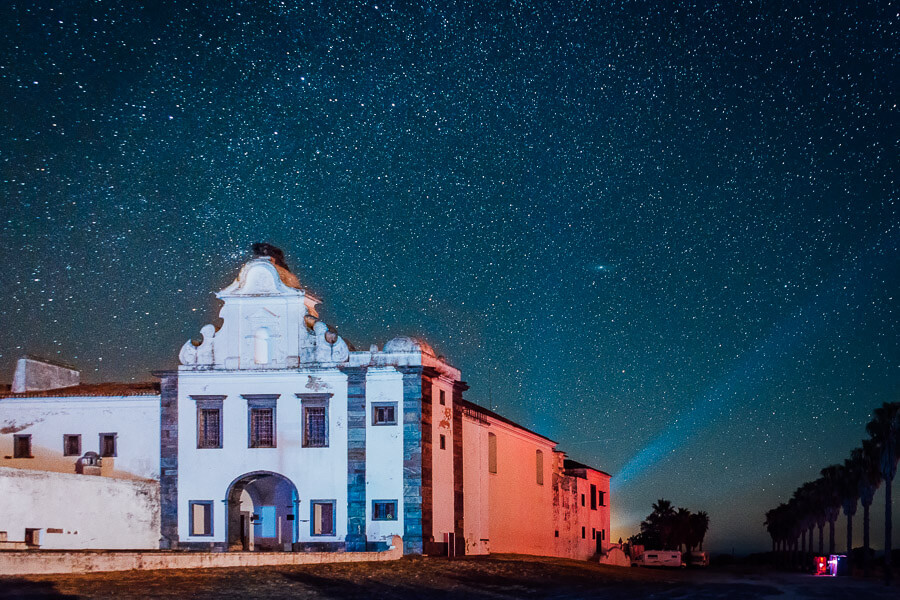
Right in the middle of the famous wine producing region of Alentejo in Portugal is an internationally certified Dark Sky Reserve, the first in the world to be recognised as a UNESCO ‘Starlight Tourism Destination’. The inky skies above Alqueva is a wonderful natural planetarium where there is almost no light pollution, making the whole area wonderful for star-gazing. It’s a must visit on any road trip of Portugal .
On the edges of the hauntingly beautiful Alqueva Dam is the walled town of Monsaraz, home to the Observatorio do Lago Alqueva. Here you can learn about the Portuguese night skies and spend a few hours with their telescopes observing the constellations and planets of the solar system and the craters of the moon.
The quality of the Alqueva sky enables naked eye observation of a large number of celestial bodies. Your tutor for the evening will bring the sky to life. You’ll find out about the history of astronomy and how the first scientists discovered the stars and planets, how they were named, and what is known about each of them.
On the right night, and with the right conditions, the velvety sky above Monsaraz may even show you the Milky Way, a hazy band of light seen in the night sky, formed by stars that cannot be individually distinguished with the naked eye. Make sure to bring your camera – you can take images through the telescope for an amazing reminder of your dark skies experience.
By Izzy & Phil from The Gap Decaders
Explore Portugal’s oldest and largest Natural Park, Serra da Estrela
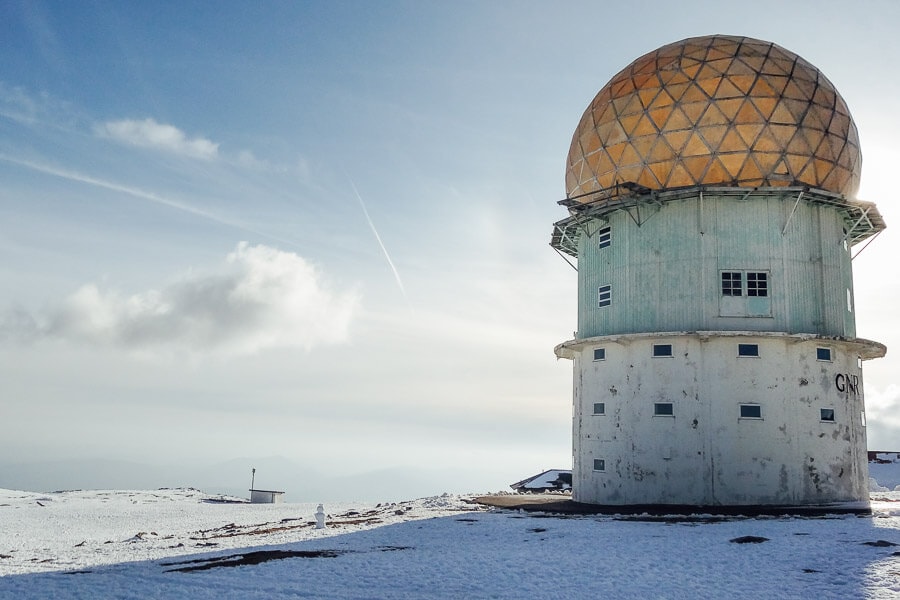
Located in the central part of Portugal, Serra da Estrela Natural Park is a mountainous area that contains the highest peak in continental Europe, known as the Torre. It has another claim to fame for being the first and the largest Natural Park in Portugal (though it doesn’t have the same status as Peneda-Geres National Park, the nation’s only Parque Nacional).
The Serra da Estrela is best visited by car or on a day trip with private transportation as access from the likes of Lisbon and Porto via public transport is not easy. There are several towns dotted around the foothills where you can stay.
Things to do in the Natural Park include taking the cable car down the valley to enjoy views across the Serra da Estrela mountains and beyond. There are also two towers with domed-shaped roofs that were former radar towers for the Portuguese Air Force. They make for great pictures. There is a retail building at the top of the mountain where you’ll find a restaurant and shops selling locally produced crafts and other products.
There are also walking opportunities, waterfalls to find, and a beautiful carving of the protector Saint of the Shepherds called Senhora da Boa Estrela etched into the rock face of the mountain.
If you are looking for unique things to do in Portugal outside of the main cities, jump in a car and head for the Serra da Estrela Natural Park. It is an area of stunning natural beauty and a place not to be missed.
By Cath from Travel Around Ireland
Day trip option: Excursion to Serra Da Estrela departing from Lisbon, Braga or Porto .
Join a Portuguese food tour in Lisbon

Portugal has a lot going for it: an agreeable climate, historical cities, beautiful beaches, and excellent wines including the finest Port wine in the world. Another undeniable national treasure is delicious Portuguese food .
For food travellers, one of the best introductions to the cuisine of Portugal is a dedicated food tour. Most cities around the country offer this experience, but the best place for a culinary exploration has to be Lisbon, Portugal’s food capital.
A walking food tour is no doubt the best way to experience not just food, but also the culture and history of the city. A visit to some of Lisbon’s more traditional local neighbourhood restaurants, cafes, food markets and small shops will give you an insight into how locals live and what they eat.
Most food tours last for around four hours and are a short but tasty introduction to local food specialties that will leave you wanting more. While there are food tours in Lisbon that focus on popular venues and markets such as the Mercado da Ribeira , it’s nice to opt for a smaller tour to discover off-the-beaten-path eateries only the locals know about.
As for the food you’ll try: bacalhau (salted and dried cod fish and Portugal’s National dish) will most certainly be on the tasting menu. Don’t miss caldo verde , sausage and kale soup, or Pastel de Nata – all must-trys when visiting Portugal.
By Lori from Travlinmad
Recommended Libson food tour: 10 tastings of Lisbon with locals .
Eat cozido on Sao Miguel
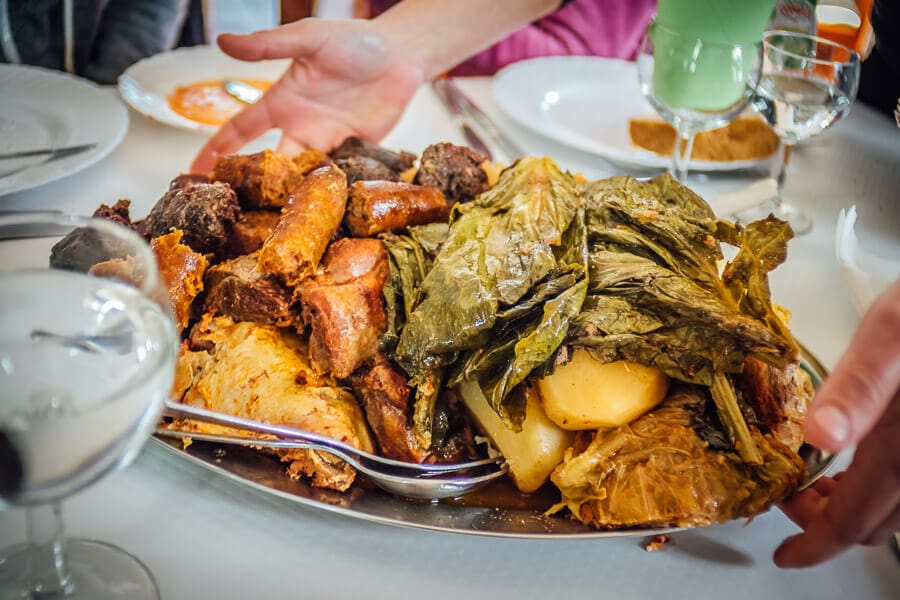
Furnas is located on the southeast side of Sao Miguel island in the Azores archipelago. The town, one of the most popular places to visit on Sao Miguel , sits in the remains of a long-extinct volcano and is the centre of the island’s geothermal activity. Home to hundreds of natural springs and streams, visitors have been coming here for centuries to try the mineral waters and thermal pools. They also come to eat cozido .
Cozido (also known as furnas ) is a traditional Portuguese stew made from beef, potatoes and vegetables including carrots and cabbage. Although you can find versions of cozido throughout Portugal, it’s only in Furnas that you will find Cozido nas Caldeiras . Literally translated as ‘cooked in the boiler’, this hearty meal is slow-cooked underground using volcanic heat.
At Furnas Lake there is a cozido cooking spot where local restaurants take their stews to be cooked. Each restaurant has a dedicated underground hole and the area is guarded by two men who are responsible for placing the pots in the ground and later removing them using long iron tongs.
It’s not only restaurants that can use the cooking spot, however – anyone can turn up with their pot and for a few euros have it placed underground. Most cozido are left overnight to cook but you can also take your homemade stew along in the morning and return to collect it 5-7 hours later. Bom apetite!
By Katja from Globe Totting
Go diving in the Algarve
Southern Portugal’s Atlantic coastline is just as breathtaking seen from underwater as from above. Naturally it’s home to some fantastic sites for scuba diving.
Diving conditions are great in the Algarve, with calm seas, good visibility, a rich biodiversity and a variety of interesting underwater attractions. Around the towns of Albufeira, Portimão, Lagos, Faro and Sagres there are a variety of dive sites for all skill levels. The colourful rocky reefs are covered in algae, anemones, soft corals and sponges. If you love marine animals you will not be disappointed diving here.
All dive sites are rich in fish life with sea bass, sea bream, groupers and plenty of other species on the reefs. Keep an eye out or your camera ready for interesting creatures including colourful nudibranchs, octopus, moray eels and even seahorses.
For wreck diving enthusiasts, the Algarve has plenty to offer ranging from old ships from the 1750s to a B-24 Liberator Bomber plane wreck from World War II. Several were purposely sunk to make artificial reefs. Ocean Revival Park in Portimão is a unique diving project where four Portuguese navy vessels were sunk deliberately at different depths to form a marine life sanctuary.
Most dives are done from boats, but entering from the shore at some spots, such as the beautiful Porto de Mos beach in Lagos , is also possible. The Algarve can be divided all year round, but the best conditions are in autumn and spring when the blue waters are clear and the temperatures mild.
By Campbell & Alya from The Algarve Family
What is your favourite thing to do in Portugal? Is there something else I should add to the list?
More Portugal travel inspiration
- 17 most beautiful places to visit in Portugal
- The best cities in Portugal
- First timer’s guide to Lisbon
- 24 hours in Porto
- The best Airbnb apartments in Lisbon
- The most unique places to stay in Portugal
- Top Portugal souvenirs (and where to buy them)
- Lagos beach guide
Leave a Reply Cancel reply
Your email address will not be published. Required fields are marked *
- Subscribe to future posts
Portugal Tours & Vacations

A perfect little pocket of European bliss.
It’s not just the birds that are heading south – flocks of travelers have discovered that Spain’s little neighbor packs a mighty punch. A country of historically mixed fortunes, Portugal is having a moment in the spotlight which will almost certainly linger. From the Algarve’s dramatic coastline to the terraces of the Douro Valley wine region, from Lisbon’s steep cobbled streets to the Azores’ volcanic peaks, Portugal is packed with history, beauty and some of the most welcoming people you’ll ever encounter. And the food? Just you wait.
Our Portugal trips
Let's create an exclusive trip for your group.
Portugal tour reviews
Filter by rating
Premium Portugal
Highlights of Portugal
Step out with confidence with this plus-sized guide to walking tours
The top 7 destinations for travel in April 2024
6 reasons why you should do a guided Camino walk
Why you should do a guided walking tour in Europe (something I learned the hard way)
The top 10 destinations for travel in October 2024: Europe edition
10 things you’ll experience on an Intrepid Retreat in Europe
Tram carts and custard tarts (and other ways Lisbon will win your heart)
I’m a solo traveller in my 40s; here’s why I love group tours
Portugal at a glance
Capital city.
Lisbon (population approximately 2.8 million)
Approximately 10.2 million
(GMT) Greenwich Mean Time : Dublin, Edinburgh, Lisbon, London
CALLING CODE
Electricity.
Type C (European 2-pin) Type F (German 2-pin, side clip earth)
Learn more about Portugal
Culture and customs.
Portugal is a Roman Catholic country that has been influenced by many cultures over the years. The Portuguese hold onto traditional family values and are renowned for their appreciation of food and the arts, with three Portuguese cities – Lisbon, Porto and Guimaraes – having been designated European Capitals of Culture.
Walk the streets of a Portuguese city and you’ll be greeted by color and chatter. The locals love nothing more than having a chat with each other, or with tourists, be it about the weather or politics or football. More often than not, these conversations take place during one of the day’s endless number of coffee breaks, or around the lunch or dinner table. Debates are encouraged, particularly with a glass of port in hand.
Pop into a bar in Lisbon and you may be greeted by the mournful sound of ‘fado’, a Portuguese style of music that’s listed as Intangible Cultural Heritage by UNESCO. The lyrics often relate back to the sea and a sense of nostalgia, homesickness and longing, and it holds such a special place in Portugal’s heart that when Amalia Rodrigues, the so-called ‘Queen of Fado’, died in 1999, three days of national mourning were declared.
This love of the arts isn’t limited to music either; Lisbon is jammed full of art galleries and even the pavements, all over the country, are patterned and decorated in a mosaic style. It’s just one example of the Portugal’s love of beauty, whether that beauty is found in art, food or each other.
History and government
The Iberian Peninsula was once made up of various tribes including the Celts, Aquitani, Iberians and Turdetani. Trade had been established across the Mediterranean by the Greeks and Phoenicians, though the Romans came to control the entire peninsula. As the Roman Empire began to weaken, the peninsula was invaded by various barbarian tribes and the Visigoths came out victorious. They controlled the entire Iberian Peninsula and converted to Catholicism.
The Moors and Reconquista
Meanwhile, Islamic forces had been slowly sweeping from the Middle East to Northern Africa and in AD711 the Moors crossed the Gibraltar Strait and defeated the Visigoths. They pushed north and conquered nearly all of the peninsula, though the Christian kingdom of Asturias held strong in the northwest thanks to the protection of the surrounding mountains. The Iberian Peninsula was known as Al-Andalus and became a centre for science and progress, though infighting eventually led to the area being split into a number of independent Muslim states.
In the 11th century, Christian soldiers from across Europe answered the call to fight the ‘infidels’ during a period known as the Reconquista. The Moors were pushed south and, in 1139, Afonso Henriques declared himself the King of Portugal after defeating the Moors in the south. The Algarve was conquered in the late 13th century and Portugal’s borders were defined.
Global expansion
After securing their borders, the Portuguese turned their attention abroad. Nearby Morocco was the first target and Portugal’s victory spurred the country into global exploration. Africa , Southern India and Brazil followed, as well as trading posts in Timor, China and more. Their plan was simple: despite having a relatively tiny population, they would build their empire through trade.
This, of course, was unsustainable for such a small nation and they eventually found themselves in and out of Spanish rule towards the end of the 17th century. A period of peace and prosperity ensued until a giant earthquake hit Lisbon in 1755, leveling the city and causing tens of thousands of deaths. The Prime Minister at the time, Marques de Pombal, famously promised to ‘bury the dead and heal the living,’ and somehow did just that.
19–20th centuries
After Brazil’s independence was recognized in 1825 the Portuguese focused in on the domestic front. Education improved, as did women’s rights, and slavery was ended across the Portuguese colonies. Still, discontent was spreading as inequality rose and the monarchy was seen as a cause of this: the king, Carlos, was assassinated and his son was exiled to the UK – an unstable republic was born.
Over the following 16 years there were 45 changes of government. Coup after coup after coup took place, with Portugal supporting the Allies in WWI and remaining neutral in WWII. The post-war years saw yet another coup in Lisbon, known as the Revolution of the Carnations, led by military personnel sympathetic to the colonies, and the decolonization of territories swiftly followed. Countries like East Timor and Angola were plunged into chaos and by the late 1970s, Portugal was equally, if not more, unstable.
It’s been a long slog for Portugal and the economy is by no means safe. The country was in a serious recession for years, but the past five years have seen unemployment drop and wages rise. There’s been a heavy investment in green energy too. And though tourist numbers continue to swell and boost the economy, the cities are facing similar problems to a lot of European hotspots: rising rents and cost of living, thanks to tourism, are forcing locals out of the city centres. But for now, Portugal is going from strength to strength and looking positively towards the future.
Geography and environment
Portugal is located on the western side of the Iberian Peninsula. It shares an extensive land border with Spain to the east and north, while the west and south of the country are hugged by the Atlantic Ocean. The country’s geography varies from north to south and is a nice mix of plains, woodlands, mountains and beaches.
The extensive coastline is known for its dramatic cliffs and sandy beaches, with the south of Portugal, an area known as the Algarve, being particularly popular with tourists. The northern coast is equally beautiful but more influenced by the Atlantic and experiences more rain and wild weather, particularly during the winter.
To the west of Portugal is the island archipelago known as the Azores, an autonomous region of Portugal. These islands have been visited by sailors for centuries and are renowned for their dramatic beauty. The volcanic peaks, lush landscapes and colourful fishing villages host some 250,000 residents across nine islands. The Azores has a subtropical oceanic climate, which is warm in summer but by no means a ‘tropical paradise’. The Atlantic makes the temperature much more mild than the islands of the Mediterranean.
Inland Portugal is defined by the Douro River, which empties through Porto, and the Tagus River, which empties through Lisbon. Portugal’s south features rolling plains with a relatively warm and dry climate, while the north is far more mountainous with a wetter climate. The highest point on mainland Portugal is Torre (1993 m/6539 feet) in the Serra da Estrela range, which is a popular skiing destination in the winter.
Eating and drinking
It’s unsurprising, given Portugal’s location, that seafood plays a massive role in the Portuguese diet. In fact, the national dish of bacalhau (salted cod) can supposedly be cooked in over 365 ways, one for each day of the year. But it’s not just seafood that’s on the menu – the Portuguese have a varied and, quite frankly, mouth-watering range of dishes as well as a world-class wine industry.
Keep an eye out for some of these while traveling through Portugal:
- Caldeirada This stew, which is packed with several different types of fish, is one of Portugal's most popular and enduring dishes. Expect sardines, cod, haddock, tuna and mackerel, doused in white wine and olive oil, served with a chunk of crusty bread. Simple but effective!
- Pasteis de Nata The Portuguese custard tart has wrapped its delicious – and admittedly non-existent – arms around the globe and the world’s tastebuds are cheering. These gooey little goodies feature flaky pastry and custard filling and can be eaten by the dozen (but shouldn’t be, for health reasons).
- Carne de Porco á Alentejana The popular Portuguese version of surf and turf hails from the Alentejo region but can be found served all throughout Portugal. Featuring pork and clams as the hero ingredients, white wine, paprika and coriander add flavor that is difficult to resist.
- Feijoada Brazil's national dish was actually invented by the Portuguese and this stew still endures as a common favorite in Portugal. Featuring beans, pork or beef and vegetables, this hearty stew is typically served with rice, although regional differences make this dish a different proposition every time.
- Entrecosto com Mel Meat lovers will salivate over these succulent pork ribs marinated in honey, garlic and liquor. Served with a side of chili sauce, this oven-roasted feast is perfect for a decadent celebration.
- Francesinha This is Porto’s sandwich to end all sandwiches. Translating as the ‘Little Frenchie’, this dish is anything but. It’s the Portuguese adaptation of the classic French toastie and features bread, pork, sausage, bacon and beef, topped with cheese and a fried egg and served with fries on the side. Give it a try – you won’t regret it (you almost certainly will).
- Port Portugal’s Douro Valley, upriver from Porto, is the third-oldest wine region in the world and the only one capable of producing port wine. Fortified wines are made all over the world but only wines from the Douro can be labelled as ‘port’. A sweet red wine, usually served for dessert, port has been made in the Douro since the mid-18th century and the landscape is as beautiful as the wine is delicious.
Festivals and events
If you're traveling to Portugal you better pack your party shoes. No matter what time of year you're visiting, you'll see the locals take to the streets for some kind of 'festa'.
Santo Antonio Festival
Sometimes known as the Festival of Sardines, this festival takes place in mid-June though it’s part of a full month of celebrations in Lisbon. Portugal’s capital is filled with people grilling fish in the street and celebrating St Anthony, the patron saint of the city. The streets are filled with revelers, with the party beginning in the afternoon of June 12 and continuing until sunrise – June 13 is a bank holiday.
If you can’t make it to Brazil for Carnaval and happen to be in Europe, Portugal is the place to head for some wild times. Colorful parades and heaving street parties take place all over the country in celebration of the beginning of Lent.
Obidos Medieval Festival
From mid-July to August, Obidos hosts a medieval festival filled with jousting knights, feasts and performances, all in front of the city’s imposing castle. The town recreates medieval Europe with banners and flags strung across the town and soldiers, jugglers, minstrels and more wandering the streets.
Music festivals
Portugal’s summer features a number of hugely popular music festivals that attract superstar acts from across the globe. Some of the biggest are Primavera Sound in Porto, the Portuguese adaptation of the Barcelona-based festival, and Rock in Rio, which is held every two years in Lisbon, as well as NOS Alive.
Portugal offers up the full gamut of shopping experiences from big city malls to dusty little antique stores hidden in the winding backstreets. Shopping not really your thing? That's fine, just eat your way through the country instead.
Remember, it's a good idea to check with your local customs officials to ensure that you are able to bring certain items back into your home country. Australia and New Zealand generally have strict quarantine laws.
A great keepsake from a trip to Portugal is a bottle of fortified from its spiritual home. Wander down Porto’s steep streets to the harbor and spend some time visiting the port houses lining the water. You can do tastings, enjoy a meal and pick up a bottle from famous houses like Taylor’s and Sandeman’s, or opt for something a little different like Kopke, which is the oldest port house in Porto and has been producing the sweet stuff since 1638.
Azulejos are colorful, decorative tiles that can be found on surfaces all over Portugal. They were used as a form of art as well as to control the temperature in homes. The tiles are classically blue and white, although they are found in other colors, and can be bought brand-new or found in antique stores across the country.
Galo de Barcelos
The Rooster of Barcelos is the unofficial symbol of Portugal. There are various legends surrounding the rooster, but they all come back to a passing pilgrim claiming his innocence and declaring that a cooked rooster on the dinner table would rise and crow at the hour of his hanging. Every souvenir shop in the country will have various gifts relating to the rooster, but it’s worth keeping an eye out in the various markets for a more authentic, locally crafted example.
Top places to visit in Portugal
Sip on a snifter of port in its city of birth. A colorful, cobbled city, Porto is an intoxicating concoction of harbor history, winding streets and hidden gems.
Spain & Portugal Real Food Adventure
Portugal Real Food Adventure
Classic Spain & Portugal
2. The Algarve
There’s a patch of sand for everyone along the dramatic Algarve, whether you’re there to surf, party or simply soak up the sunshine.
Explore Spain & Portugal
Live that cosmopolitan life in Portugal’s most exciting city. Architecture, nightlife, seafood and a haunting fado performance await.
Madrid to Marrakech
Home to Portugal’s oldest university and (maybe) the world’s most beautiful library, Coimbra is a cultural experience like no other.
Spain, Portugal & Morocco
Further reading
For inspiring stories to prepare you for your Portugal adventure, check out these books:
- The Book of Disquiet – Fernando Pessoa
- Night Train to Lisbon – Pascal Mercier
- The History of the Siege of Lisbon – Jose Saramago
- Baltasar and Blimunda – Jose Saramango
- The Portuguese: A Modern History – Barry Hatton
Portugal travel FAQs
Do i need a covid-19 vaccine to join an intrepid trip.
Trips from 1 January 2023 onwards
From 1 January 2023, Intrepid will no longer require travelers to provide proof of vaccination against COVID-19 (excluding all Polar trips and select adventure cruises).
However, we continue to strongly recommend that all Intrepid travelers and leaders get vaccinated to protect themselves and others.
Specific proof of testing or vaccination may still be required by your destination or airline. Please ensure you check travel and entry requirements carefully.
When is the best time to visit Portugal?
The months of May, June and September are considered some of the best times to see Portugal as the weather is usually fine (yet not too hot) and the attractions are less crowded than during the peak months of July and August. Autumn and winter are typically rainy and windy, yet sunny days aren't rare either. If you’re after a beach holiday, keep in mind that the water temperature on Portugal’s north coast will be very cool, even during the summer months.
Is it safe to visit Portugal?
Yes, it is safe to visit Portugal. Travelers should exercise normal precautions and keep a close eye on their belongings in crowds and heavily touristed areas.
Do I need a visa to travel to Portugal?
Portugal is a member of the Schengen Convention, which means that if you travel to an EU member country or countries, like Portugal, for a total of less than 90 days, a visa is not required. Citizens of Australia, New Zealand, Canada, the US, the UK and other member countries of the EU and Schengen area are included under this arrangement.
Visas are the responsibility of the individual traveler. Entry requirements can change at any time, so it's important that you check for the latest information. Please visit the relevant consular website of the country or countries you’re visiting for detailed and up-to-date visa information specific to your country of origin. Check the Essential Trip Information section of your tour itinerary for more information.
Is tipping customary in Portugal?
Tipping isn’t customary in Portugal except at restaurants. Adding 10 percent to the bill should be fine, or more if the service has been exceptionally good. Rounding up to the nearest euro will be appreciated by bar staff and taxi drivers too, but this is not expected. When staying at a hotel it's also standard to tip the luggage porter one euro per bag.
What is the internet access like in Portugal?
Internet access in Portugal is generally good with widespread wi-fi in both cities and smaller towns. You may wish to purchase a local SIM. The main domestic carriers are Vodafone, TMN and Optimus, but make sure your phone is unlocked before purchasing a prepaid SIM.
Can I use my cell phone while in Portugal?
Travelers should be able to use their cell phones across Portugal. The most economical way to use your phone in Portugal is by purchasing a local prepaid SIM. If you wish to use your own SIM, be sure to activate global roaming before departing your home country and always check with your carrier as to any additional charges that may be incurred.
What are the toilets like in Portugal?
Flushable, Western-style toilets are the norm in Portugal. Please be aware that sometimes a small fee is required to access public toilets, so it’s worth having a small stash of euro coins for when the need arises.

What will it cost for a...?
Portugal’s unit of currency is the euro. Prices here are approximate and shown in US dollars for ease of comparison.
- Short city tram or bus ride = USD 1–2
- Can of soft drink = USD 1.50–2
- Cup of coffee = USD 1–2
- Beer in a cafe or bar = USD 2–3
- Wine in a cafe or bar = USD 1–4
- Simple lunch in a café = USD 10
- Dinner and a wine in a nice restaurant = USD 20–30
Can I drink the water in Portugal?
The tap water in Portugal is safe to drink unless marked otherwise. For environmental reasons, try to avoid buying bottled water and fill a reusable water bottle or canteen with filtered water instead.
Are credit cards widely accepted in Portugal?
Most restaurants, hotels and larger shops in Portugal’s cities and tourist areas will accept credit cards. Smaller eateries and shops may not, so make sure you have some euro on you for smaller purchases or when visiting less frequented areas.
What is ATM access like in Portugal?
There are ATMs in all cities and most towns in Portugal. The smaller villages may not have ATMs so once again, make sure you have some cash if you plan on heading somewhere more rural.
What is the weather like in Portugal?
Portugal is one of Europe’s warmest countries. Yearly temperature averages are about 55°F in the north and 64°F in the south.
Spring and summer months are usually warm and sunny, with July and August averaging maximums between 77°F and 86°F in Porto, around 86°F in Lisbon and 86–95°F in the south. These coastal areas tend to be cooler thanks to the ocean breeze.
What public holidays are celebrated in Portugal?
1 Jan – New Year’s Day
March/April – Good Friday/Easter Sunday
25 April – Liberty Day
1 May – Labor Day
10 June – Portugal Day
June – Corpus Christi (60 days after Easter)
15 Aug – Assumption of Mary
5 Oct – Republic Implantation
1 Nov – All Saints’ Day
1 Dec – Restoration of Independence
8 Dec – Feast of the Immaculate Conception
25 Dec – Christmas Day
For a current list of public holidays in Portugal, including the movable dates noted above, go to:
timeanddate.com/holidays
Is Portugal safe for LGBTQIA+ travelers?
Portugal legalized same-sex marriage in 2010 and has passed legislation protecting LGBT-identifying people from discrimination. Most Portuguese are open-minded and unconcerned when it comes to sexuality, particularly in the more touristed areas of Lisbon, Porto and the Algarve, but it’s worth remembering that Portugal is a Catholic country in which homosexuality is still not regarded as being ‘normal’.
As far as scenes go, Lisbon has a more prominent community and the annual highlights are the Lisboa Pride Festival in June and September’s QueerLisboa Film Festival. For more detailed and up-to-date advice, we recommend visiting Equaldex or ILGA before you travel.
If you are traveling solo on an Intrepid group tour, you will share accommodation with a passenger of the same gender as per your passport information. If you don’t identify with the gender assigned on your passport, please let us know at time of booking and we’ll arrange the rooming configuration accordingly. A single supplement is available on some tours for travelers who do not wish to share a room.
Is Portugal accessible for travelers with disabilities?
Intrepid is committed to making travel widely accessible, regardless of ability or disability. That’s why we do our best to help as many people see the world as possible, regardless of any physical or mental limitations they might have. We’re always happy to talk to travelers with disabilities and see if we can help guide them towards the most suitable itinerary for their needs and, where possible, make reasonable adjustments to our itineraries.
Facilities for people with physical limitations are lacking in Portugal when compared to many other European countries. On top of this, Lisbon and Porto are very hilly, with lots of stairs and cobblestones, and visitors with disabilities may have trouble getting around.
That said, things are improving and newer hotels and restaurants, as well as modern museums, have accessible facilities. The best transportation for those with disabilities is train, with an increasing number of stations having ramps, lifts and disabled bathrooms.
As a general rule, knowing some common words in the local language, carrying a written itinerary with you and taking to the streets in a group, rather than solo, can help make your travel experience the best it can be.
What to wear in Portugal
Pack for Portugal as you would for any other coastal European destination. If you’re traveling in the summertime, loose clothing that protects from the sun is best for the daytime, but be sure to cover your shoulders when visiting churches or other religious sites. The winters can get quite cool, as can the evenings in spring and autumn, so pack a warm jumper and a raincoat too. See our ultimate packing list for advice on what to bring.
What's the accommodation like in Portugal?
Intrepid believes half the fun of experiencing a new country is getting there, and getting around once there! Where possible, Intrepid uses local transport options and traditional modes of transport - which usually carry less of an environmental impact, support small local operators and are heaps more fun.
Depending on which trip you're on while in Portugal, you may find yourself traveling by:
Most hotels used on Intrepid tours through Portugal are small, family-run guesthouses, so expect staircases instead of lifts and small rooms big on character.
How do I stay safe and healthy while traveling?
From Australia?
Go to: Smart Traveller
From Canada?
Go to: Canada Travel Information
From the UK?
Go to: UK Foreign Travel Advice
From New Zealand?
Go to: Safe Travel
From the US?
Go to: US Department of State
The World Health Organisation also provides useful health information.
Do I need to purchase travel insurance before traveling?
Absolutely. All passengers traveling with Intrepid are required to purchase travel insurance before the start of their trip. Your travel insurance details will be recorded by your leader on the first day of the trip. Due to the varying nature, availability and cost of health care around the world, travel insurance is very much an essential and necessary part of every journey.
For more information on insurance, please go to: Travel Insurance
Does my trip to Portugal support The Intrepid Foundation?
Yes, all Intrepid trips support the Intrepid Foundation. In fact, we make a donation on behalf of every traveler. Trips to Turkey directly support our foundation partner, REFOOD.
REFOOD work directly with local communities in Portugal to rescue quality food from going to waste and use this to provide meals for those in need. Donations help them promote a circular movement that benefits the environment and helps to feed those living in food scarcity.
Intrepid will double the impact by dollar-matching all post-trip donations made to The Intrepid Foundation.

Tourism in Portugal
Disclaimer: Some posts on Tourism Teacher may contain affiliate links. If you appreciate this content, you can show your support by making a purchase through these links or by buying me a coffee . Thank you for your support!
Tourism in Portugal is big business. But why is this industry so important and what does it all mean? Read on to find out…
The geography of Portugal
The tourism industry in portugal, statistics about tourism in portugal, the most popular tourist attractions in portugal, the most popular types of tourism in portugal, the economic impacts of tourism in portugal, the social impacts of tourism in portugal, the environmental impacts of tourism in portugal, faqs about tourism in portugal, to conclude: tourism in portugal.
Portugal, perched on the Iberian Peninsula, is a fusion of historic charm and modern allure. From the historic lanes of Lisbon and Porto to the sun-kissed beaches of the Algarve, Portugal captivates with its diverse offerings. In this article, I’ll explore the various dimensions of Portugal’s tourism industry, shedding light on its rich cultural tapestry, natural beauty, and the initiatives propelling its prominence on the global stage. Join me as we journey through the captivating terrains and tales of Portugal.
Portugal is located on the western coast of the Iberian Peninsula in Southern Europe. Here are some key points about the geography of Portugal:
Portugal is bordered by Spain to the east and north and is surrounded by the Atlantic Ocean to the west and south. Its western coastline stretches for approximately 1,794 kilometres (1,115 miles).
Portugal is divided into several geographic regions. The mainland is composed of the following regions (from north to south): Minho, Trás-os-Montes e Alto Douro, Douro Litoral, Beira Litoral, Beira Alta, Beira Baixa, Ribatejo, Estremadura, Alentejo, and Algarve. Additionally, Portugal includes the archipelagos of Azores and Madeira in the Atlantic Ocean.
Portugal’s topography is diverse. The northern and central regions feature mountainous areas, including the Serra da Estrela, which is the highest mountain range in mainland Portugal. The southern regions are characterised by rolling plains and gently sloping hills. The country’s coastline varies from rugged cliffs in the west to sandy beaches in the south.
Portugal has several significant rivers. The Douro River, originating in Spain, flows through northern Portugal and is known for its scenic beauty and role in the production of Port wine. Other notable rivers include the Tagus (Tejo), Minho, Guadiana, and Mondego.
Portugal has a Mediterranean climate, characterised by mild, rainy winters and warm to hot summers. However, regional variations exist. The northern region experiences cooler and wetter conditions, while the southern region, particularly the Algarve, has a more Mediterranean and arid climate.
Portugal has various natural resources, including forests, minerals (such as copper, tin, and tungsten), and significant renewable energy potential, particularly in wind and solar power.
Portugal is committed to environmental conservation and has established numerous protected areas. These include national parks, nature reserves, and biosphere reserves. Notable protected areas include Peneda-Gerês National Park, Douro International Natural Park, and Ria Formosa Natural Park.
The Azores and Madeira archipelagos are part of Portuguese territory. The Azores, located in the Atlantic Ocean, consists of nine volcanic islands known for their lush green landscapes, geothermal activity, and unique biodiversity. Madeira, situated closer to the African coast, is known for its natural beauty, subtropical climate, and terraced vineyards.
Portugal’s coastline offers a range of features. The western coast has rugged cliffs, while the southern coast is known for its long stretches of sandy beaches. The Atlantic Ocean influences the country’s maritime activities, including fishing and maritime tourism.
Agriculture plays a significant role in Portugal’s economy. The fertile plains of Ribatejo, the vineyards of the Douro Valley, and the agricultural regions of Alentejo are known for their production of various crops, including grains, vegetables, fruits, and wine.
These points provide a general overview of the geography of Portugal, showcasing the country’s diverse landscapes, rivers, climate, and natural resources.
The tourism industry in Portugal has experienced significant growth and has become a vital sector of the country’s economy. Here are some key points about the tourism industry in Portugal:
Tourism is a major contributor to Portugal’s economy. It accounts for a significant share of GDP, employment, and foreign exchange earnings. The industry’s growth has been supported by investments in infrastructure, promotion campaigns, and favourable policies.
Portugal offers a diverse range of attractions and destinations that attract tourists from around the world. Lisbon, the capital city, is a vibrant and historic city known for its charming neighbourhoods, historical sites, and cultural events. Other popular destinations include Porto, known for its port wine production, the Algarve region with its beautiful beaches, and the Azores and Madeira islands renowned for their natural beauty and outdoor activities.

Portugal has a rich cultural and historical heritage that appeals to tourists. The country is home to numerous UNESCO World Heritage sites, including the historic centres of Porto, Sintra, and Évora, as well as the archaeological site of the Convent of Christ in Tomar. Visitors can explore castles, palaces, museums, and traditional villages that showcase Portugal’s history and cultural traditions.
Portugal’s long coastline, with its beautiful sandy beaches, attracts beach lovers and water sports enthusiasts. The Algarve region, in particular, is renowned for its stunning beaches, cliffs, and resorts, offering opportunities for sunbathing, surfing, and sailing.
Portugal’s diverse landscapes provide ample opportunities for outdoor activities. The country’s national parks, such as Peneda-Gerês and Arrábida, offer hiking, bird-watching, and wildlife spotting. The Azores archipelago is known for its volcanic landscapes, thermal baths, and whale watching, while Madeira offers hiking trails, lush gardens, and scenic viewpoints.
Portuguese cuisine is gaining international recognition, and food and wine tourism have become increasingly popular. Visitors can savour traditional dishes, seafood, and pastries, as well as sample Portugal’s famous Port wine, Vinho Verde, and Douro wines through wine tours and tastings.
Portugal has made efforts to promote sustainable tourism practices. Eco-friendly accommodations, nature conservation projects, and the development of sustainable tourism destinations contribute to the preservation of natural and cultural resources while providing authentic experiences for visitors.
Portugal’s accessibility has improved, with international airports in Lisbon, Porto, and Faro offering direct flights to various destinations. The country’s transportation infrastructure has been upgraded, making it easier for tourists to travel within Portugal and explore different regions.
Portugal hosts numerous events and festivals throughout the year, attracting both domestic and international visitors. These include cultural festivals, music festivals, religious processions, and sporting events, adding vibrancy to the tourism experience.
Portugal’s strategic location along the Atlantic Ocean has made it a popular destination for cruise ships. Ports such as Lisbon, Porto, and Funchal (Madeira) receive a significant number of cruise passengers who explore the cities and nearby attractions.
The tourism industry in Portugal continues to evolve, offering a blend of cultural heritage, natural beauty, gastronomy, and leisure activities. The country’s commitment to sustainability, diverse attractions, and warm hospitality contribute to its appeal as a tourist destination.
Now lets put things into perspective. Here are some statistics about tourism in Portugal:
1. Visitor Arrivals: In 2019, Portugal welcomed a record-breaking 27 million international visitors, marking a significant increase from previous years.
2. Economic Contribution: Tourism contributes significantly to Portugal’s economy. In 2019, the sector accounted for approximately 16.6% of the country’s GDP.
3. Employment: The tourism industry is a major source of employment in Portugal. It provides jobs for approximately 400,000 people, representing about 9% of total employment in the country.
4. Revenue: In 2019, tourism generated around €18 billion in revenue for Portugal, representing a substantial boost to the country’s balance of payments.
5. Source Markets: The United Kingdom, Spain, France, Germany, and the Netherlands are among the top source markets for tourists visiting Portugal. Additionally, there has been a growing number of visitors from the United States, Brazil, and China in recent years.
6. Accommodation: Portugal offers a range of accommodation options, including hotels, guesthouses, apartments, and rural tourism establishments. In 2019, the country had over 1.3 million beds available in tourist accommodation.
7. UNESCO World Heritage Sites: Portugal boasts an impressive number of UNESCO World Heritage sites. It is home to 17 cultural and natural sites, including historic centres, monasteries, and prehistoric rock art sites.
8. Beach Tourism: Portugal’s coastline and beaches attract a large number of tourists. The country has over 300 Blue Flag beaches, which are recognized for their cleanliness and environmental standards.

9. Golf Tourism: Portugal is a popular destination for golf enthusiasts. The country offers over 90 golf courses, including internationally acclaimed courses in the Algarve region.
10. Cruises: Portugal’s ports, particularly Lisbon and Porto, are important stops for cruise ships exploring the Atlantic region. In recent years, the country has experienced growth in cruise tourism, with an increasing number of cruise passengers visiting Portuguese ports.
Portugal offers a wide range of popular tourist attractions that showcase its rich history, stunning landscapes, and vibrant culture. Here are some of the most popular tourist attractions in Portugal:
1. Lisbon: Portugal’s capital city, Lisbon, is a vibrant and charming destination. Highlights include the historic neighbourhood of Alfama, the iconic Belém Tower, the Jerónimos Monastery, and the lively Baixa district. The viewpoints of São Jorge Castle and Miradouro da Senhora do Monte offer panoramic views of the city.
2. Porto: Located in northern Portugal, Porto is famous for its historic centre, Ribeira, a UNESCO World Heritage site. Visitors can explore the picturesque streets, visit the São Bento train station with its beautiful azulejo tiles, and enjoy a river cruise along the Douro River. Porto is also renowned for its port wine cellars and the Dom Luís I Bridge.
3. Sintra: A fairy-tale town located just outside of Lisbon, Sintra is known for its romantic palaces and stunning landscapes. The must-visit attractions include the colourful Pena Palace, the mystical Quinta da Regaleira, and the beautiful gardens of Monserrate and the National Palace of Sintra.

4. The Algarve: The southernmost region of Portugal, the Algarve, is famous for its beautiful coastline and sandy beaches. Popular destinations include Lagos, with its picturesque old town and rock formations of Ponta da Piedade, and Albufeira, known for its vibrant nightlife and golden beaches.
5. Douro Valley: Located in northern Portugal, the Douro Valley is a UNESCO World Heritage site famous for its terraced vineyards and scenic beauty. Visitors can enjoy wine tours, river cruises along the Douro River, and breathtaking views of the vineyard-covered hills.
6. Óbidos: A charming mediaeval town, Óbidos is enclosed by castle walls and offers narrow streets, whitewashed houses, and a beautiful main square. The town is also known for its annual chocolate festival and the enchanting Christmas market.
7. Madeira: The volcanic archipelago of Madeira is a popular destination for its natural beauty and outdoor activities. Highlights include the stunning landscapes of Pico do Arieiro and Ponta de São Lourenço, the botanical gardens of Monte Palace, and the levada walks that showcase the island’s unique water channels.
8. Évora: Located in the Alentejo region, Évora is a UNESCO World Heritage city known for its well-preserved Roman Temple, the Gothic Évora Cathedral, and the eerie Chapel of Bones (Capela dos Ossos).
9. Cascais and Estoril: These neighbouring coastal towns near Lisbon offer beautiful beaches, a picturesque marina, and the famous Boca do Inferno (Hell’s Mouth) cliff formation. Cascais is also known for its elegant streets, upscale shops, and vibrant nightlife.
10. Azores: The Azores archipelago in the Atlantic Ocean is a haven for nature lovers. Each island offers unique natural wonders, including volcanic craters, hot springs, stunning lakes, and whale watching opportunities.
These are just a few examples of the many popular tourist attractions in Portugal. The country’s rich history, stunning landscapes, and warm hospitality make it a delightful destination for travellers.
Portugal offers a diverse range of tourism experiences that cater to different interests and preferences. Here are some of the most popular types of tourism in Portugal:
1. Cultural Tourism: Portugal’s rich history and cultural heritage make it a popular destination for cultural tourism. Visitors can explore historic cities like Lisbon and Porto, visit UNESCO World Heritage sites such as the monasteries of Alcobaça and Batalha, and discover traditional Portuguese arts, crafts, and music.
2. Historical Tourism: Portugal has a fascinating history, with influences from the Romans, Moors, and Age of Discoveries. Historical tourism enthusiasts can explore ancient ruins, mediaeval castles, palaces, and museums. Notable sites include the Tower of Belém, Castelo de São Jorge, and the Roman Temple of Évora.
3. Beach Tourism: The Algarve region in southern Portugal is renowned for its stunning beaches, attracting beach lovers from around the world. The long stretches of golden sand, crystal-clear waters, and excellent weather make it an ideal destination for sunbathing, swimming, and water sports.
4. Nature Tourism: Portugal’s natural beauty and diverse landscapes offer numerous opportunities for nature tourism. From the rugged cliffs of the Atlantic coast to the lush greenery of the Peneda-Gerês National Park and the volcanic landscapes of the Azores, visitors can enjoy hiking, bird-watching, wildlife spotting, and exploring stunning natural formations.
5. Gastronomic Tourism: Portuguese cuisine is gaining international recognition, making gastronomic tourism a popular choice. Visitors can indulge in traditional dishes such as bacalhau (salted codfish), pastel de nata (custard tart), and regional specialties like suckling pig and grilled sardines. Wine tourism is also popular, with regions like Douro and Alentejo offering vineyard tours and wine tastings.

6. Wine Tourism: Portugal is known for its wine production, and wine tourism has become increasingly popular. Visitors can explore vineyards, participate in wine tastings, and learn about the winemaking process. The Douro Valley, known for its port wine production, and the Alentejo region are particularly famous for wine tourism.
7. Adventure Tourism: Portugal’s diverse landscapes provide opportunities for adventure tourism. Activities such as hiking, mountain biking, rock climbing, surfing, kitesurfing, and paragliding can be enjoyed in various regions, including the mountains of Peneda-Gerês, the Atlantic coast, and the Azores.
8. Golf Tourism: Portugal has excellent golf courses and is a popular destination for golf enthusiasts. The Algarve, in particular, offers world-class golf resorts and courses set amidst stunning coastal landscapes.
9. Urban Tourism: Portugal’s cities offer a vibrant urban experience. Lisbon and Porto, in particular, are known for their lively atmosphere, historic neighbourhoods, cultural events, trendy shops, and vibrant nightlife. Exploring the streets, squares, and local markets provides a taste of Portuguese urban life.
10. Sustainable and Ecotourism: Portugal has made efforts to promote sustainable and ecotourism practices. From eco-lodges to nature reserves, visitors can engage in environmentally friendly activities and explore protected areas while minimising their impact on the environment.
These are some of the most popular types of tourism in Portugal, catering to a wide range of interests and preferences. Whether you’re interested in history, nature, food, or relaxation, Portugal offers a variety of experiences to suit every traveller.
Tourism plays a significant role in Portugal’s economy, contributing to its GDP, employment, and foreign exchange earnings. Here are some key economic impacts of tourism in Portugal:
1. Contribution to GDP: The tourism sector makes a substantial contribution to Portugal’s Gross Domestic Product (GDP). In 2019, tourism’s direct contribution to GDP was approximately 9.8%, while its total contribution (including indirect and induced impacts) was estimated to be around 16.6%.
2. Employment Generation: Tourism is a major source of employment in Portugal. The sector provides job opportunities across various industries, including hospitality, transportation, retail, and entertainment. It is estimated that tourism supports around 9% of total employment in the country.
3. Foreign Exchange Earnings: Tourism brings in foreign exchange earnings through the expenditure of international visitors. In 2019, travel and tourism exports accounted for approximately 16.2% of total exports, contributing to the country’s balance of payments.
4. Investment and Infrastructure Development: The growth of tourism in Portugal has driven investments in infrastructure development, including the construction of hotels, resorts, transportation facilities, and recreational amenities. These investments create business opportunities, stimulate economic activity, and enhance the overall tourism experience.
5. Small and Medium Enterprises (SMEs): Tourism in Portugal has provided opportunities for the growth and development of small and medium-sized enterprises. Many SMEs, such as local accommodations, restaurants, tour operators, and craft businesses, benefit from tourism-related activities, contributing to local economies and employment.
6. Regional Development: Tourism plays a vital role in regional development, as it encourages visitors to explore different parts of the country. Beyond the popular tourist destinations, tourism helps to promote lesser-known regions, diversify economic activities, and reduce regional disparities.
7. Tourism Expenditure: Tourists’ spending on accommodation, meals, transportation, shopping, and entertainment contributes to the local and national economy. Tourism expenditure stimulates consumption, generates tax revenues, and supports businesses throughout the tourism value chain.
8. Seasonal Employment and Offsetting Seasonality: The seasonal nature of tourism in Portugal, with peak periods during the summer months, provides employment opportunities for seasonal workers, particularly in coastal areas. This helps to offset seasonal unemployment and supports local economies during the high season.
9. Business and MICE Tourism: Portugal has become an attractive destination for business and MICE (Meetings, Incentives, Conferences, and Exhibitions) tourism. Hosting international conferences, trade fairs, and corporate events brings in additional revenue, boosts the hospitality sector, and promotes business networking opportunities.
10. Economic Multiplier Effect: The economic impact of tourism extends beyond the direct spending by tourists. As tourism-related businesses generate income and employ workers, they, in turn, spend on goods and services in the local economy, creating a multiplier effect that contributes to overall economic growth.
It is worth noting that the COVID-19 pandemic has significantly impacted the tourism sector worldwide, including Portugal. The economic impacts discussed above are based on pre-pandemic data, and the ongoing situation may have caused disruptions and changes in the tourism industry.
Tourism in Portugal has various social impacts, shaping communities, cultural preservation, and social interactions. Here are some key social impacts of tourism in Portugal:
1. Cultural Exchange and Preservation: Tourism facilitates cultural exchange between visitors and locals, providing opportunities for cultural understanding and appreciation. Visitors to Portugal can immerse themselves in the country’s rich cultural heritage, traditions, and arts, while locals have the chance to showcase their cultural identity. This exchange helps preserve and promote Portugal’s cultural heritage.
2. Community Development: Tourism can contribute to community development by generating economic opportunities and employment for local residents. Small businesses, such as accommodations, restaurants, and craft shops, benefit from tourism-related activities, which can lead to improved living standards and increased investment in local infrastructure and services.
3. Revitalization of Historic Areas: Tourism in Portugal can contribute to the revitalization and preservation of historic areas and heritage sites. Popular tourist destinations, such as Lisbon’s Alfama or Porto’s Ribeira, have seen revitalization efforts that enhance the quality of life for local residents and preserve the architectural and cultural heritage of these areas.
4. Promotion of Local Products and Traditions: Tourism in Portugal provides a platform for promoting local products, crafts, and traditions. Visitors have the opportunity to support local artisans, taste regional cuisine, and purchase traditional products, contributing to the local economy and helping to preserve traditional skills and practices.
5. Social Cohesion and Interaction: Tourism in Portugal encourages social interactions and connections between visitors and local communities. By engaging with locals, visitors gain insights into Portuguese culture, traditions, and ways of life, fostering social cohesion and understanding. Local communities, in turn, benefit from cross-cultural exchanges and the sharing of knowledge and experiences.
6. Festivals and Events: Tourism in Portugal contributes to the promotion and celebration of cultural festivals and events in Portugal. Festivals such as Carnaval, Santo António, and Festa do São João attract both domestic and international visitors, bringing communities together and showcasing local traditions, music, and cuisine.

7. Education and Awareness: Tourism in Portugal can raise awareness and educate visitors about environmental conservation, sustainable practices, and the importance of cultural preservation. Sustainable tourism initiatives and educational programs promote responsible behaviour among tourists, fostering a sense of environmental and cultural responsibility.
8. Volunteer and Community Engagement: Tourism in Portugal can facilitate volunteer opportunities and community engagement initiatives. Visitors interested in giving back can participate in community-based projects, conservation efforts, and cultural exchange programs, contributing to the well-being and development of local communities.
9. Increased Pride and Appreciation: Tourism in Portugal can foster a sense of pride and appreciation among local residents for their cultural heritage and natural landscapes. The recognition and interest shown by visitors can enhance local pride and encourage the preservation and promotion of cultural and natural assets.
10. Quality of Life and Amenities: The development of tourism infrastructure and services often improves the quality of life for local residents. Investments in transportation, healthcare facilities, recreational amenities, and public spaces benefit both tourists and locals, enhancing the overall livability of destinations.
These social impacts of tourism in Portugal contribute to community development, cultural preservation, and social cohesion, while also providing economic opportunities and fostering mutual understanding between locals and visitors. It is important for sustainable tourism practices to be implemented to ensure that these social impacts are positive and beneficial for all stakeholders involved.
Tourism can have both positive and negative environmental impacts in Portugal. While it contributes to the appreciation of natural landscapes and supports conservation efforts, it can also exert pressure on ecosystems and natural resources. Here are some key environmental impacts of tourism in Portugal:
1. Pressure on Natural Resources: Tourism activities, such as accommodation, transportation, and water consumption, can place strain on natural resources, particularly in popular tourist destinations. Increased demand for water, energy, and other resources may exceed the capacity of local ecosystems, leading to overuse and environmental degradation.
2. Pollution and Waste Generation: Tourism in Portugal can contribute to increased pollution and waste generation. Activities like transportation, accommodation, and dining can result in the emission of greenhouse gases, air pollution, and waste production. Proper waste management and sustainable practices are essential to mitigate these impacts.
3. Coastal and Marine Ecosystems: Portugal’s coastal areas, including the Algarve and the Azores, attract tourists seeking beaches, marine activities, and coastal landscapes. These areas are vulnerable to environmental impacts such as coastal erosion, habitat degradation, and disturbance to marine ecosystems. Responsible coastal management and conservation efforts are important to protect these fragile ecosystems.
4. Biodiversity Conservation: Portugal is home to diverse ecosystems and protected areas. Tourism in Portugal can contribute to biodiversity conservation by promoting awareness and supporting conservation initiatives. However, uncontrolled tourism development, habitat destruction, and disturbance of wildlife can have negative impacts on biodiversity.
5. Water Management: Tourism’s demand for water, particularly in areas with limited water resources, can strain local water supplies. Overuse and inefficient water management can lead to water scarcity, depletion of water sources, and ecological imbalances. Sustainable water management practices and visitor education on water conservation are crucial.
6. Energy Consumption: Accommodation facilities, transportation, and other tourism-related activities require energy, leading to increased energy consumption and associated greenhouse gas emissions. Promoting energy-efficient practices, renewable energy sources, and sustainable transportation options can help reduce the environmental footprint of tourism in Portugal.
7. Land Use and Urbanization: Tourism development often involves land conversion and urbanisation, particularly in coastal areas and natural landscapes. Unplanned and uncontrolled development can lead to habitat loss, fragmentation, and disruption of natural ecosystems. Sustainable land use planning and adherence to environmental regulations are essential to minimise these impacts.
8. Wildlife and Natural Area Disturbance: Popular tourist activities like wildlife viewing, hiking, and off-road driving can cause disturbance to wildlife and natural areas. Encouraging responsible tourism practices, respecting wildlife habitats, and following designated trails and guidelines help minimise the impact on sensitive ecosystems.
9. Climate Change Resilience: Climate change poses challenges to the sustainability of tourism in Portugal. Rising temperatures, sea-level rise, and extreme weather events can impact coastal areas, natural landscapes, and cultural heritage sites. Adaptation measures, climate-conscious infrastructure development, and promoting low-carbon practices are important for building resilience.
10. Environmental Education and Awareness: Tourism in Portugal provides opportunities for environmental education and awareness among visitors, fostering a sense of responsibility towards the environment. Promoting sustainable tourism practices, encouraging nature-based activities, and raising awareness about conservation initiatives contribute to the preservation of Portugal’s natural heritage.
It is important to adopt sustainable tourism practices, encourage responsible visitor behaviour, and implement effective environmental management strategies to minimise the negative environmental impacts of tourism in Portugal while maximising its benefits for local communities and ecosystems.
Now that we know a bit more about tourism in Portugal, lets answer some of the most common questions on this topic:
1. Q: What is the best time to visit Portugal?
A: The best time to visit Portugal is during the spring (April to June) and fall (September to October) when the weather is pleasant, and tourist crowds are smaller. However, Portugal has a mild climate year-round, making it a great destination at any time.
2. Q: Is it necessary to have a visa to visit Portugal?
A: It depends on your nationality. EU citizens do not need a visa to enter Portugal. Travellers from many other countries, such as the United States, Canada, Australia, and New Zealand, can enter Portugal for tourism purposes without a visa for up to 90 days within a 180-day period. However, it’s always advisable to check the visa requirements based on your specific nationality.
3. Q: What are the must-visit cities in Portugal?
A: Portugal offers many beautiful cities worth exploring. Some popular ones include Lisbon, Porto, Sintra, Coimbra, Faro, and Évora. Each city has its own unique charm, history, and attractions.
4. Q: Is English widely spoken in Portugal?
A: While Portuguese is the official language, English is widely spoken in most tourist areas, hotels, restaurants, and attractions. However, it’s always helpful to learn a few basic Portuguese phrases to enhance your interactions with locals.
5. Q: How can I get around Portugal?
A: Portugal has an efficient transportation system. You can travel within the country using trains, buses, taxis, or rental cars. Major cities also have metro systems and tram networks. Domestic flights are available for longer distances.
6. Q: What are the must-try dishes in Portuguese cuisine?
A: Portugal is known for its delicious cuisine. Some must-try dishes include bacalhau (salted codfish), pastéis de nata (custard tarts), francesinha (a hearty sandwich), caldo verde (kale soup), and grilled sardines. Don’t forget to try the local wines and port.
7. Q: Are there any UNESCO World Heritage sites in Portugal?
A: Yes, Portugal is home to several UNESCO World Heritage sites. Some notable ones include the historic centres of Porto, Lisbon, and Évora, the monasteries of Alcobaça and Batalha, the cultural landscape of Sintra, and the Douro Valley wine region.
8. Q: What are the popular outdoor activities in Portugal?
A: Portugal offers a range of outdoor activities. You can enjoy surfing along the coast, hiking in the Peneda-Gerês National Park, exploring the Ria Formosa Natural Park, or taking boat trips along the Douro River. Outdoor enthusiasts will find plenty of opportunities for adventure.
9. Q: Is Portugal a family-friendly destination?
A: Yes, Portugal is a family-friendly destination with activities and attractions suitable for all ages. You can visit family-oriented attractions like theme parks, zoos, and aquariums. The beaches, national parks, and historical sites also offer opportunities for family fun and learning.
10. Q: What is tipping etiquette in Portugal?
A: In Portugal, tipping is not mandatory but is appreciated for good service. A typical practice is to leave a small tip of around 5-10% of the bill in restaurants if you are satisfied with the service. It’s also customary to round up taxi fares or leave a small tip for taxi drivers and hotel staff.
Portugal, where tradition meets modernity, stands as a testament to Europe’s rich tapestry of cultures. Its allure, from the historic streets of Lisbon to the vineyards of Douro Valley, draws countless travellers annually. As the tourism industry thrives, understanding its broader implications is paramount to ensuring the sustainable growth and preservation of Portugal’s unique charm.
If you have enjoyed this article about tourism in Portugal, I am sure you will love these too:
- Travel in Portugal guide
- 30 Interesting Facts About Uruguay
- 21 Important Facts About Coasts
- Concordant and discordant coastlines made SIMPLE
- How Many Continents Of The World Are There? + Detailed & Fascinating Facts
Liked this article? Click to share!
TTC family of brands
My Trafalgar
Destinations
Get Inspired
866 513 1995
Best of Portugal
1411 reviews
Seasonal Sale
Save up to $400
Available Dates
Your itinerary
Dates & prices
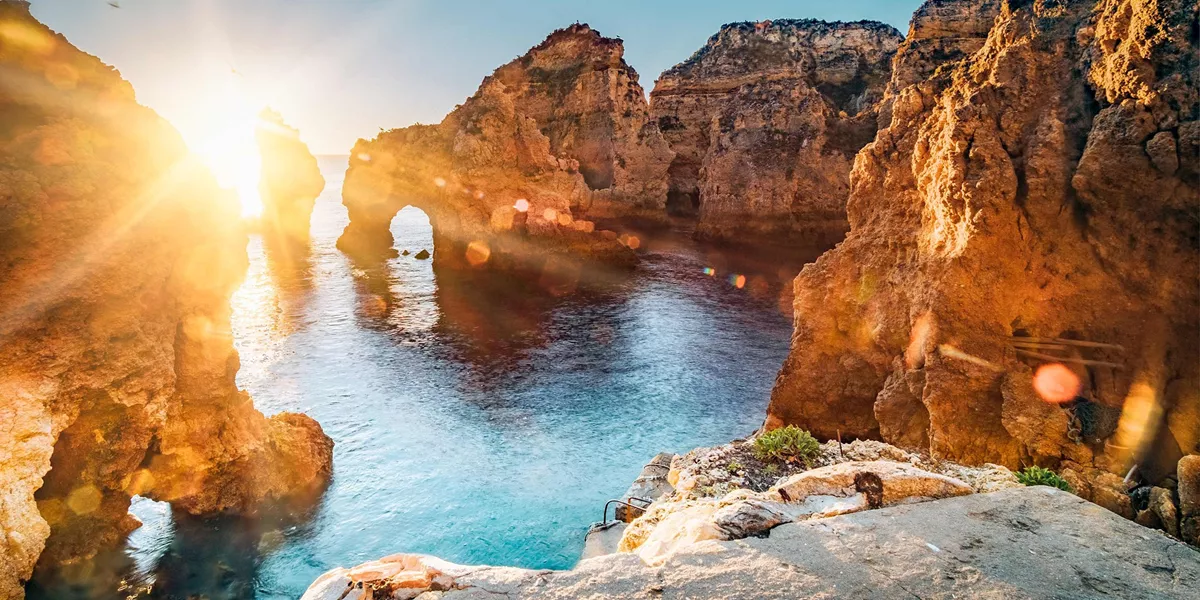
11 Day Portugal Tour to Lisbon, Algarve and Porto
11 days, 1 country and 16 cities
Accommodation
10 Breakfasts, 1 Lunch, 4 Dinners
View day-by-day trip itinerary
This Best of Portugal journey reveals a nation’s proud history, warm-hearted locals and soul-warming cuisine. Starting in Lisbon, you’ll travel north and south to explore a Templar stronghold, watch thoroughbreds perform at an Alentejo farm and visit the Algarve.
Looking to book in a group of 9 or more?
Deals, savings and exclusive private touring options available plus if you need a different date or itinerary change we can create a custom trip. Contact us for more details
Trip code:
Low deposit from $200
Deposit protection
Free booking changes
Trip map & itinerary
Day by day itinerary
11 days itinerary trip from Lisbon to Lisbon visiting 1 country and 16 cities
Download itinerary
Print itinerary
Expand all days
About this trip
Sightseeing highlights.
Explore Lisbon, Coimbra, Tomar, Évora and Porto with a Local Specialist
Discover the Algarve, Lagos, Castelo de Vide, Viseu, Nazaré and Óbidos
Visit the Hieronymite Monastery in Lisbon, the cathedral in Évora, the Palace Gardens at Palacio de Mateus, the Stock Exchange Palace, Arabian Hall and a local port wine cellar in Porto, the University Library of Coimbra, the Convent of Christ in Tomar and the Gothic Monastery at Batalha
View the Castle of Guimarães and the Shrine at Fátima
Travel highlights
Specific transfer information can be found here:
Airport Transfers
An expert Travel Director and professional Driver
Cherry-picked hotels, all tried and trusted
All porterage and restaurant gratuities
All hotel tips, charges and local taxes
Breakfast daily and up to half of your evening meals
Must-see sightseeing and surprise extras
Audio headsets for flexible sightseeing
Luxury air-conditioned coach with Wi-Fi in most countries or alternative transportation (such as rail journeys)
Optional Experiences and free time
On occasion, hotels of similar standard and location may be utilized.
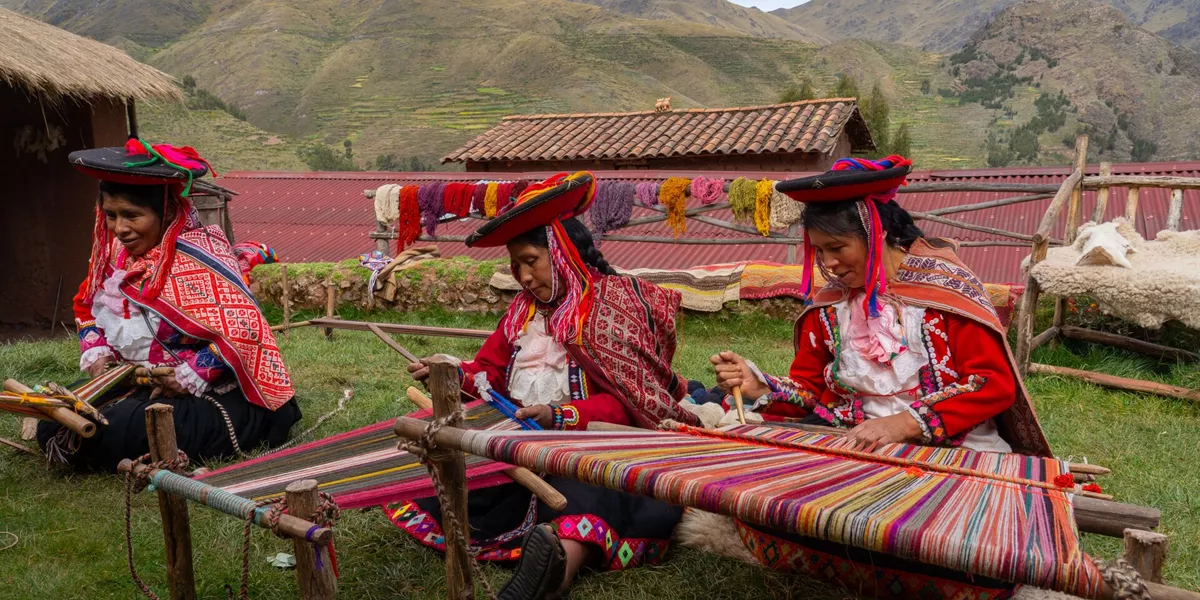
MAKE TRAVEL MATTER® Experiences
Every one of our tours includes at least one conscious travel experience that supports one or more of the United Nations Sustainable Development Goals (SDGS). Look out for yours within the day-by-day trip itinerary.
Find out more

Net-zero by 2050
Travel knowing our 4-point climate action plan will ensure net-zero greenhouse gas emissions by 2050.
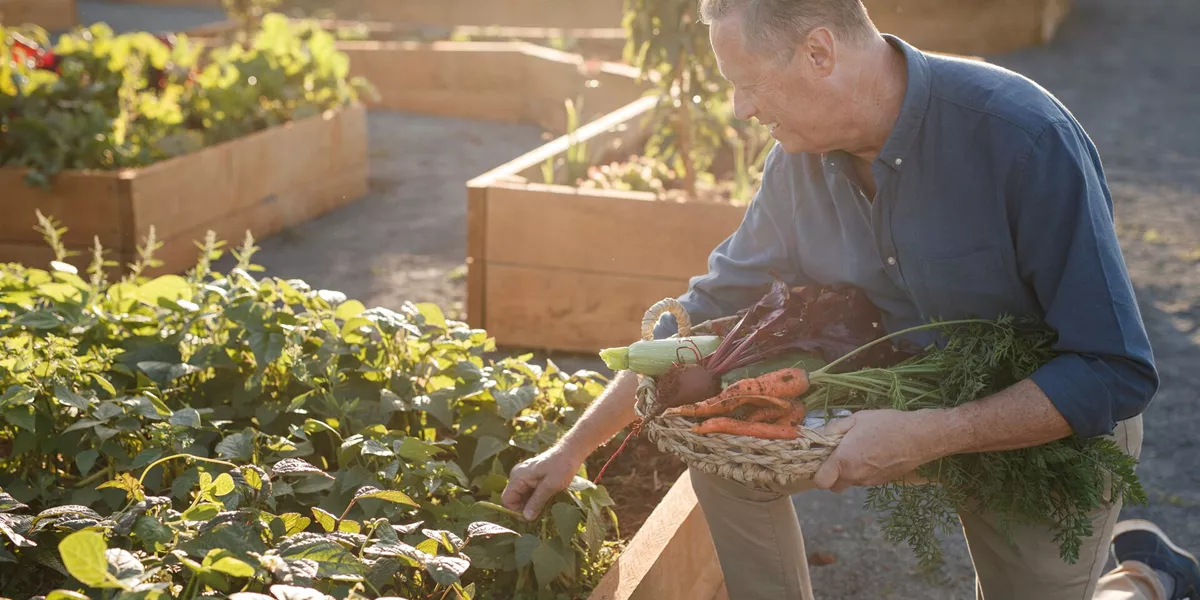
Support Local
Your tour directly supports local communities by visiting family-run businesses, UNESCO sites and places of cultural significance.

Sustainable Practices
Every part of our business, from trip design to how we run our offices, aligns to our 5-year sustainability strategy which ensures a positive impact on people, the planet and wildlife.

Philanthropic Efforts
Our not-for-profit, the TreadRight Foundation, invests in nature-based solutions to address climate change.
You’ll make a positive impact to people, planet and wildlife on this tour
LIVE, UNEDITED & INDEPENDENT TRAVELER REVIEWS
Best of Portugal trip reviews
#ttbestofportugal.
Real moments from real travelers, creating the greatest travel stories they’ll ever tell
Or search for something else

Help & Info
WE MAKE TRAVEL MATTER®
Unedited Reviews
Our Destination Management Companies
Frequently Asked Questions
Travel Updates
Media & Press Room
Do Not Sell or Share My Personal Information
Travel Planning
Get Your Free Brochure
Travel Insurance
Booking Conditions
Trip Deposit Level
Recommendations
Trafalgar Tours Limited is a proud member of The Travel Corporation family of companies.
#SimplyTrafalgar
Travel House, Rue du Manoir St Peter Port, Guernsey, GY1 2JH
Selected Region
United States
United Kingdom
New Zealand
South Africa
Copyright 2024 Trafalgar. All rights reserved.
Terms and Conditions
Privacy Policy
Cookie Policy
APRIL SALE: Book now and get up to 60% off!
Fully Guided Tours & Trips in Portugal
Find the right fully guided tour for you in Portugal. There are 253 trips to choose from, that range from 3 days in length, up to 17 days. The month with the most departures is October, making it the most popular time to visit Portugal.
250+ Fully Guided tour packages in Portugal with 5,126 reviews
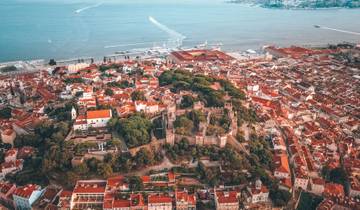
- In-depth Cultural
- Coach / Bus
- Christmas & New Year
Highlights of Portugal
We had a great group. Itinerary was just what I was looking for. Everyone could choose what they wanted to do during the day.

Best of Portugal (11 Days)
Very well planned and executed. Ruiz and Sergio were great. We will be back.
- €100 deposit on some dates Some departure dates offer you the chance to book this tour with a lower deposit.
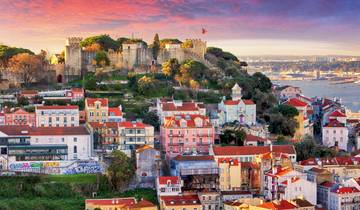
Best of Portugal
Our guide Cristina And driver Fernando were both exceptional, friendly, knowledgeable and our pleasure to be with as traveled some 2500 km through Portugal.
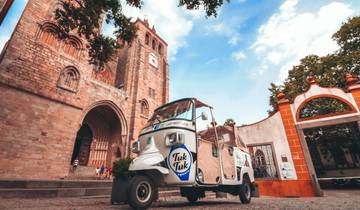
Portugal in Depth
We are very happy with the trip The tour director John was perfect and it make the trip enjoyable
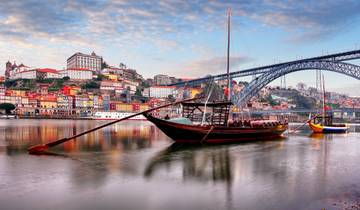
Northern Portugal Discovery
We were pleasantly surprised to be on a tour of only 6 people. Our driver, Joao Pablo (John), was excellent. He was so knowledgeable and personable and had some great recommendations for us. We all had a great time and will definitely request “John” when we return to Portugal!

Highlights of the Azores
All went well. Isabelle was very giid and knowledgeable and informative Traveling between island I'm the Azores is time consuming but getting us to the airport two and a half hours before the flight was a waste of a morning You seem to be the only operator who visits four islands, please continue. If you're going there you want to see as much as possible

Premium Portugal

- Hiking & Trekking
- Mountain Hikes
- Coastal Walks
Walking in Madeira
It was my first trip with Explore. I was very satisfied apart from the size of the group (very large at 15 for a walking tour). I would be happy to pay a little more with numbers limited to 10 or 12.
- 10% deposit on some dates Some departure dates offer you the chance to book this tour with a lower deposit.
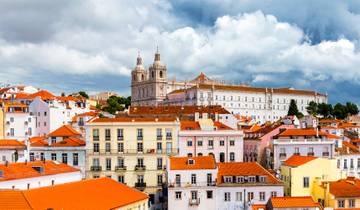
Picturesque Portugal (End Lisbon, 7 Days)
Too little time spent on optional excursions. Hotels okay. City tours only from bus. Little walking tour of Lisbon and Porto. Stayed in Lisbon xtra day to explore and walk. Optional farewell dinner overpriced. Whole tour overpriced.
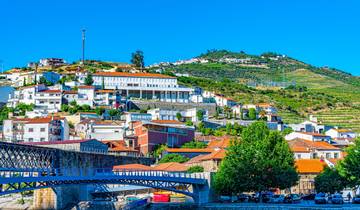
Country Roads of Portugal (Classic, Summer, 11 Days)
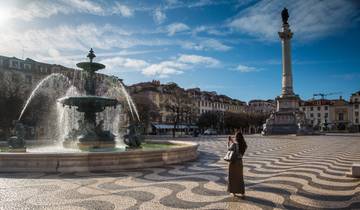
Discover Portugal National Geographic Journeys
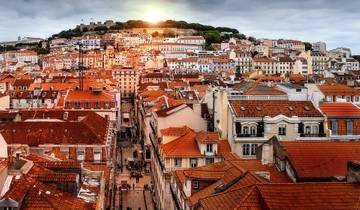
Picturesque Portugal (End Porto, 7 Days)
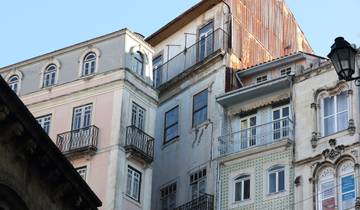
Porto to Lisbon Atlantic Ride
Portugal is a jewel.... Biking the Atlantic Coast from Porto to Lisbon was the perfect manner to get a feel for the country. Seafood was outstanding. The guides advised us to eat at wonderful restaurants along the coast. Would have liked more time in Nazare to visit the beaches. Also, the ability to carry only two people at a time in the "sag wagon" was a big drawback.
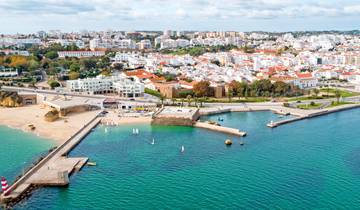
Portugal City and Surf (9 Days)
What people love about fully guided tours in portugal.
Above and beyond my expectations attributed to the tour guide Ana Rita and the bus driver Mario..
Regions in Portugal
- Northern Portugal (49)
- Madeira (25)
- Azores Archipelago (19)
- Central Portugal (17)
- Algarve (7)
Travel Styles
- Fully Guided
- Portugal Travel Guide | All You Need to Know
- Best 10 Day Portugal Itineraries 2024/2025 (With Reviews)
- Discover the Best Portugal Vacation Packages 2024/2025

Epicure & Culture
Food, wine & culture for the ethical traveler
Eco-Tourism In Portugal: 13 Amazing Sustainable Experiences
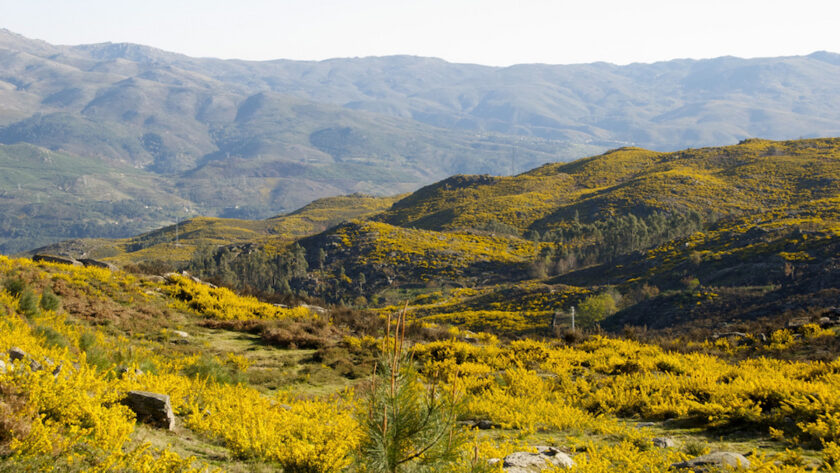
By Nancy Michelle Cote. This guide to eco-friendly Portugal contains affiliate links to trusted partners!
Looking to explore eco-tourism in Portugal ?
Then you’re in the right place!
Portugal is a beautiful country full of stunning landscapes, vibrant cities, and friendly people.
It’s also becoming increasingly known for its commitment to eco-tourism, with a wide range of sustainable experiences available for tourists looking to explore the natural beauty of this amazing nation.
From kayaking through remote mountain valleys and exploring ancient forests to camping in secluded spots away from the hustle and bustle of daily life, Portugal has something for everyone who wants to enjoy nature without damaging it.
Here is a comprehensive Portugal tourism guide sharing some of the most incredible sustainable experiences you can have while visiting!
Table of Contents
What Is Ecotourism?
According to UNWTO , ecotourism is an “all nature-based form of tourism in which the main motivation of the tourists is the observation and appreciation of nature as well as the traditional cultures prevailing in natural areas.”
In theory, ecotours are intended to be educational while being fun, encouraging people to learn more about nature and conservation through firsthand experiences.
It is a way for travelers to have an immersive experience in nature without negatively affecting the environment.
Examples of ecotourism, when done properly, may include bird-watching tours, visits to national parks and reserves, cultural trips focused on Indigenous customs of native peoples, and volunteering holidays such as planting trees or building trails.
The goal of eco-tourism is to minimize negative impacts on both the environment as well as local cultures and economies by promoting socially responsible behavior among tourists during their visit.
How Eco-Friendly Is Portugal?
Portugal is an increasingly eco-friendly country, with numerous sustainable initiatives and programs in place. It has adopted the European Union’s circular economy strategy and its Green Deal initiative , which is focused on zero carbon emissions by 2030.
The Portuguese Government has also invested in renewable energy sources like wind and solar power. As a result of these efforts, Portugal was recently named one of the world’s top 50 greenest countries by Yale University’s Environmental Performance Index (EPI) .
Additionally, Portugal is committed to protecting its environments through various nature conservation initiatives such as the Natura 2000 network . This network provides legal protection to important habitats including coastal wetlands, lagoons, and dunes.
All of these initiatives help to make Portugal an excellent destination for visitors looking to experience sustainable travel.
Best Ways To Explore Eco-Tourism In Portugal

1. Explore the Tapada de Mafra Nature Reserve near Mafra
Tapada de Mafra is a stunning nature reserve located just a few minutes away from the town of Mafra on the west coast of Portugal.
It has recently been declared a UNESCO World Heritage site and is home to valuable biodiversity.
The reserve subsidizes research and preservation of the indigenous fauna and flora in the reserve and promotes environmental education in several private and public initiatives.
This ecological haven is perfect for those interested in eco-tourism in Portugal, offering a variety of experiences between the lush green trails and local wildlife.
Opt for an easy or moderate hike along the winding trails and try to spot deer, wild boar, foxes, and various birds living in their natural habitat.
There are also options for mountain biking, forest running, and even doing a canopy tour to see the reserve from above!
Since educating the population is one of the principal objectives of this project, various presentations on the forest, birds, and bees are also all part of the experience.

2. Visit the Iberian Wolf Recovery Center near Mafra
The Iberian Wolf Recovery Center , also located near Mafra, is an important stop on any eco-tour of Portugal.
Open to the public, visitors can learn about the conservation work being done to protect this endangered species and the vital role these wolves play in the ecosystem.
The 18 acres are a sanctuary for wolves that cannot live in the wild due to being victims of traps or illegal captivity, or coming from parks and zoos.
The main purpose of the center is to educate the population and aid in research initiatives. Guided tours of the grounds are offered where visitors can observe the wolves from afar — which is an important aspect of ethical wildlife tourism .
Additionally, the center offers wolves that have been orphaned or injured a safe environment to aid in their recovery and hopefully reintegrate them into the wild.
The center’s educational program is a great way to inform visitors about the importance of nature conservation and species preservation.
With interactive exhibits and educational presentations, visitors can gain an appreciation for the Iberian Wolf’s unique place in Portugal’s environment.
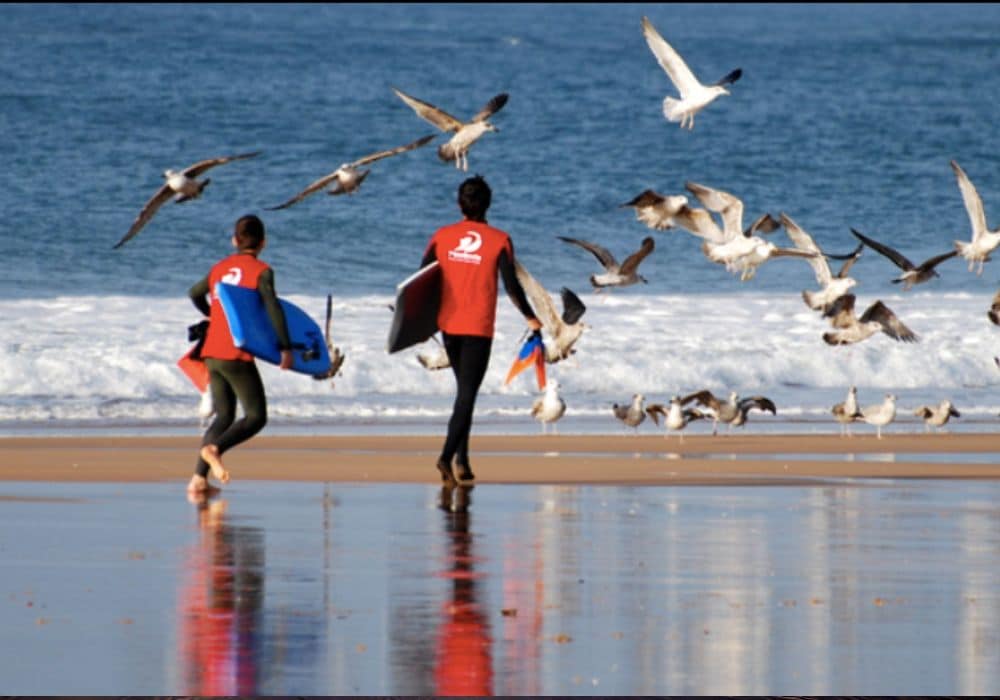
3. Join a yoga surf retreat in Ericeira
Ericeira is the first and only World Surf Reserve in Europe, recognized by the Save the Waves Coalition program that dedicates itself to preserving outstanding surf spots around the world.
It has also recently been certified as a Biosphere Destination that works to guarantee a balanced relationship between human activity, environmental protection, and preservation of historical and cultural heritage.
Ericeira’s 4-kilometer (2.5-mile) surf zone is home to seven world-class waves . The reserve strives to protect the micro-ecosystems of each surf spot since each has its own landscape and unique characteristics caused by the alterations in the sea floor and human activity.
Possibly the best way to enjoy the relaxed local surf culture is by partaking in a retreat with Surf Yoga Portugal , which hosts some of the best surf and yoga retreats in Portugal .
Through their program, you can expect macrobiotic food, surf lessons, and yoga classes — as well as soothing therapies like reiki and massage.
Don’t miss Ericeira if you want to experience the beauty of a World Surf Reserve while learning some new skills.
You can also check out some other top yoga and surf retreats in Ericeira here .

4. Hike the Caminho Português da Costa from Lisbon or Porto
Part of the network of Camino de Santiago routes, the epic Caminho Português da Costa is a must.
This 600-kilometer (373-mile) trek takes you from Lisbon’s center along the coastline to Porto and then Santiago de Compostela in Spain in 25 days. It’s a popular experience for solo travelers to Lisbon who want a solitary experience with nature as well as couples and groups.
You’ll pass by several protected areas — such as the Natural Park of the North Coast in Esposende and the Douro Estuary Natural Reserve — along with some of Portugal’s most stunning coastline.
You’ll also get the chance to see some incredible beaches and local wildlife along your journey. The highlight for many is the Mindelo Ornithological Reserve , which harbors 145 species of birds. It is part of the National Network of Protected Areas and boasts very rich biodiversity.
Those wanting a shorter experience can start in Porto and arrive in Santiago de Compostela after about 12 days of walking.
Although not for all, this type of trip is an incredible opportunity for people looking to experience eco-tourism in Portugal. Just make sure to practice Leave No Trace principles along the way!
Click here for details on how to hike the trail from Lisbon .
Click here for details on how to hike the trail from Porto .
Only have room for a 3-day Porto itinerary ? Here are some other fun local things to do in the city.

5. Hike the stunning Penada-Geres National Park
Penada-Geres National Park is one of the most beautiful and unique natural areas in Europe.
Visitors looking for eco-tourism experiences in Portugal can explore a variety of outdoor activities, immerse themselves in local culture, and learn about the rich history of the region.
Make sure to visit some of the traditional villages in the national park, such as Castro Laboreiro and Lindoso , with their castle ruins and time-honored events.
Also don’t miss the Peneda Gerês Sanctuary , an impressive 18th-century monument with 20 chapels built into the surrounding craggy cliffs.
The natural park aims to protect the flora and fauna of the region as well as the landscape and natural resources in the area.
In terms of hiking, the park has trails suited for hikers of all abilities, from easy loop trails to more challenging multi-day expeditions.
Along the way, you can discover stunning waterfalls and wildlife, observe mountains and forests up close, and even have active adventures like mountain biking or climbing.
You view some of the best trails in Peneda-Geres National Park here.
If a relaxing escape is more your style, consider taking a dip in the natural thermal spas or simply spending time by one of the many lakes with a great book.
Camp grounds can be found around the park and visitors can enjoy some of the best camping in Portugal.
Whether you’re looking for an adventure-filled day or simply want to escape into nature and enjoy scenic views, Penada-Geres National Park has it all!

6. Dive in Madeira at the Garajau Nature Reserve
Garajau Nature Reserve on the island of Madeira is a paradise for eco-tourists in Portugal.
Established in 1986 to protect the seabed from desertification, this area is now home to some of the most diverse wildlife in the archipelago.
Whether you’re an experienced diver or just starting out, diving in Garajau is a treat.
The Garajau Nature Reserve is teeming with aquatic life, from colorful coral reefs to curious fish and even some larger marine animals like the giant manta ray and the giant devil ray.
When planning your trip, just make sure to choose a PADI dive center like Azul Diving Center Madeira to ensure they follow sustainable practices.
Not into diving? Kayaking and snorkeling are also great ways to explore the reserve without going too deep into the ocean’s depths.
Along the shoreline, there are plenty of sea caves and rock formations to explore, and you might even spot some dolphins or turtles along the way.
No matter how you choose to explore Garajau Nature Reserve, it’s sure to be an unforgettable experience.

7. Explore the Laurisilva on Madeira Island
The Laurisilva (Laurel Forest) of Madeira is a UNESCO World Heritage site and a remarkable ecological wonder, located within the Parque Natural da Madeira (Madeira Natural Park).
This lush and ancient forest, estimated to be around 20 million years old, contains an unparalleled wealth of biodiversity and plays a critical role in maintaining the hydrological balance on Madeira Island.
This means the forest is an important source of drinking water on the island which has historically been channeled to human settlements.
Research done here sheds light on the evolution and adaptation of fauna and flora based on environmental conditions, which change over time.
Featuring a unique network of rivers, streams, and waterfalls, this pristine environment is home to a variety of endemic species — like the Madeiran long-toed pigeon — and offers some unique experiences, including the opportunity to observe wild green macaws.
This captivating landscape also provides the perfect backdrop for numerous outdoor activities such as hiking, biking, trail running, canyoning, coasteering, and climbing.
No matter the activity, visitors are sure to experience a truly unforgettable eco-friendly adventure.

8. Hike at the eco-friendly Sete Cidades in the Azores
Sete Cidades , located on the Azores archipelago in Portugal, is a stunning natural wonder and one of the best destinations for ecotourism off the coast of Portugal.
It is the world’s first archipelago certified as a Sustainable Tourism Destination, under the EarthCheck Sustainable Destination program . The government is committed to promoting sustainable development on all the islands which will result in truly sustainable tourism by 2030.
Home to a variety of lagoons, craters, and a dormant volcano, this area is a protected landscape and is a Rede Natura 2000 Protected Vista.
Some of the most popular activities in this area include bird watching, hiking, and mountain biking.
For those who want to explore deeper into the nature reserve, there are plenty of trails ranging from 2 to 4 hours in length that offer breathtaking views of the blue and green lagoons and an opportunity to experience a unique and magical landscape.
Learn about some of the best trails in Sete Cidades here .
With its commitment to preserving its natural environment, Sete Cidades serves as an excellent destination for eco-tourism and sustainable tourism in Portugal.

9. Enjoy a Portugal farm experience at the Douro International Natural Park
Near the inland city of Castelo Branco, you can visit the Douro International Natural Park and its namesake river to explore Portugal’s natural wonders and have a glass (or four) of wine!
Whether it’s from the land or from a boat, travelers can get an up-close look at this picturesque landscape with its combination of forest, vineyards, olive trees, and almond trees.
Opt for an Arribes del Douro Cruise and enjoy an environmental-focused cruise down the Douro River while taking in stunning views of terraced vineyards, lush forests, and dramatic cliffs.
The landscape has been protected to preserve the natural habitat of indigenous plants and wildlife. It also harbors protected eagles and vultures, which you are almost sure to see while exploring the trails.
For an even more immersive experience, visitors can gain first-hand insight into Portuguese culture by participating in a Portugal farm experience in the area, like this one .
Many offer tours of the local vineyards and wineries, not to mention farm stays are a wonderful way to see the countryside.

10. Go kayaking or diving at Berlengas Natural Reserve near Peniche
Berlengas Natural Reserve is a one-of-a-kind destination for Portugal ecotourism enthusiasts.
The reserve aims to conserve the habitat of marine life, seabird populations, and endemic plants in the area by developing damage control strategies to reduce the impact of human activity.
Residing off the coast of Peniche, this enchanting area boasts a stunning variety of fauna and flora, with its unique location giving visitors an unforgettable experience. If you’re lucky, you might even see a puffin!
Between May and October, visitors can take advantage of daily access to the island by boat .
With a maximum of 350 visitors allowed at any one time, Berlenga is the perfect place for those looking for a tranquil and secluded getaway from their everyday lives.
Whether you take walks on the island’s trails to visit its grottos and the Fort of the Berlengas, or simply enjoy its stunning scenery, there are plenty of opportunities to explore.
For the more daring, kayaking and diving are available as well, with a wealth of amazing biodiversity beneath the surface.
If you want to stay longer than an afternoon, you can even camp overnight or enjoy lunch at one of the island’s restaurants.
A visit to the Berlengas Natural Reserve is sure to leave you with unforgettable memories.

11. Go birdwatching at the Lagoas de Santo André and Sancha Natural Reserve in Alentejo
The Lagoas de Santo André and Sancha Natural Reserve is a stunningly beautiful destination for eco-tours in the Alentejo region of Portugal.
Occupying a 15-kilometer (9-mile) stretch of coast, this officially protected area contains two wetlands that are home to a wide variety of birds.
The region enjoys abundant natural resources, making it a popular destination for birdwatching as well as other activities such as hiking, canoeing, and windsurfing.
The long sandy beaches of Costa de Santo André and Fonte do Cortiço provide the perfect opportunity for relaxation or a leisurely stroll.
Whether you’re looking for a chance to observe nature in the wild, or just a peaceful place to spend the day, the Lagoas de Santo André and Sancha Natural Reserve has something for everyone.

12. See the Iberian lynx at Serra da Malcata Natural Reserve in Central Portugal
Serra da Malcata Natural Reserve in the Central Region of Portugal is a paradise for nature lovers and eco-tourists alike.
It was created in 1981 to protect the near-extinct Iberian lynx, with only an estimated 100 of them remaining in the wild.
In addition to saving this magnificent creature from extinction, the reserve also provides a safe habitat for other animals and preserves the Mediterranean flora found in this area.
Visitors to the nature reserve will have the opportunity to explore virtually untouched forest. There’s an interpretative trail that teaches visitors about the importance of environmental preservation, as well as hiking trails and organized mountain bike tours to some of the most interesting spots.
Don’t miss out on the unique opportunity to observe the Iberian lynx, one of Portugal’s rarest species. It’s definitely an experience to remember!

13. Go dolphin watching in the Arrábida Natural Reserve in Setúbal
The Arrábida Natural Reserve is a stunning biogenetic reserve located in the district of Setúbal, Portugal. A biogenetic reserve is an area designated by the Council of Europe which protects a rare habitat or ecosystem and permits biological and genetic research.
It offers many unique experiences for those looking to explore its diverse marine flora and fauna.
Visitors can take a boat trip through the estuary of the Sado River to observe the three dozen Sado and Bottlenose Dolphins that live at the mouth of the river. It is one of the only three colonies in rivers on the European continent.
The distinctively calm waters in Arrábida also make it perfect for kayaking and diving.
The area is home to a high diversity of marine flora and fauna, making it an excellent spot for visitors looking to explore the wonders of nature.
Check out this incredible reserve on your next eco-tourism trip to Portugal!
Final Thoughts On Eco-Tourism In Portugal
With numerous examples of slow tourism in Portugal as well as initiatives and programs in place, travelers can explore this beautiful country with peace of mind knowing that their actions are helping preserve its natural beauty while benefiting local communities.
Whether you’re kayaking remote beaches on the Atlantic coast or hiking up Penada-Geres, there is something new and exciting around every corner when it comes to eco-tourism in Portugal!
What are your favorite ways to explore eco-tourism in Portugal?
About The Author

A beachcomber, an avid bookworm, and a teacher. Michelle is a Canadian travel blogger who writes about Portugal.
She fell in love with the charming Portuguese village of Ericeira when she was enticed to move there by her Portuguese husband and never looked back.
She now lives between Mallorca and Ericeira, with her family and Fluffy the hamster.
Follow her adventures on Ericeirafamilyadventures.com .
- Latest Posts
Nancy Michelle Cote
Latest posts by nancy michelle cote ( see all ).
- Eco-Tourism In Portugal: 13 Amazing Sustainable Experiences - Mar 25, 2023
You may also like...
Wildlife experiences: a humane holiday or torturous tourism.

The Dark Side Of Easter: Child Slave Labor And How To Source Ethical Chocolate This Holiday

Exploring Ethically: Top 10 Blogs For Responsible Travel

6 Pioneering Volunteer Projects Helping Street Animals In India
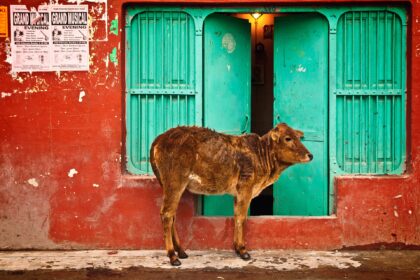
stunning biogenetic reserve , all the love
Great list. We are moving to Portugal in June and hope to explore the area like a tourist as well as a local. We have to be intentional about not falling into a routine when we move some place and go explore outside of our neighborhood.
You actually can’t see any iberian lynx at Malcata. Even though it is the face of the park, the populations have disapeared from it decades ago. There are many successful reintroduction efforts further south in the country, but not in Malcata. It’s a beautiful area, but the info you share shows that your knowledge on the place is close to zero 🙁
Leave a Reply Cancel reply
Your email address will not be published. Required fields are marked *
This site uses Akismet to reduce spam. Learn how your comment data is processed .
- Travel, Tourism & Hospitality ›
- Leisure Travel
Travel and tourism in Portugal - statistics & facts
The role of tourism in the portuguese economy, spain: portugal’s main tourism partner, most popular tourism destinations in portugal, tourism: a pillar of economy in portugal, key insights.
Detailed statistics
Tourism contribution to GDP in Portugal 2019-2023
Enterprises operating in the Portuguese tourism sector 2010-2022
Tourism employment in Portugal 2010-2022
Editor’s Picks Current statistics on this topic
Current statistics on this topic.
Travel, Tourism & Hospitality
Accommodation
Inbound overnight tourism volume in Portugal 2015-2023
Hotel bed occupancy in Portugal 2012-2022
Related topics
- Travel and tourism in Europe
- Outbound tourism in European countries
- Domestic tourism in European countries
- National tourism in Spain
- Inbound tourism in Europe
Medical tourism
- Medical tourism in Latin America
- Medical tourism in South Korea
Tourism trends
- Winter tourism in Europe
- Ski tourism worldwide
- Luxury travel and tourism worldwide
- Artificial intelligence (AI) use in travel and tourism
Recommended statistics
- Basic Statistic Tourism contribution to GDP in Portugal 2019-2023
- Premium Statistic Sales of the Portuguese tourism sector 2010-2022
- Premium Statistic Share of tourism enterprises in Portugal 2022, by size
- Premium Statistic Enterprises operating in the Portuguese tourism sector 2010-2022
- Premium Statistic Tourism employment in Portugal 2010-2022
- Premium Statistic Overnight stays by visitors in Portugal 2022, by region
- Basic Statistic Leading European countries for traveling by car 2022
Total contribution of travel and tourism to the gross domestic product in Portugal from 2019 to 2023 (in billion U.S. dollars)
Sales of the Portuguese tourism sector 2010-2022
Sales revenue of tourism services in Portugal from 2010 to 2022 (in billion euros)
Share of tourism enterprises in Portugal 2022, by size
Distribution of travel and tourism companies in Portugal in 2022, by size
Number of travel and tourism companies in Portugal from 2010 to 2022 (in 1,000s)
Number of employees in the travel and tourism sector in Portugal from 2010 to 2022 (in 1,000s)
Overnight stays by visitors in Portugal 2022, by region
Number of nights spent by tourists at hotels and similar establishments in Portugal in 2022, by region (in 1,000s)
Leading European countries for traveling by car 2022
Best countries for road trips in Europe in 2022 (index score)
Expenditures
- Premium Statistic Tourism balance of payments in Portugal 2010-2022
- Premium Statistic Inbound tourism spending in Portugal 2010-2022
- Premium Statistic Outbound tourism spending in Portugal 2010-2022
- Premium Statistic Per capita daily spend by Portuguese travelers 2019-2022
- Premium Statistic Per capita spend by Portuguese domestic and outbound travelers 2019-2022
- Premium Statistic Per capita daily spend by Portuguese travelers 2022, by travel reason
Tourism balance of payments in Portugal 2010-2022
Balance of payments in the travel and tourism sector in Portugal from 2010 to 2022 (in billion euros)
Inbound tourism spending in Portugal 2010-2022
Expenditure by international tourists in Portugal from 2010 to 2022 (in million euros)
Outbound tourism spending in Portugal 2010-2022
Expenditure by international tourists from Portugal from 2010 to 2022 (in million euros)
Per capita daily spend by Portuguese travelers 2019-2022
Average daily expenditure by tourists from Portugal in 2019 and 2022 (in euros per person)
Per capita spend by Portuguese domestic and outbound travelers 2019-2022
Average expenditure by tourists from Portugal from 2019 to 2022, by type of destination (in euros per person)
Per capita daily spend by Portuguese travelers 2022, by travel reason
Average daily expenditure by tourists from Portugal in 2022, by travel purpose (in euros per person)
Inbound tourism
- Premium Statistic Inbound overnight tourism volume in Portugal 2015-2023
- Premium Statistic Inbound tourism volume in Portugal 2022, by place of residence
- Premium Statistic Monthly number of foreign guests at lodging businesses in Portugal 2019-2023
- Premium Statistic Inbound tourism volume in Portugal 2019-2023, by destination region
- Premium Statistic Overnight stays by inbound visitors in Portugal 2011-2022
Number of international tourists arrivals and overnight stays in Portugal from 2015 to 2023 (in millions)
Inbound tourism volume in Portugal 2022, by place of residence
Number of international tourism arrivals in Portugal in 2022, by country of residence (in 1,000s)
Monthly number of foreign guests at lodging businesses in Portugal 2019-2023
Number of international tourists who stayed in hotels and similar establishments in Portugal from January 2019 to December 2023 (in millions)
Inbound tourism volume in Portugal 2019-2023, by destination region
Number of international visitors in Portugal from 2019 to 2023, by region of destination (in 1,000s)
Overnight stays by inbound visitors in Portugal 2011-2022
Number of nights spent by international tourists at hotels and similar establishments in Portugal from 2011 to 2022 (in 1,000s)
Domestic and outbound tourism
- Premium Statistic Number of Portuguese travelers 2011-2022, by gender
- Premium Statistic Participation in tourism for personal purposes in Portugal 2012-2022
- Premium Statistic Portuguese tourists for personal purposes 2022, by age
Number of Portuguese travelers 2011-2022, by gender
Number of tourists from Portugal from 2011 to 2022, by gender (in 1,000s)
Participation in tourism for personal purposes in Portugal 2012-2022
Share of population traveling for personal purposes in Portugal from 2012 to 2022
Portuguese tourists for personal purposes 2022, by age
Number of people traveling for personal purposes in Portugal in 2022, by age group (1,000s)
Lodging industry
- Premium Statistic Largest hotel groups in Portugal 2023, by hotel capacity
- Premium Statistic Largest hotel brands in Portugal 2023, by hotel capacity
- Basic Statistic Tourist arrivals in accommodation in Portugal 2010-2022
- Premium Statistic RevPAR in the Portuguese lodging industry 2018-2023
- Premium Statistic ADR of the Portuguese lodging industry 2018-2022
- Premium Statistic Hotel bed occupancy in Portugal 2012-2022
- Premium Statistic Share of overnight stays by travelers in Portugal 2022, by tourist origin
Largest hotel groups in Portugal 2023, by hotel capacity
Leading hotel chains in Portugal as of October 2023, by number of rooms
Largest hotel brands in Portugal 2023, by hotel capacity
Leading hotel brands in Portugal as of October 2023, by number of rooms
Tourist arrivals in accommodation in Portugal 2010-2022
Number of arrivals in tourist accommodation in Portugal from 2010 to 2022 (in millions)
RevPAR in the Portuguese lodging industry 2018-2023
Revenue per available room of the hospitality industry in Portugal from 2018 to 2023 (in euros)
ADR of the Portuguese lodging industry 2018-2022
Average daily rate of the hospitality industry in Portugal from 2018 to 2022 (in euros)
Bed occupancy rate of hotels and similar establishments in Portugal from 2012 to 2022
Share of overnight stays by travelers in Portugal 2022, by tourist origin
Distribution of nights spent by tourists in accommodation establishments in Portugal in 2022, by type of tourist
Further reports Get the best reports to understand your industry
Get the best reports to understand your industry.
Mon - Fri, 9am - 6pm (EST)
Mon - Fri, 9am - 5pm (SGT)
Mon - Fri, 10:00am - 6:00pm (JST)
Mon - Fri, 9:30am - 5pm (GMT)

Best Things to Do in Porto, Portugal
Best things to do in porto portugal.
Porto is… a city torn between the currents of time. On one hand, is firmly rooted in the past with its history and culture in full display. On the other hand, it reaches out excitedly towards the future, complete with all the modern conveniences.
In between, Porto has its unique charm. Whether it’s a rustic view of the river or the countryside, a warm shot of port, or a welcoming smile from one of its locals, there are many things to do in Porto.
Also read: 10 Day Portugal Itinerary
Which is amazing, since it’s Portugal ’s second prime city. And yet it’s not one that’s trapped in the ravages of modernization, its skyline not ruined by the skyscrapers of today’s metropolis. There’s modern architecture, yes, but there’s also the raw street art not too far away from the classic tourist sights of museums and cathedrals.
Like in many other grand cities of the world, you could easily stay here for a week and still be fascinated. But if you don’t have that time, we have curated the best of Porto into this ultimate guide that will get you going!
If you want something a little more relaxed, you can also take a look at these Yoga Retreats in Portugal – some of them are located near beautiful Porto.
Porto Attractions
One of the main reasons why Porto draws a lot of tourists is because of its laid-back environment. Europe can be a pretty hectic place for a tourist (maybe not for a local) because of the many things to see, and Porto allows you an opportunity to just sit back or maybe take a slow stroll while appreciating what it has to offer. Even with a laid-back town like Porto, it’s best to be prepared with the Porto Pass to get you where you need to go.
That does not mean there aren’t a lot of Porto sights, though. Between the beautiful landscapes and the museums, your eyes will have a lot to feast on!
Porto Sights: Sé Cathedral
You don’t have to be a Catholic to appreciate the grandness of the Cathedral otherwise known simply as “Sé”. The stone structure hails back to the 13th century, and has a myriad of architectural influences from the Gothic to the Romanesque.
It’s hard to miss its silver altarpiece and its ceramic-tiled cloister, among the many treasures that lie in its otherwise simple (at least in comparison with other European cathedrals) façade.
Of course, its fortress-like vantage point also gives way to an amazing view of the city below, with its orange-brown roofs. The cathedral’s terrace overlooks this perfectly, giving you some really Instagrammable shots at some quality Porto attractions!
To get to the Sé, alight at the São Bento stop of the D (yellow) rail line. There’s a EUR 3 cost to enter the cloister, but the rest of the Cathedral is free. The Sé is open daily from 9AM to 6PM.
Jardins do Palácio de Cristal
The name translates to “Crystal Palace Gardens”, and while no Crystal Palace is in sight (it was demolished in 1956) the gardens are really worth your while. The flowers, greenery, fountains, and general ambience feels like the set of one of those Hollywood period films about royalties! There are even peacocks that roam here, though they can be quite shy.
There’s a pavilion here for events, though it’s quite plain. It’s best to stick to the multitude of flower classes here and the priceless view of the Douro River!
There are two metro stops near the Jardins — the Aliados stop of the yellow line, and the Carolina Michaelis stop that services all the other lines. There are also bus routes, and you can catch either Bus No. 200 or 207 and get off the Palácio stop.
Dom Luís I Bridge
Bridges aren’t always likely candidates for top things to do in a city, but the Dom Luís I Bridge is especially interesting. Aside from being an important artery of traffic in Porto, the bridge was the product of a student of Gustave Eiffel — the architectural similarities between this and Paris’ top attraction is readily visible. It was also once the longest iron arch bridge in the world.
But what really makes it great is the spectacular view it affords of the Douro River. Pedestrians can walk along the sides of the bridge’s two levels. As a plus, there are also great wineries nearby!
The bridge is on the northern side of Vila Nova de Gaia. If you’re walking, you can take the metro to São Bento or Jardim do Morro stations, serviced by the yellow line.
Sogrape Vinhos Wineries
Speaking of wineries, this is one thing you really should do before leaving Porto ! Port wine is definitely one of the city’s greatest creations. And Sogrape Vinhos is one of the most distinguished in this regard, owning three cellars (Sandeman, Ferreira, and Offley) in Vila Nova de Gaia.
You can visit all three of them, and each one has a distinguished history starting from the 1700s. Aside from the port, keep your eyes peeled for the photographs and other memento from their rich history!
A wine-tasting experience could cost anywhere from EUR 3 to EUR 35 depending on how intimate you want to get with Porto’s beloved export. There’s a basic wine tour across all three that costs around EUR 10.
All cellars can be reached via the Jardim do Morro stop on the metro’s yellow line.
Estacão de São Bento
We’ve been talking about railway stations for some time now, but did you know that there is a station in Porto that is a tourist attraction on its own? This is the São Bento station, with which you can reach southeast of the Avenida dos Aliados (the main tourist avenue of Porto, with lots of cool shops and cafés). This makes it a no-brainer to get here. The station is on the yellow line, and you can enter and walk around for free.
The station is built on the former site of a monastery, and its claim to fame is the painstakingly painted and installed azulejos , blue and white tiles that together make up a mural-esque pictorial history of Portugal. The installation was so momentous it took a decade to finish it!
There’s also the architecture of the station itself, which makes it a really unique and must-see attraction.
Eating like a local in Porto
Most tourists see the food scene of Porto as a never-ending parade of sardines and chouriço. While salted fish is indeed an indelible part of the cuisine (and history) of Portugal as a whole, there are some really good and interesting eats here you should try.
Francesinha
This might be unfamiliar to first-time tourists, which is a shame. This is a sandwich that’s piling on a steak, three different types of sausages, and served with a fried egg and french fries. Oh, did I mention the entire thing is covered in melted cheese? There’s a super secret sauce, too, which they say is made from meat, seafood, and various types of alcohol. Make sure you check your blood pressure and cholesterol levels before you try this! Or maybe don’t bother and just enjoy.
This is one of Porto’s staple dishes, and you would really enjoy it if you choose the right francesinha place. Check out Francesinha Café over at Rua da Alegria. If you want a setting that’s a bit more intimate, there’s Yuko Tavern at Rua de Costa Cabral.
Alheira: Northern Portugal
If you can’t get enough of meat, these white smoked sausages endemic to the North Portuguese regions will give you your fill! The sausages are made from a variety of meats, from poultry to game (the latter including rabbit and venison). While these sausages are found all over Portugal, there’s no better place to have them in than in Porto.
If you want the traditional homemade quality alheira, head over to the Mercado do Bolhão and buy some raw alheira! The place is at Rua da Alegria. Make sure to stop and have a chat with the sellers to know more about the sausage’s interesting history, too!
Tripas à Moda do Porto
While this sounds like the name of a resto, it’s Porto’s other local tradition (maybe even more so than the francesinha). It’s a stew made of tripe (hence the name), cooked with some meat and a lot of white beans. The flavor is given by a generous heaping of cumin. Tripas is such a local staple that Thursday is a de facto tripe day, in pretty much the same way as Friday marks the appearance of ginisang monggo in the carinderias back home!
Tripas is best tasted at Restaurante Pombeiro, on Rua Capitão Pombeiro.
Broa de Avintes
Let’s side-track a bit and move on from meat to bread. This famous Porto bread originally came from Avintes, a town near Porto. Dense yet soft, dark, and flavorful, this is what banana bread would have looked like if it did not have sugar! Broa de Avintes is served with various dishes, along with starters (ham and cheese!), and is a nod to tradition since the cooking process takes a full 6 hours.
High quality Broa de Avintes is sold at the Mercearia das Flores, located at Rua das Flores. Try using it for a sandwich, and you’ll see why it’s so famous!
Açorda: Specialty of Portugal
Seafood is a specialty everywhere in Portugal, and every region has its take. In Porto, it’s the Açorda, a stew brought to life by coriander and garlic, and filled with fish and other seafood.
In fact, a nice bowl of Açorda may be your best bet in eating real fresh seafood during your stay. Most tourists really go for the sardines, but the thing is it’s not in season for the most part of the year (and hence is very expensive). But it you head to the north of Porto, to the village called Matosinhos, and find your way to Rua Heróis da Pátria, then you can take your pick of any of the seafood restos here and enjoy to your heart’s content!
Porto Activities: Drink Your Heart Out and More!
Tour douro valley: attractive porto.
One of Porto’s most attractive sections, you can easily spend a whole day here. The valley has a slew of wine-tasting opportunities, from port wine to table wine. The area also produces olive oil. For those into sceneries, you can take a slow cruise along the Douro river on a traditional boat.
Douro Valley is best experienced in a tour setting, where you have a guide to show you the best viewpoints. Among these is the Peso da Régua, which gives an amazing view of the whole city!
Do a Hop-on, Hop-off Tour
Those who’ve been to the US and some Asian countries will be familiar with the Hop-on, Hop-off bus . Porto has its own, and there are two routes that will grant you access to some of Porto’s greatest attractions! Turn the buses into your very own tour bus with a day ticket (or two-day ticket) that takes you from the salt-kissed neighborhoods beside the beach to magnificent sights like the Sé Cathedral.
The buses are open-top, so you can get a panoramic view. It’s also great for people watching as you pass through the Central Baixa area, which is the city’s civic center. As a plus, there are also audio guides that will give you the lowdown on the place you are visiting! It really is like a tour of its own.
Do a Guimarães and Braga Day Tour
These two cities are some of the more interesting places in Portugal, and they are close enough to Porto for a day tour! Guimarães is notable for being the land that birthed Afonso Henriques, Portugal’s first king. Of course, there’s a castle and a cathedral to commemorate this important historic fact.
Braga is, similarly, an interesting city with great views, a landmark monastery, and its own twist on Portuguese cuisine!
You can easily reach Guimarães from Porto by leaving through the São Bento station. The trip takes approximately an hour and 15 minutes. From there, you can get to Braga through the Rodonorte (numbers 12, 31, and 2). This trip takes about half an hour.
The best part? All of these activities can be done via tours, through Get Your Guide . They offer top-shelf service and an in-depth look into Porto’s culture! This is also great since you don’t have to worry about catching all the connecting buses and trains.
Other Sightseeing Porto Tours
- Porto: City Train Tour, River Cruise, and Wine Cellar
- Douro Valley Wine Tasting, River Cruise, and Lunch
- Porto Card with Transportation
- Torre Dos Clerigos Entrance Tickets
- Porto: 3 Hour Guided Tour
- Fado Show with Port Wine
- 4.5 Hour Porto Pub Crawl
- Porto: Half-Day Food Tour
As always, don’t be afraid to get lost in this city. Each twist and turn will bring you new adventures, new sights, and new things to ponder. Keep an open mind. Let Porto’s laid-back spirit be your travel guide!
Things To Do in Porto Portugal was written by Karla Ramos for EuropeUpClose .
Best Things To Do in Porto Portugal – Pin for Later
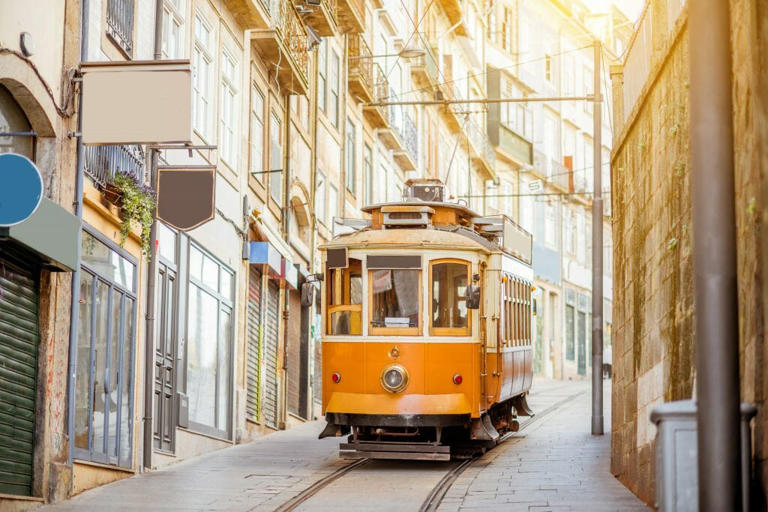
- Search Please fill out this field.
- Manage Your Subscription
- Give a Gift Subscription
- Sweepstakes
This Quaint Town in Portugal Was Just Named the Best Place to Invest in Europe — and It Has Stunning Beaches
Lush pine forests, cobblestone streets, endless ocean views, and low real estate prices await in this quaint community in northern Portugal.
:max_bytes(150000):strip_icc():format(webp)/Dobrina-Zhekova-2885480a814f40a2801fda922af4d135.jpeg)
Xurxo Lobato/Getty Images
Portugal is on everyone's mind these days. The country's sunny weather , many beaches , and affordable cost of living have made it a popular choice for retirees and digital nomads. However, as is often the case, real estate prices in some of its most sought-after regions, like the capital, Lisbon and Algarve , have soared. But that doesn't mean you should give up on your dream of owning property in Portugal.
A new report by International Living ranked the small, under-the-radar- town of Caminha the best place to invest in real estate in Europe for its value and growth potential.
The community is located in the northwest along the mouth of the Minho River, which separates Portugal from Spain, and is home to about 16,000 residents. International Living gave Caminha a perfect score of 10 in the relative value category and nine for quality of life and stability.
"Caminha, which is only separated from Spain by a river, completely charmed me," Ronan McMahon, founder of Real Estate Trend Alert and author of International Living's Global Real Estate Index, told Travel + Leisure . "It has a beautiful Old Town surrounded by a verdant and bucolic countryside, with mountains, rivers, forests, and fields overflowing with brightly colored flowers and fruit trees heavy with their bounty. And then there are the stunning Atlantic beaches."
The ancient town has plenty of character, with fountains, churches, and other buildings dating back to the 16th and 17th centuries. And it's easily accessible from Porto, which is just an hour and 15 minutes south, providing access to an international airport.
Jeff Opdyke, International Living's personal finance editor, called Caminha a "holdover of Portugal before tourism and modernity swept over Lisbon, the Algarve, and Porto," where affordable real estate is still the norm.
Potential buyers can find apartments downtown for as low as $150,000 and stand-alone houses for $280,000 .
And while Caminha is the best place to invest in Europe, another destination took the top prize for global real estate value: Mexico's Los Cabos. International Living ranked first with almost perfect scores in categories such as income potential, climate, and international appeal. Riviera Maya and Estepona in Spain, a town in the country's famous Costa del Sol region, are tied for the third place.
You can see the full ranking at internationaliving.com .
More From Forbes
Portugal’s madeira island is going glam—thanks to this new luxury hotel.
- Share to Facebook
- Share to Twitter
- Share to Linkedin
The Rolls-Royce arrival at the Reserve
Tarmac meet-and-greets. Exclusive airport lounges behind well-marked doors. Rolls-Royce transfers. Velvet ropes. These luxuries almost feel like something out of time, given the current obsession with discretion. But that’s what makes Madeira’s new Reserve hotel refreshing—it’s not afraid to be a place for people who want to flaunt their VIP status.
Rather, it leans into that attention-seeking, starting with its perch atop the Savoy Palace, a plant-covered behemoth of a hotel that dominates the cityscape of Funchal, the island’s capital. It shows off its hotel-within-the-hotel concept, with a separate entrance, top-hatted doormen and a guests-only elevator—the only one in the building to have a bench. The local press excitedly reported that Madeira’s most famous son, Cristiano Ronaldo, rang in 2024 watching the New Year’s fireworks from the rooftop.
And while most guests aren’t anywhere near that notable, the hotel staff does its best to make them feel like they are. The website's landing page promises that clients “will be accompanied by true luxury gatekeepers ready to make you feel like the most relevant person in the world.”
The rooftop infinity pool
Perhaps that’s excessive. But it’s undeniably convenient. Guests have access to a dedicated concierge—always at the ready on WhatsApp and good at learning every guest’s name—who does usual things like managing spa appointments and restaurant reservations and quickly answers less usual ones, like looking up the price of a postcard stamp or the points of sale and designer of the groovy ceramic fruit on display in the guests-only lounge, the Jacarandá Club.
Earth’s New ‘Second Moon’ Is As Big As The Statue Of Liberty—And Scientists Just Found Its Origin
Whatsapp brand new iphone feature just launched that s much easier to use, suicide squad kill the justice league announces huge emergency changes.
That designer would be Madeira native Nina Andrade Silva, who designed the Savoy Palace, which opened five years ago. She’s known for going all-in on wow factor designs, including the lace-inspired railings all over the hotel and the 33-foot-high lobby chandelier made of some four miles of metal chain.
A guest room in the Reserve
Her signature is still welcomely evident in the public areas of the main hotel, including the enormous, glittering outdoor pool at street level, and the forest-inspired spa, which at 33,000 square feet, is one of the largest in Europe. But to give the Reserve its own identity when they carved it out from the Savoy Palace, the owners commissioned local firm RH+ Arquitectos (who also worked on the main hotel that opened five years ago) to give the space a refresh.
The 40 rooms of the Reserve—on the top floors of what was previously a 349-room hotel—all have ocean views and an island-inspired color palette: serene shades of blue, brown, gray and green. There’s abundant light and space inside and another living area outdoors, sometimes with a private plunge pool.
Along with those, the rooms over the Reserve share a quiet solarium, jetted tub and infinity-edge pool 17 floors above the everything of Funchal. The facilities are a mirror image of those that are shared by the Savoy Palace’s other 300 rooms on the opposite end of the rooftop, but of course with far fewer people.
The dining room at Nikkei
The Reserve also has a second guests-only restaurant (besides the complementary a la carte breakfast and all-day dining menu at the Jacarandá Club). Nikkei is an Asian fusion project from noted sushiman Miguel Bértolo, who consulted with the hotel to develop a menu of Japanese dishes infused with flavors of Peru.
As is fitting for a hotel designed for VIPs, the dishes have their share of flourishes like a Wagyu beef starter with nitsuke egg yolk, truffle and ponzu sauce over parrotfish sashimi, and sumptuous scarlet prawns served over rice as donburi. And from its 16th-floor perch, it has dizzying views over the vertiginous landscape of Funchal and the hills beyond. It’s a place to take pleasure in being above it all.

- Editorial Standards
- Reprints & Permissions

'They will rip you off!' Expat in Portugal shares a warning when eating in the European hotspot

An expat in Portugal discusses living there

By Sarra Gray
Published: 28/04/2024
An expat living in Portugal shared a word of warning for anyone visiting the holiday destination
Don't miss, ronnie o'sullivan part of the growing problem at world snooker championships in worrying trend, classic car owners urged to avoid buying e10 petrol or risk potential engine damage, royals may block harry visiting kate due to 'leaking fears', invictus games ceo ‘easing prince harry out’ with fresh royal appointment, beatrice advised to 'keep low profile' after being dragged into royal storm, jeremy clarkson speaks out on possible diddly squat sale as he addresses handing farm over, brian may pens sweet tribute to wife anita dobson as he issues apology to fans: 'i'll be back', william brings home 'therapeutic' present for kate amid cancer treatment, itv bgt fury as fans outraged after 'pointless' act sails through: 'lost credibility', trending on gb news, prince louis photo: angela levin notes ‘difference’ as she spots specific detail.
Portugal is a European country that expats and tourists often choose to visit. It is known for its lively culture, stunning beaches and delicious food.
However, one man who moved there explained why many Britons may get ripped off when trying to sample the local food.
He said thanks to "tourist trap" restaurants, expats are often charged more to try bad, unauthentic cuisine.
The expat, Dave, shared advice on what "not to do" in Lisbon if you "don't want to get ripped off" or into "hot water".
An expat shared a warning if visiting Lisbon
GETTY/YOUTUBE
He warned against eating in the Baixa District as people are often overcharged there.
"These restaurants are complete tourist traps that will rip you off," the expat said on YouTube channel 'Dave in Portugal'.
"Usually they are not owned by Portuguese people and the cuisine is absolutely terrible."
The expat warned that tourists and those moving to the area could be charged "three or four times" more than in a traditional Portuguese restaurant.
Such restaurants are one of the main reasons visitors might think they don't like food in Portugal, the expat claimed.
On a similar note, he warned visitors not to get "trapped" in the popular nightlife spot Bairro Alto.
While it has a lot of bars, he said it can get "a little bit dodgy and crazy there". Dave added many bars will offer promotions such as free shots to enter, however this is often a very watered-down drink and is "not worth it".
He added the best bars will not need to "lure people in" with freebies and that there are plenty of good places worth visiting.
Another country that is popular with expats is Spain. It also offers beautiful beaches and must-try food.
LATEST DEVELOPMENTS
- GBN expat secrets - South Korea: 'I got here and felt free - but there's a sinister aspect'
- 'Italy will not make you happy!' Expat shares why it's not the perfect place to live
- 'It's a nightmare!' Expat in Portugal warns about the worst thing in the country
He warned Britons if eating in the city
One man who lives in the country shared the "unspoken rule" you shouldn't "break" if heading to Spain .
He said: "It's critical to understand if you want to go to restaurants and shops when they're actually open.
"It's about how the Spaniards schedule their lives and how you should think about scheduling your day as a tourist."
The expat added it is an "unspoken rule" but opening hours may vary and places may not be open when expected.
You may like
Listen live
- International edition
- Australia edition
- Europe edition
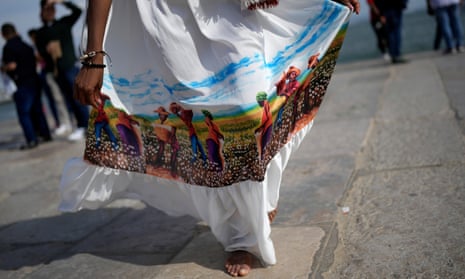
Portugal needs to ‘pay the costs’ of slavery and colonialism, says president
Critics of Marcelo Rebelo de Sousa say behind remarks is lack of national recognition that slavery should be discussed in schools
Portugal needs to “pay the costs” of slavery and other colonial-era crimes, the country’s president has said, in a rare instance of a European leader seemingly backing the need for reparations.
Portugal has long grappled with calls by campaigners to address its legacy as the European country with the longest historical involvement in the slave trade. During the span of four centuries, nearly 6 million Africans were kidnapped and forcibly transported across the Atlantic by Portuguese vessels.
Those who managed to survive the voyage were enslaved and forced to toil on plantations in the Americas , mostly in Brazil, while Portugal and its institutions profited from their labour.
The country’s president, Marcelo Rebelo de Sousa, said at an event with foreign journalists on Tuesday that Portugal “takes full responsibility” for the wrongs of the past and that those crimes, including colonial massacres, had “costs”.
“We have to pay the costs,” he said. “Are there actions that were not punished and those responsible were not arrested? Are there goods that were looted and not returned? Let’s see how we can repair this.”
The remarks came one year after Rebelo de Sousa said Portugal should apologise and “assume responsibility” for its role in the transatlantic slave trade, though he stopped short of providing any concrete details or a full apology.

In both instances, the president’s remarks were made primarily to international audiences, said Paula Cardoso, the founder of the Afrolink online platform for Black professionals in Portugal.
“Behind this international strategy is the lack of national recognition that this topic should be discussed,” Cardoso said in an email. “Kids are still learning at schools that Portugal was an excellent coloniser, that the country ‘discovered’ other countries, and that Portuguese people are so unique that they mixed with different cultures as if no violations occurred.”
She agreed on the need for reparations, arguing that Portugal must pay the costs of “being the creator of the transatlantic slave trade , of a culture of dehumanisation of Black bodies”.
She said practical actions to fight the systemic and structural racism that arose from this and that continued to colour the country today were also needed.
“We don’t even collect data on ethnicity to start with,” said Cardoso. “We are not even discussing the past, accepting that we must confront different historical narratives to consider the negative impact of the so-called Discoveries Age. So, how is Portugal taking full responsibility?”
The Portuguese president’s remarks come after the United Nations human rights chief added his voice to the African and Caribbean countries calling for amends to be made over slavery and colonisation.
after newsletter promotion
“On reparations, we must finally enter a new era,” the high commissioner for human rights, Volker Türk, said last week at a UN forum on people of African descent. “Governments must step up to show true leadership with genuine commitments to move swiftly from words to action that will adequately address the wrongs of the past.”
Between the 15th and 19th centuries, at least 12.5 million Africans were kidnapped into slavery and forcibly transported long distances by mainly European ships and merchants.
European leaders for the most part have sought to steer clear of meaningfully addressing the call for reparations. When the government of the Netherlands apologised for its role in the transatlantic slave trade in 2022, it said a €200m (£172m) fund to address this past would not be used to compensate descendants but instead spent on initiatives such as education and addressing the present-day impacts of slavery. Germany has been chastised for excluding the ethnic minorities who were murdered by the tens of thousands from talks over reparations. Speaking to reporters on Tuesday, Rebelo de Sousa said he believed that acknowledging the past and taking responsibility for it was more important than apologising. “Apologising is the easy part,” he said.
Additional reporting by Reuters
- Colonialism

France urged to repay billions of dollars to Haiti for independence ‘ransom’

‘Hidden in plain sight’: the European city tours of slavery and colonialism

EU must face legacy of colonialism and support reparations, say MEPs

Europe’s hollow apologies for colonial crimes stand in the way of true reparation

African and Caribbean nations agree move to seek reparations for slavery

King Charles’s ‘deep regret’ for colonial atrocities was a ‘miss’, Kenyans say

King Charles stops short of apology for ‘abhorrent’ colonial violence in Kenya

King Charles asked for ‘unequivocal apology’ by Kenya’s rights commission
Most viewed.

IMAGES
VIDEO
COMMENTS
Slow Travel in Portugal. Go, wander, get lostPortugal is a perfect destination all year round. But to truly experience the soul of Portugal, it is essential to slow down and take the time to explore the country's hidden gems and lesser-known regions.Just let yourself go and (...) Find out more.
Start planning your itinerary now with our 11 favorite places to visit in Portugal. 1. Lisbon. Best for nightlife. Seven iconic hills overlook Lisbon 's postcard-perfect panorama of cobbled alleyways, white-domed cathedrals and grand civic squares - a captivating scene crafted over centuries.
Portugal is generally a safe country to visit with a low overall crime rate - violent crime is extremely rare. Pickpocketing and bag-snatching are the main concerns to keep in mind, especially when traveling on the trams and metro in Lisbon or Porto. Avoid moving around during the crowded peak times, and don't zone out on your phone.
Portugal: your next travel destination. Portugal has 7 regions, which means that it has a lot to visit and discover, but there are more reasons to make it a good choice and to be on the list of trips to do in life. The country's history and culture, gastronomy and wines, are among the main attractions, not to mention the beaches, surfing ...
Things to Do in Portugal, Europe: See Tripadvisor's 7,908,372 traveler reviews and photos of Portugal tourist attractions. Find what to do today or anytime in May. ... There are free and paid guided tours available in the ticket, as well as regular free demos for the camera obscura which provides 360º detailed views of the city in real-time ...
Europe. Medieval castles, cobblestone villages, captivating cities and golden beaches: the Portugal experience can be many things. History, great food and idyllic scenery are just the beginning. Best Time to Visit. Best Places to Visit.
Plan Your Trip to Portugal: Best of Portugal Tourism About Portugal Portugal's Mediterranean charm is most prominent on the golden beaches of the Algarve; in the wilderness of the Azores islands; among the vineyards of Douro Valley; and on the cobbled streets of Lisbon and Porto, where old-world culture meets cosmopolitan bars and restaurants.
2. Oceanário de Lisboa, Lisbon. Arguably Portugal's most popular and family-friendly visitor attraction, Lisbon's oceanarium is brilliantly conceived to highlight the world's diverse ocean habitats. This is one of Europe's best and largest oceanariums, containing a vast array of fish and marine animals.
Tourism in Portugal serves millions of international and domestic tourists. Tourists visit to see cities, historic landmarks, enjoy beaches, or religious sites. As of 2019, Portugal had 27 million visitors. [1] [2] The most popular destinations were Lisbon, Porto, the Algarve, the Portuguese Riviera, Madeira, Sintra, Óbidos and Fátima.
1. Go beyond the most famous Portuguese destinations. We'll start with the basics: when planning your trip to Portugal, remember that there's a lot to see beyond the coastal hotspots of Lisbon, Porto, and the Algarve.. Portugal is a (satisfyingly rectangular) country composed of 18 districts and two autonomous regions, with a myriad of places to visit beyond the most frequented, from its ...
20 Beautiful Places to Visit in Portugal — From Fairy-tale Castles to Charming Beach Towns. Take your pick of hilltop castles, sunny beaches, and time-worn villages.
Best 10 Day Portugal Itineraries 2024/2025 (With Reviews) Discover the Best Portugal Vacation Packages 2024/2025. TourRadar has the best selection of tours for discovering Lisbon, Porto and the Algarve, as well as less famous spots such as Sintra and Cascais. Whatever your preferred style of adventure, we've got you covered!
By Paula from Portugal Travel Hub. Explore the old town in Obidos. The beautiful town of Obidos is a must-see in Portugal. Only an hour's drive away from bustling Lisbon (making it a great spot on a Portugal road trip), the sweet, fairytale village of Obidos is a must-see in Portugal. The town is still surrounded by fortified walls and was ...
Highlights of Portugal. Jill · Traveled March 2024. I recommend Intrepid and this tour; a mix of smaller cities, mountain villages, and a big city. Something for everyone! The pace was great, with an introductory walking tour of each place, followed by plenty of free time to explore. The leader was exceptional in her organization, enthusiasm ...
New Board of Directors of Turismo de Portugal. Presentation of the Tourism Agenda for the Inland Territory presented in Covilhã. Portugal elected for the WTO's Statistics and Sustainability Committees (2023-2027) First "Michelin Star Revelation Gala - Portugal" will be held in the Algarve in 2024. Dental clinics can join the Medical Tourism ...
Heart of Portugal in 12 Days Tour. from $3,895 per person + air. Single Supplement $825. See Dates & Prices. Starting in lively Lisbon and ending in proud Porto, our Heart of Portugal tour combines a dazzling mix of Roman, Moorish, and Baroque architecture with the small towns, coast, food, wine, and music of this tradition-rich country.
Here are some of the most popular tourist attractions in Portugal: 1. Lisbon: Portugal's capital city, Lisbon, is a vibrant and charming destination. Highlights include the historic neighbourhood of Alfama, the iconic Belém Tower, the Jerónimos Monastery, and the lively Baixa district.
11 Day Portugal Tour to Lisbon, Algarve and Porto. This Best of Portugal journey reveals a nation's proud history, warm-hearted locals and soul-warming cuisine. Starting in Lisbon, you'll travel north and south to explore a Templar stronghold, watch thoroughbreds perform at an Alentejo farm and visit the Algarve.
Best of Portugal (11 Days) WILLIAM KOSTUK 27 Mar, 2024. 5. Our guide Cristina And driver Fernando were both exceptional, friendly, knowledgeable and our pleasure to be with as traveled some 2500 km through Portugal. Best of Portugal. Find the right Portugal Fully Guided tour for you with TourRadar. Choose from 253 trips with 5119 customer reviews.
With its commitment to preserving its natural environment, Sete Cidades serves as an excellent destination for eco-tourism and sustainable tourism in Portugal. Douro International Nature Park, Tres1416, Public domain, via Wikimedia Commons. 9. Enjoy a Portugal farm experience at the Douro International Natural Park.
Rede de Escolas do Turismo de Portugal celebra os 50 anos do 25 de abril. Candidaturas abertas aos Prémios Europeus Green Capital e Green Leaf 2026 - até 30 abr 2024. Turismo de Portugal nomeado para os Prémios Human Resources 2024. Votações até 17 mai 2024!
Inbound tourism volume in Portugal 2019-2023, by destination region. Number of international visitors in Portugal from 2019 to 2023, by region of destination (in 1,000s) Overnight stays by inbound ...
Homepage | www.visitportugal.com
Best Things To Do in Porto Portugal. Porto is… a city torn between the currents of time. On one hand, is firmly rooted in the past with its history and culture in full display. On the other hand ...
Caminha is located in the northwest along the mouth of the Minho River, which separates Portugal from Spain. International Living ranked Caminha first in Europe for its real estate value, quality ...
On 25 April Portugal celebrates 50 years of democracy. Since its 1974 revolution, it has embraced freedom of the press, free elections, and the right to healthcare, to strike and to education. But ...
Mother's Day Gift Guide 2024: The Best Spa Getaways For Moms Who Travel. Apr 24, 2024, 08:47am EDT. ... Portugal's Madeira Island Is Going Glam—Thanks To This New Luxury Hotel.
Guests can partake in guided tours of the expansive vineyards, state-of-the-art winemaking facilities, and underground wine cellar, or experience winemaking firsthand by blending their own wine ...
Portugal is a European country that expats and tourists often choose to visit. It is known for its lively culture, stunning beaches and delicious food. ... He said thanks to "tourist trap" restaurants, expats are often charged more to try bad, unauthentic cuisine. The expat, Dave, shared advice on what "not to do" in Lisbon if you "don't want ...
Portugal needs to "pay the costs" of slavery and other colonial-era crimes, the country's president has said, in a rare instance of a European leader seemingly backing the need for reparations.